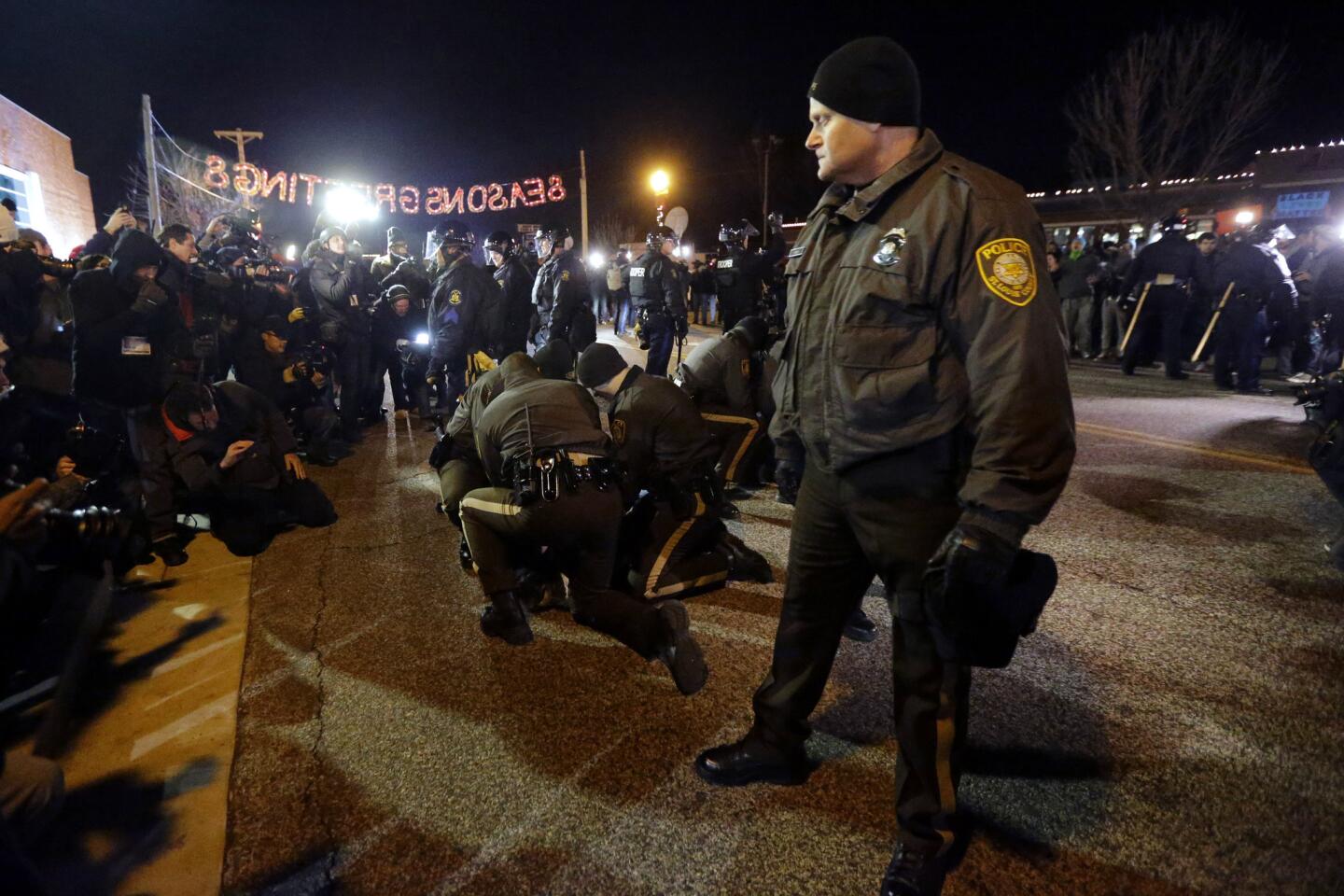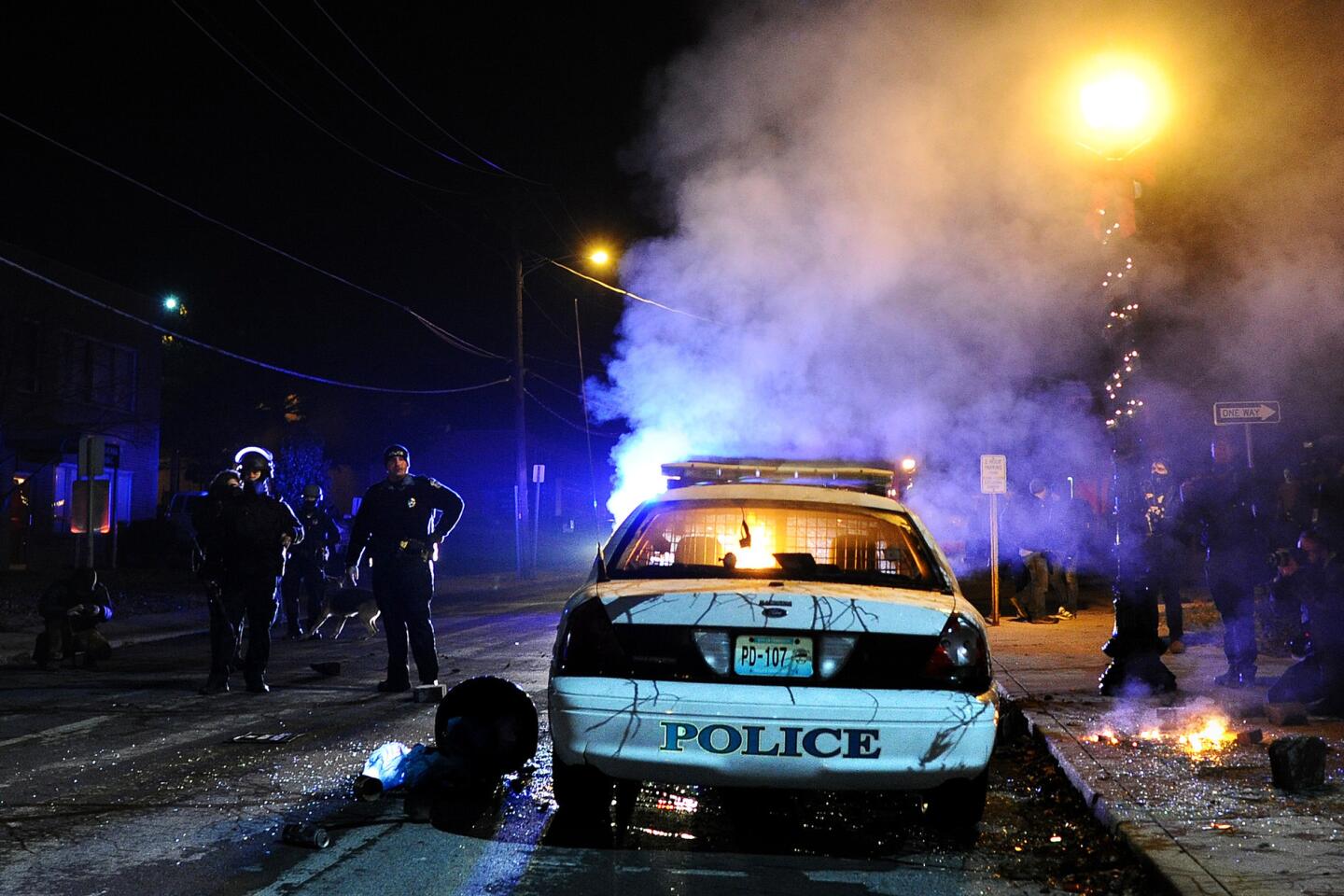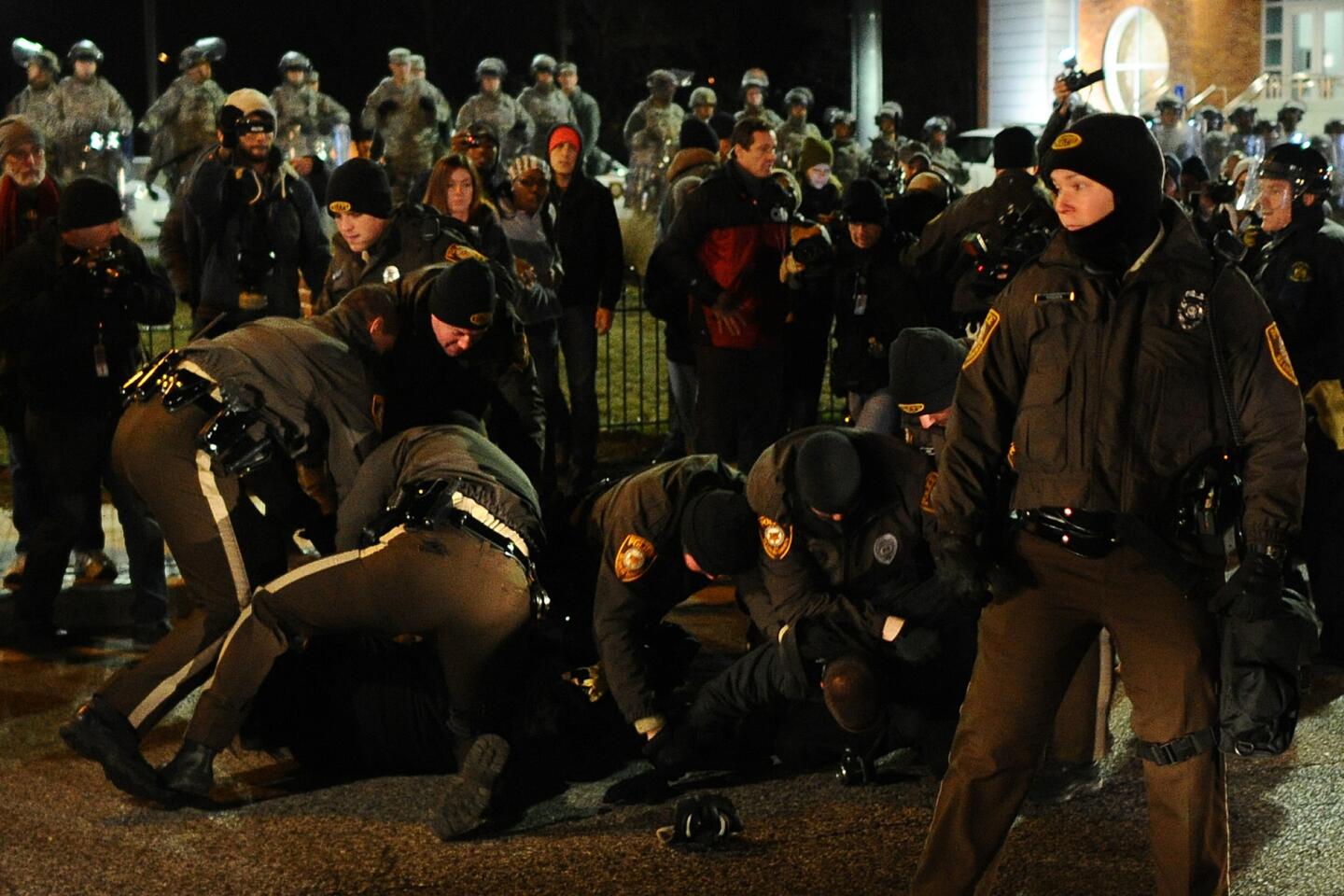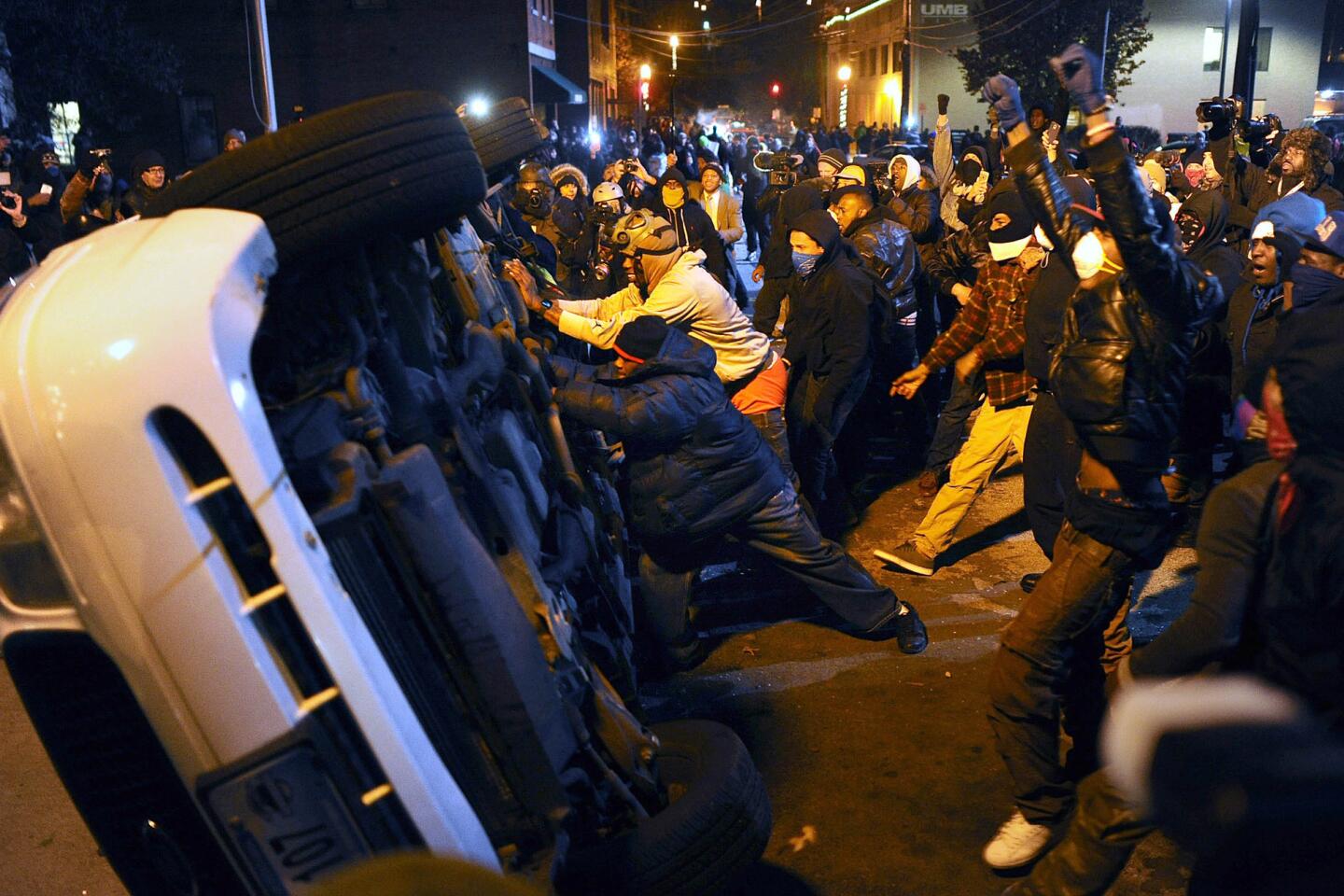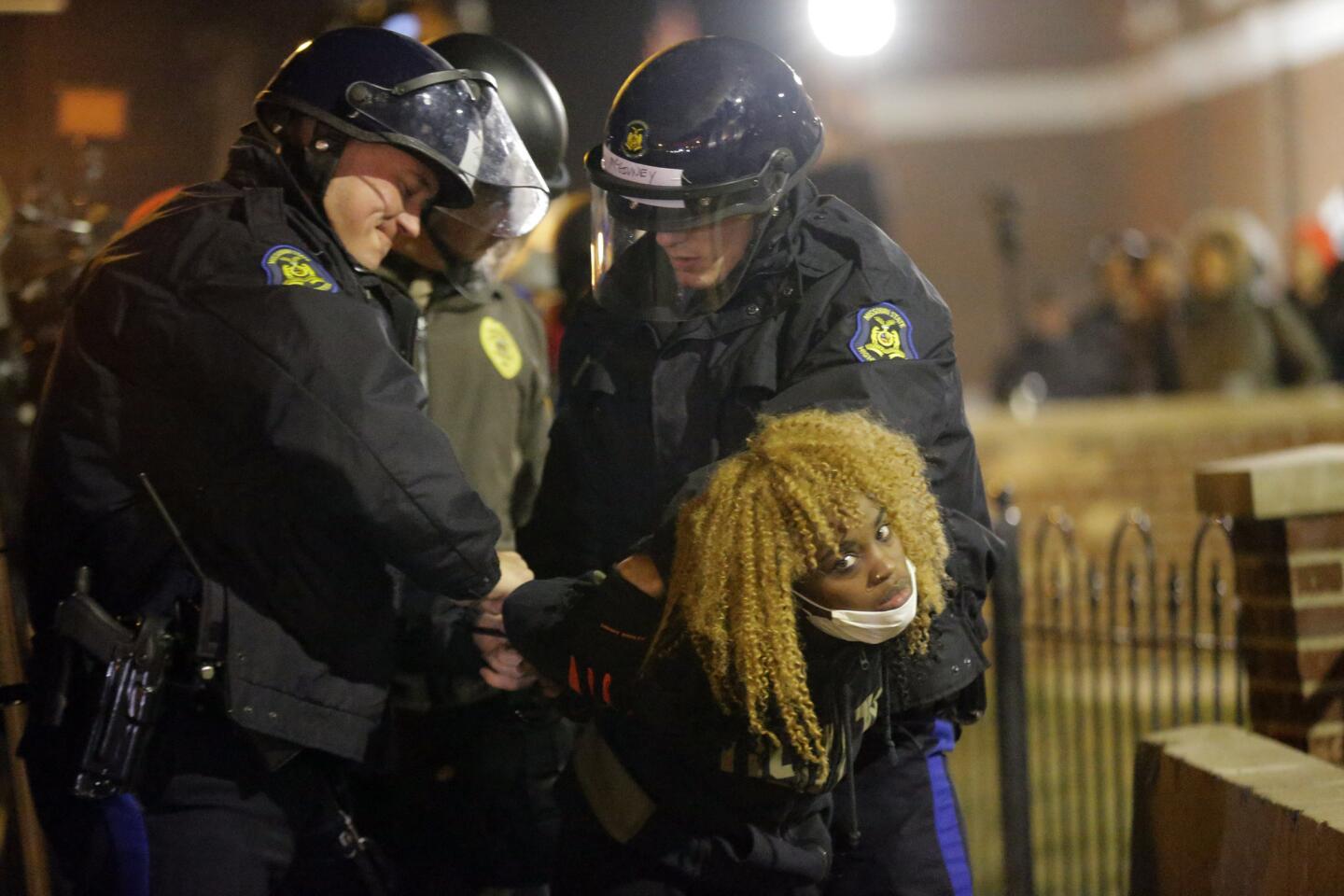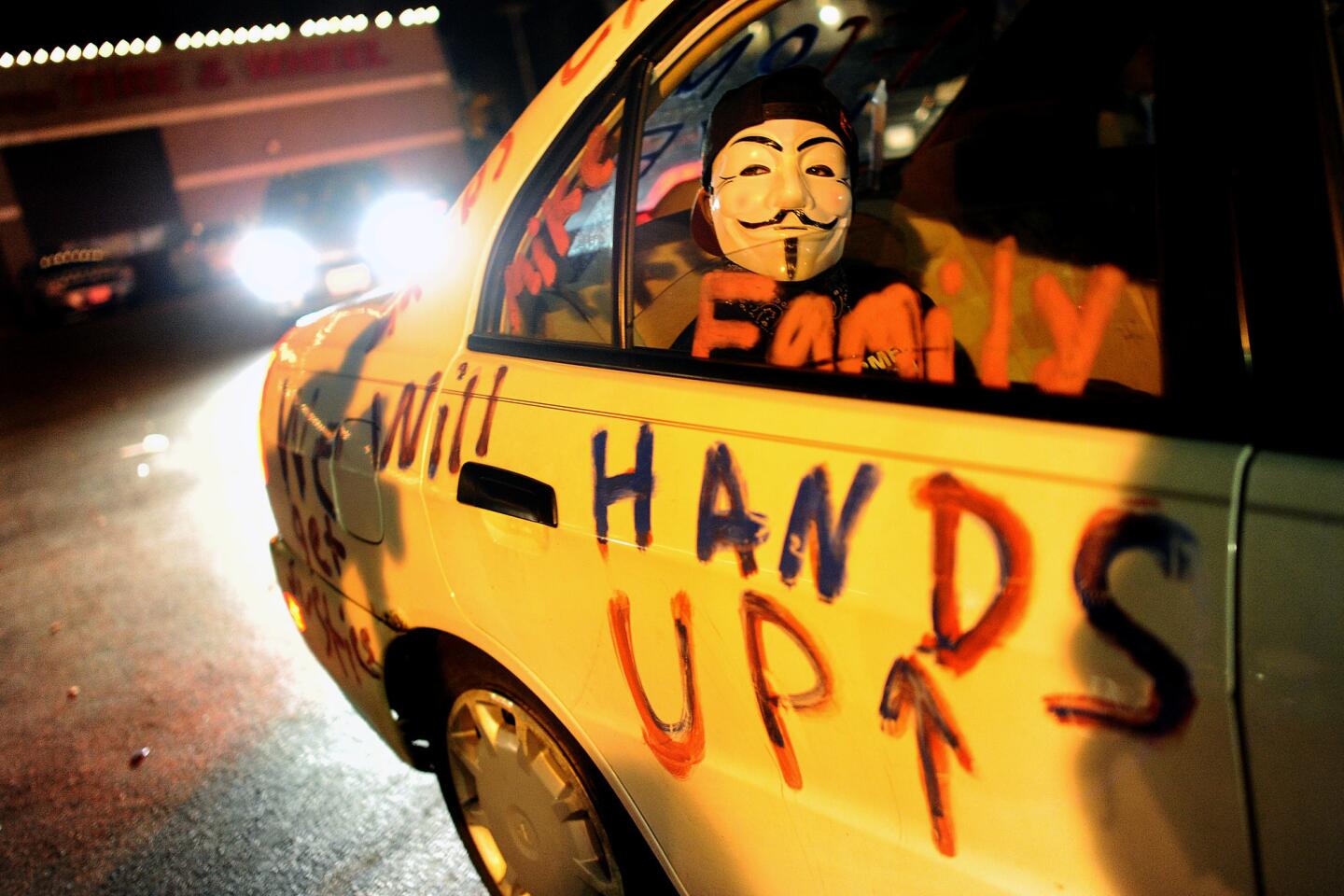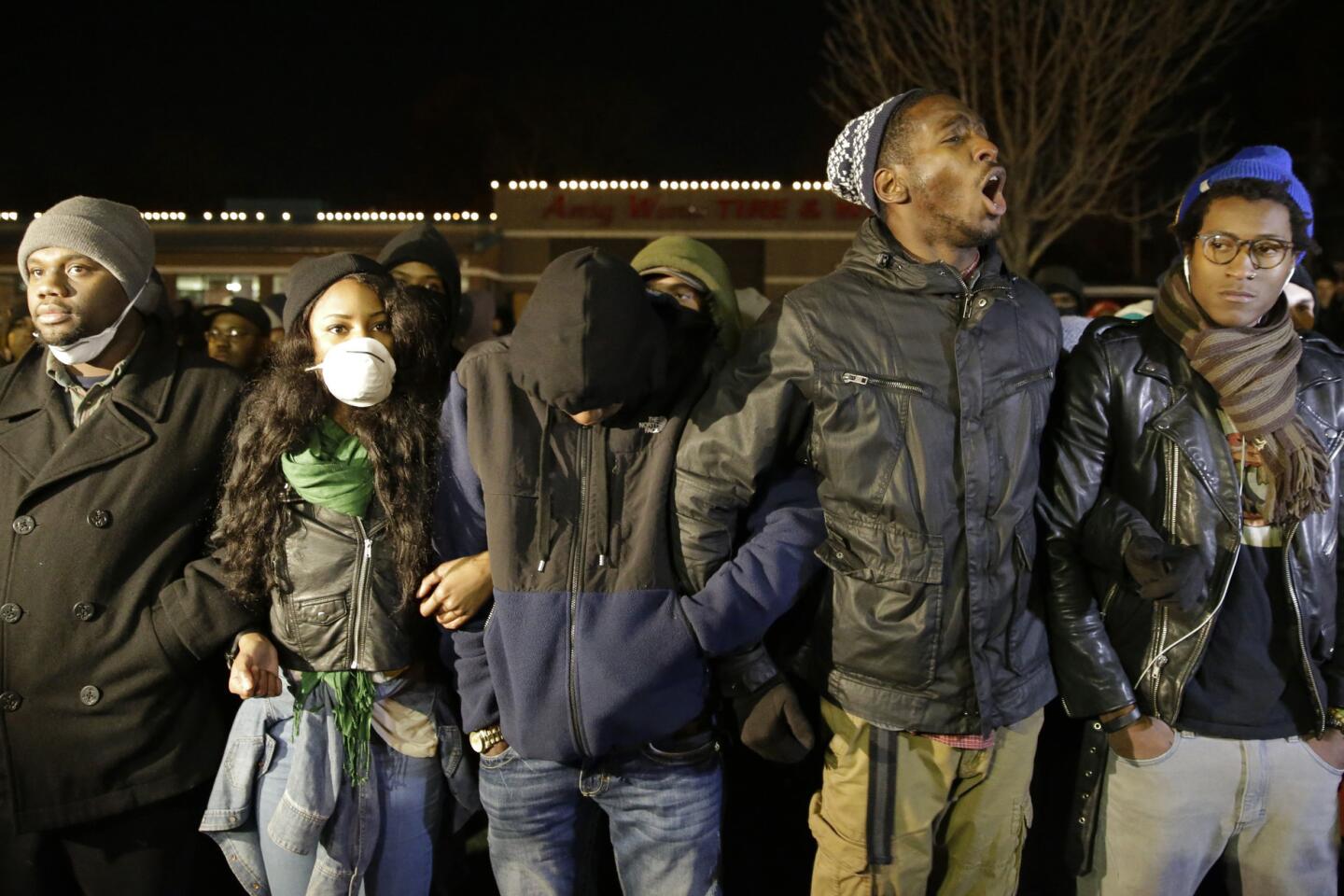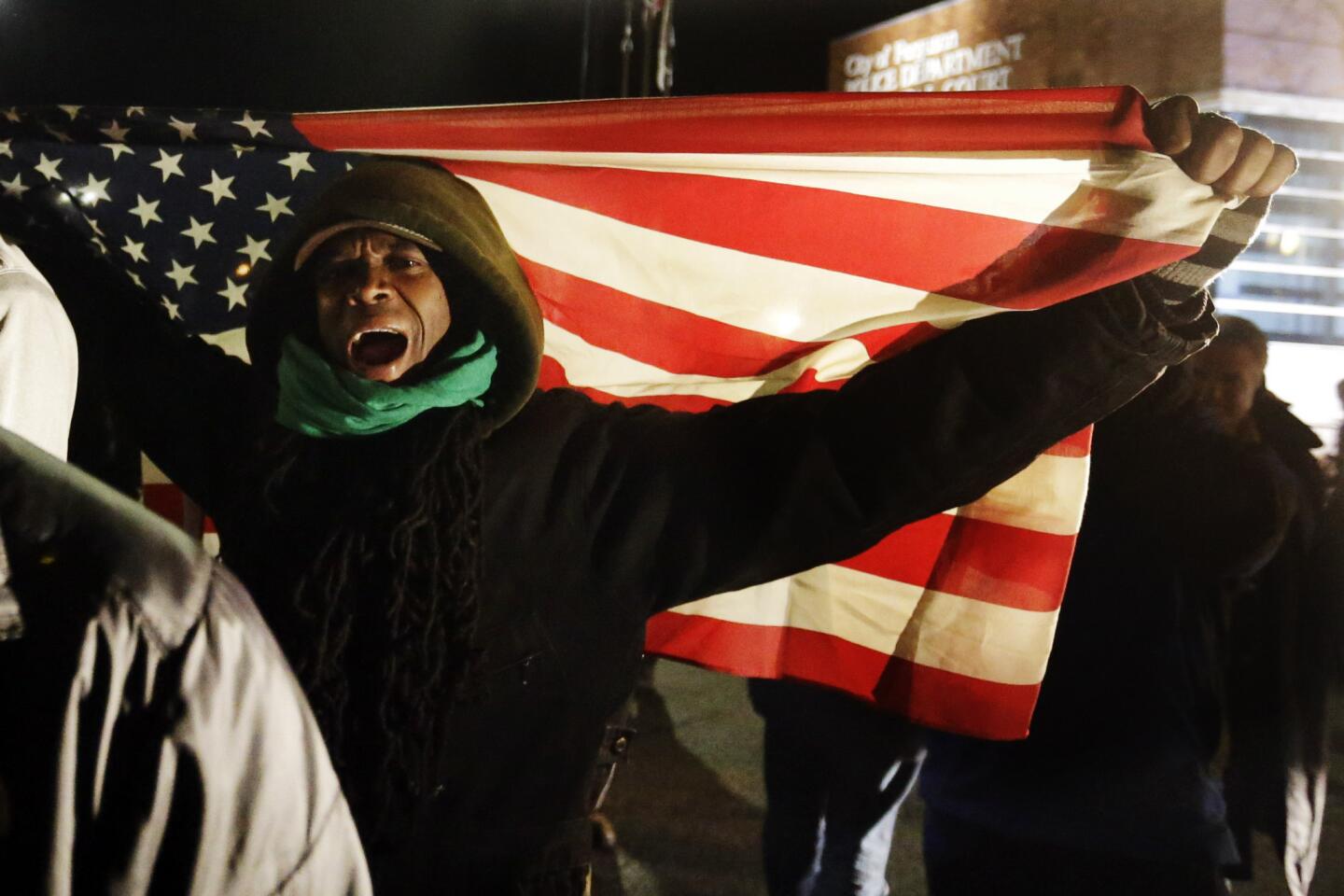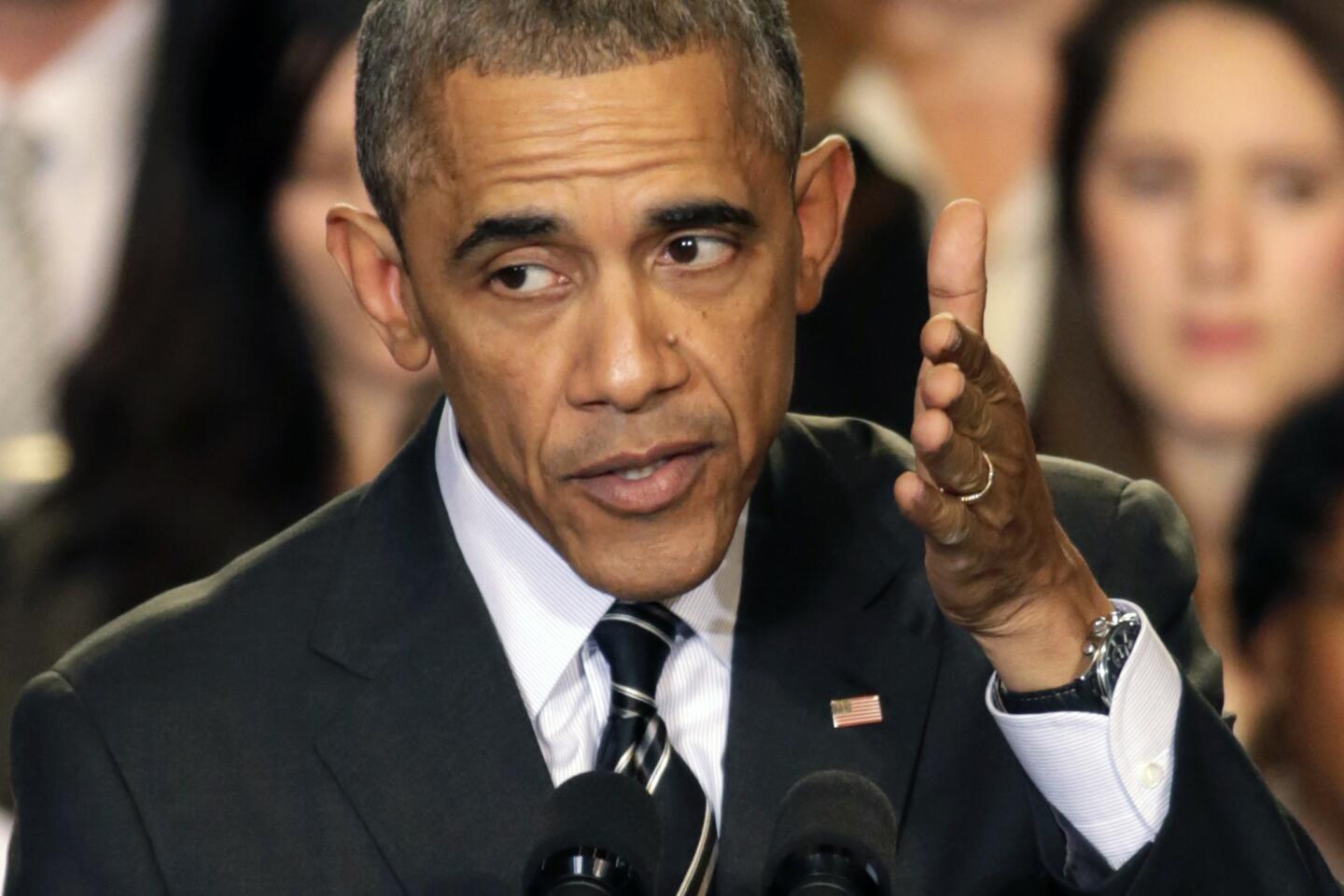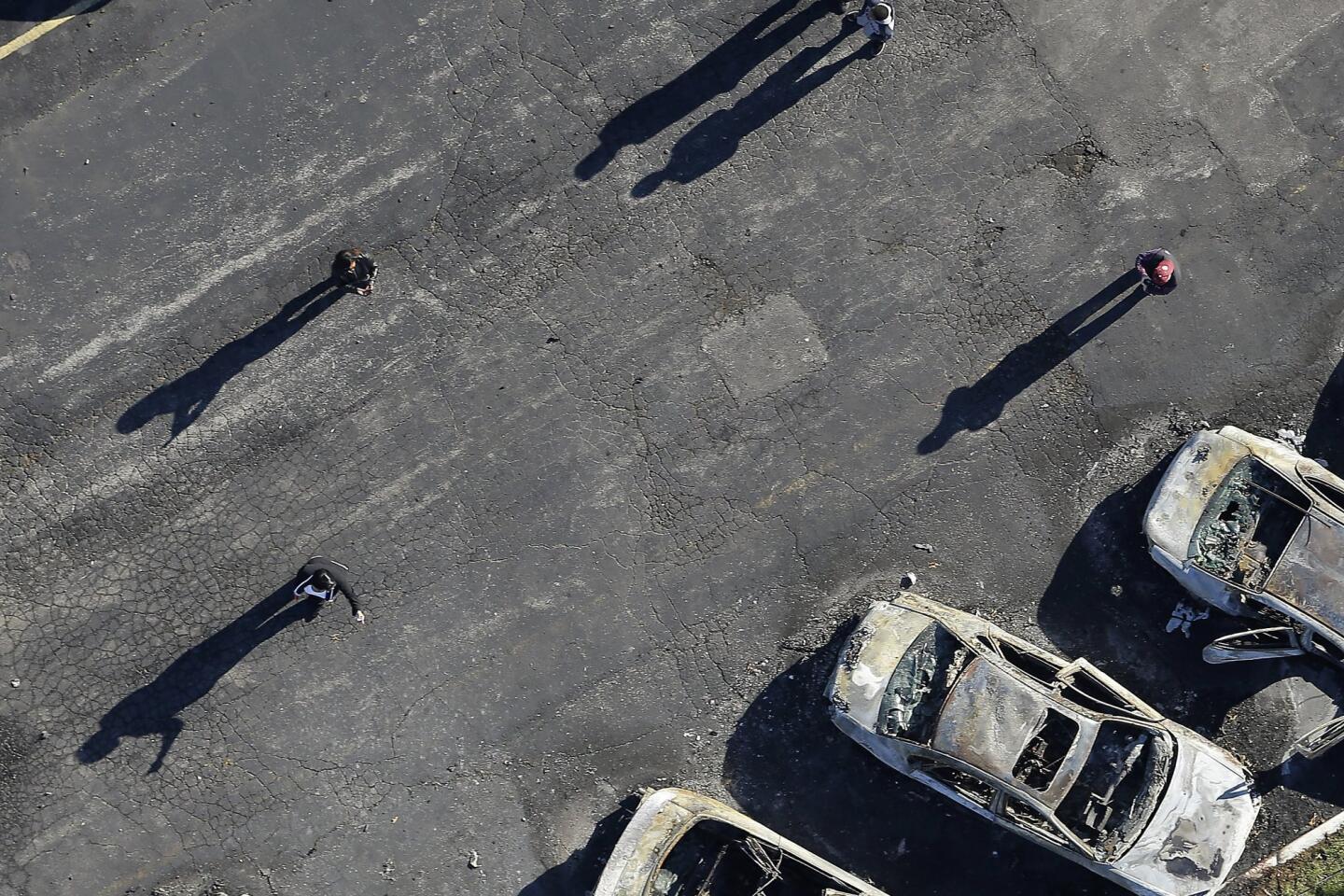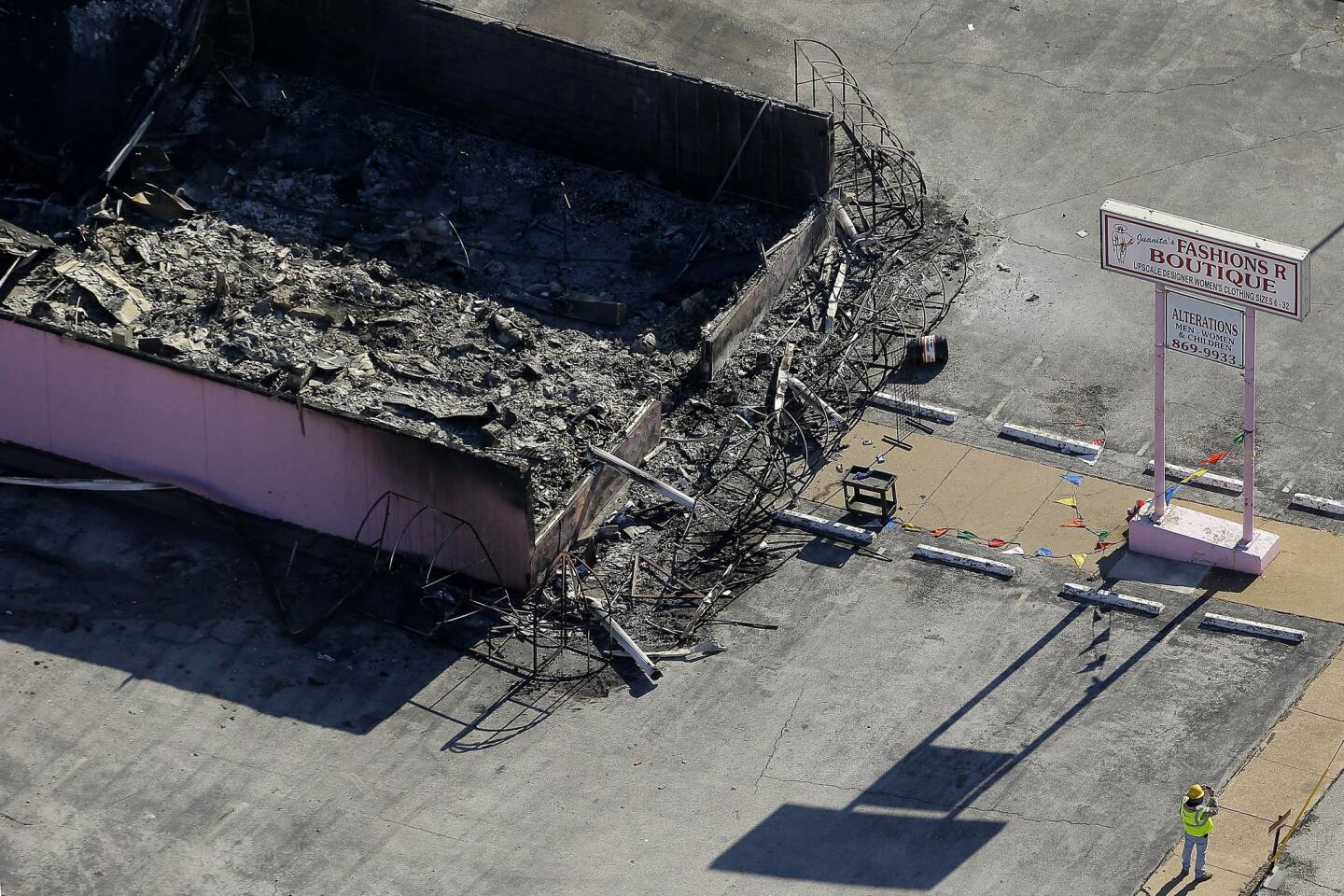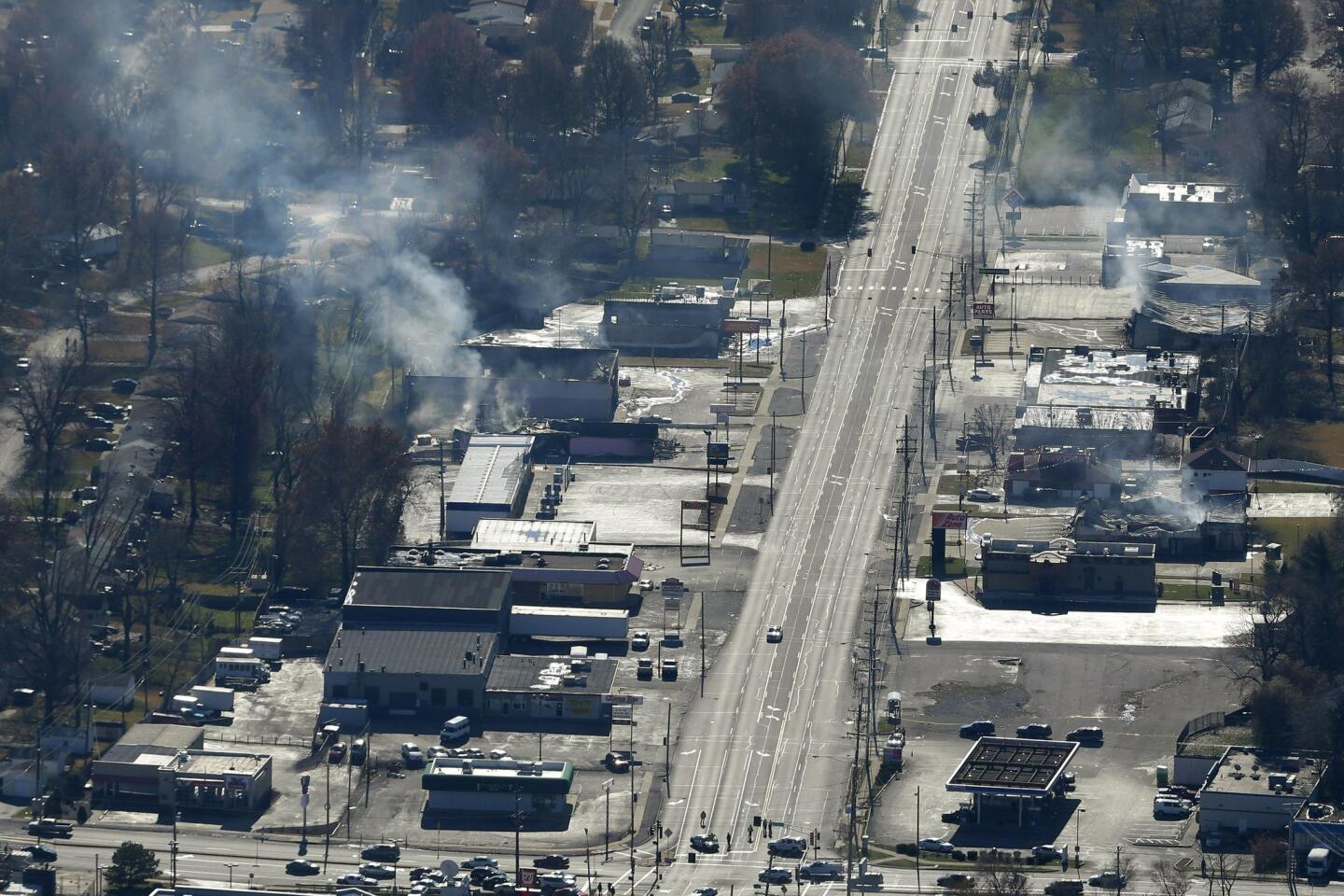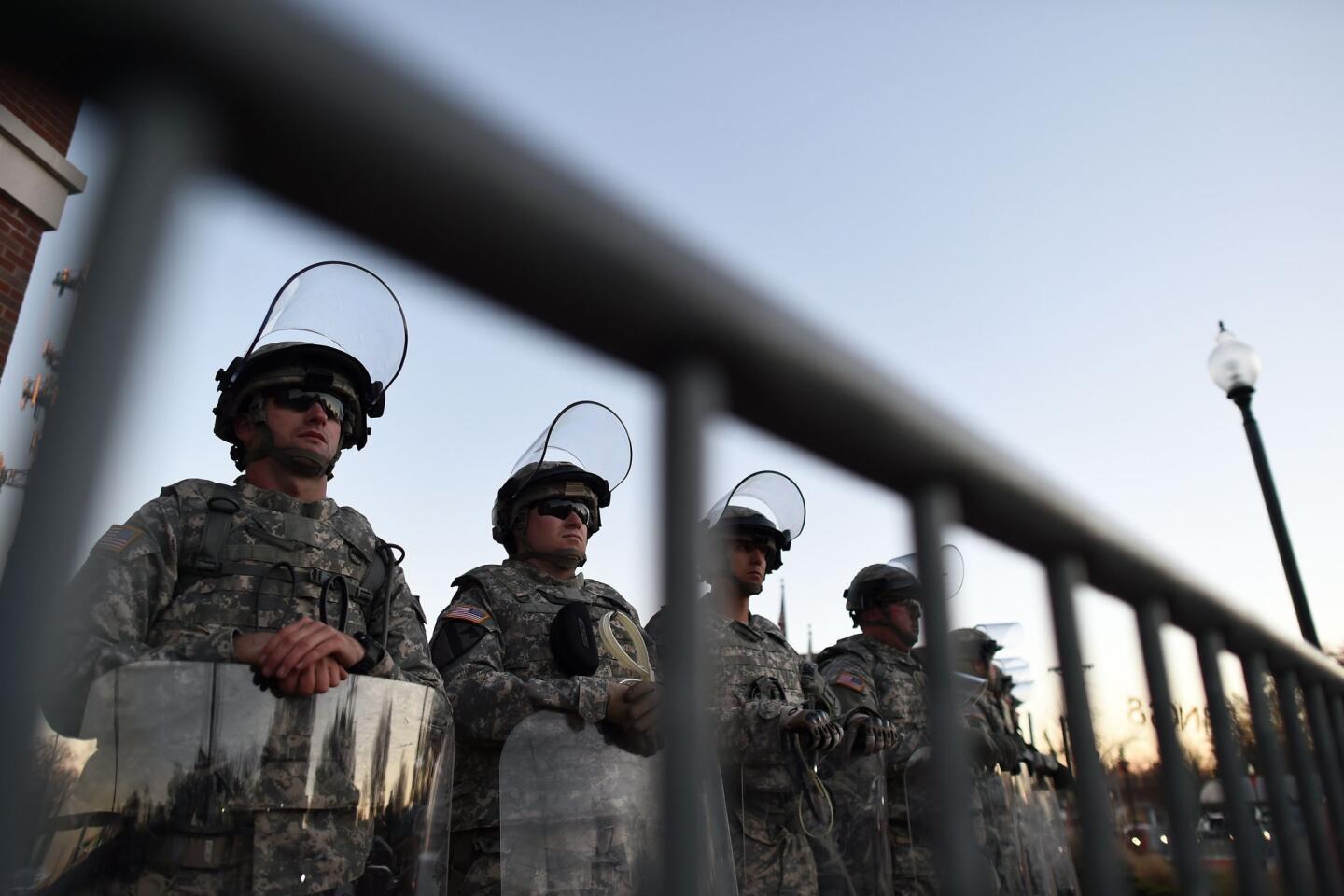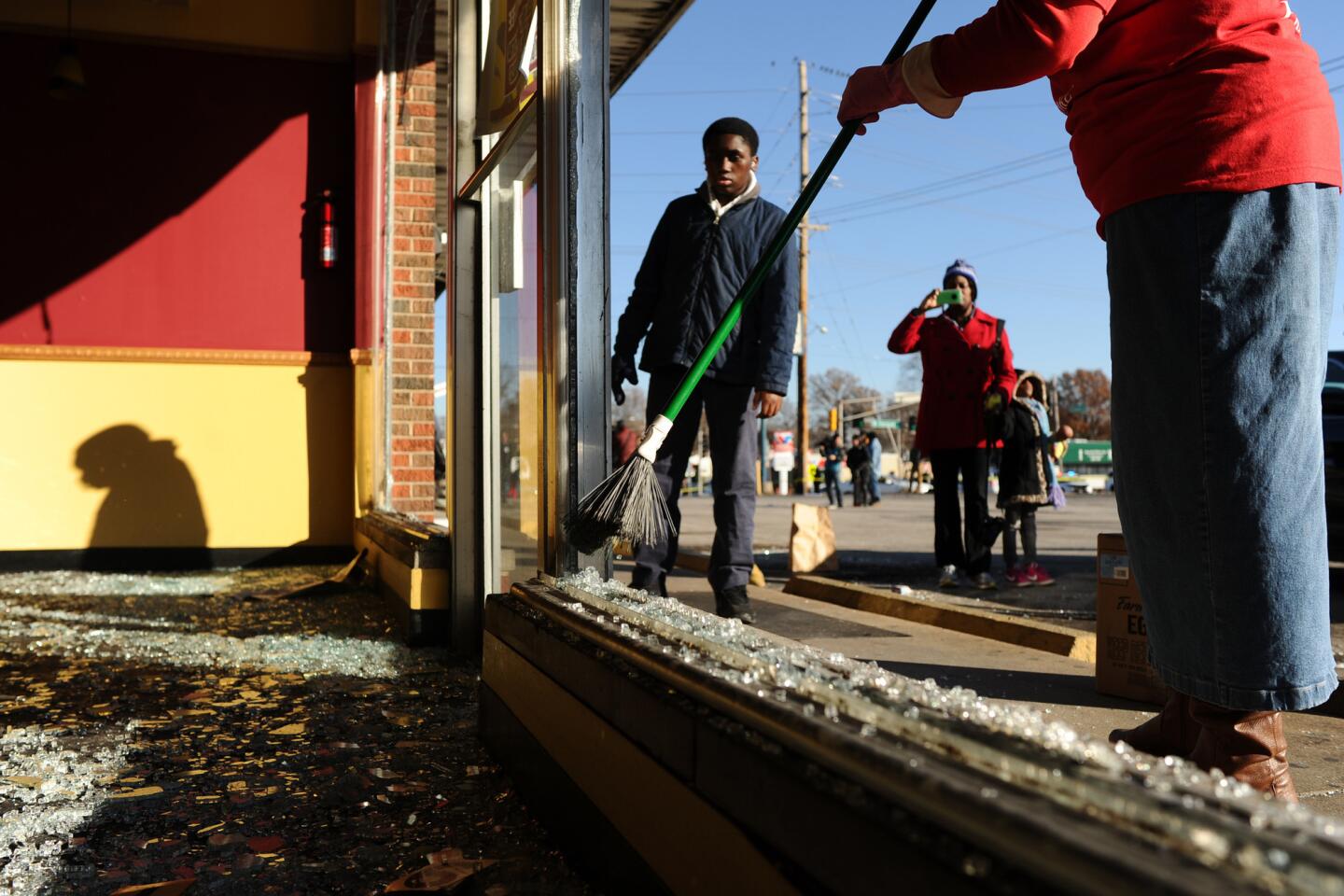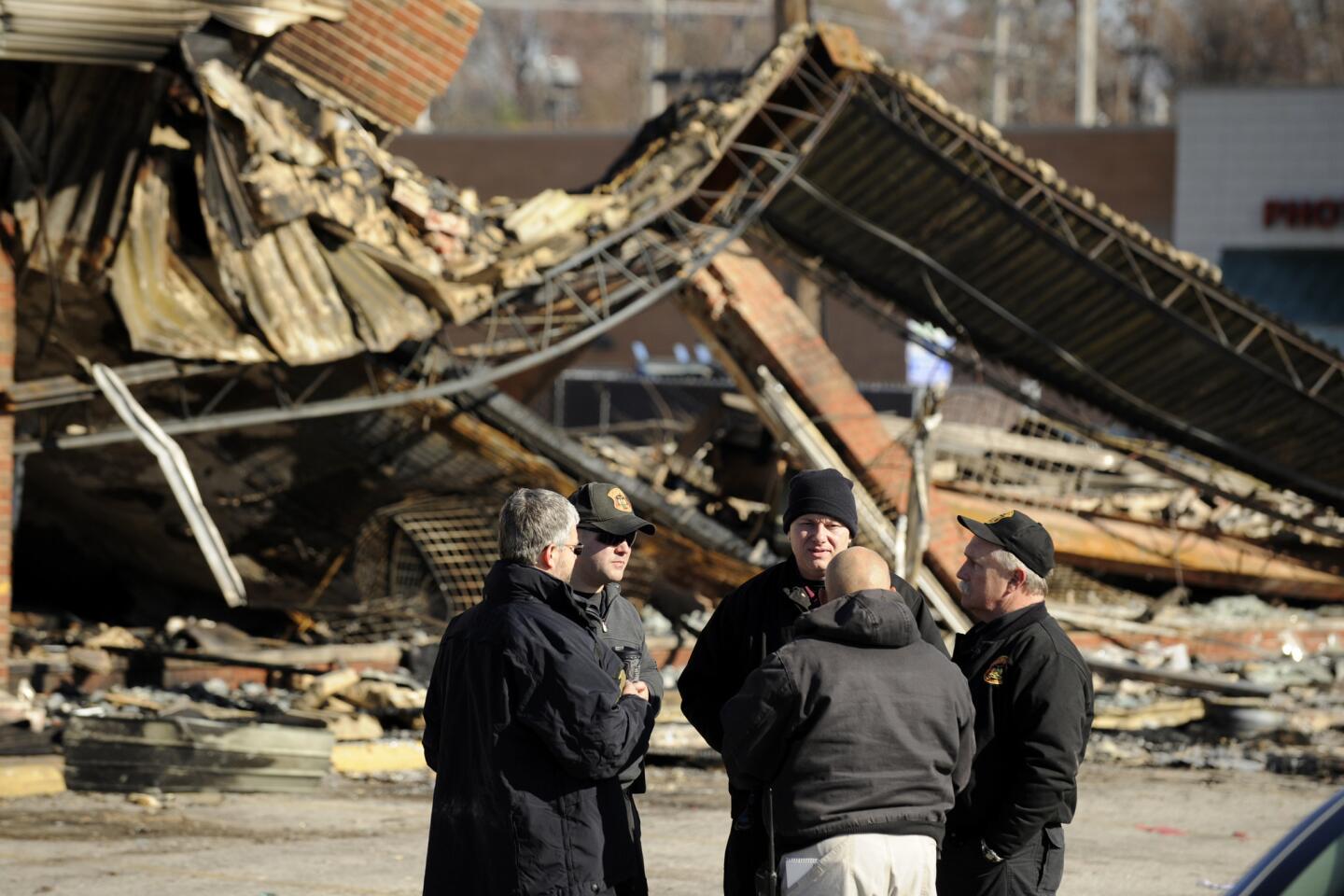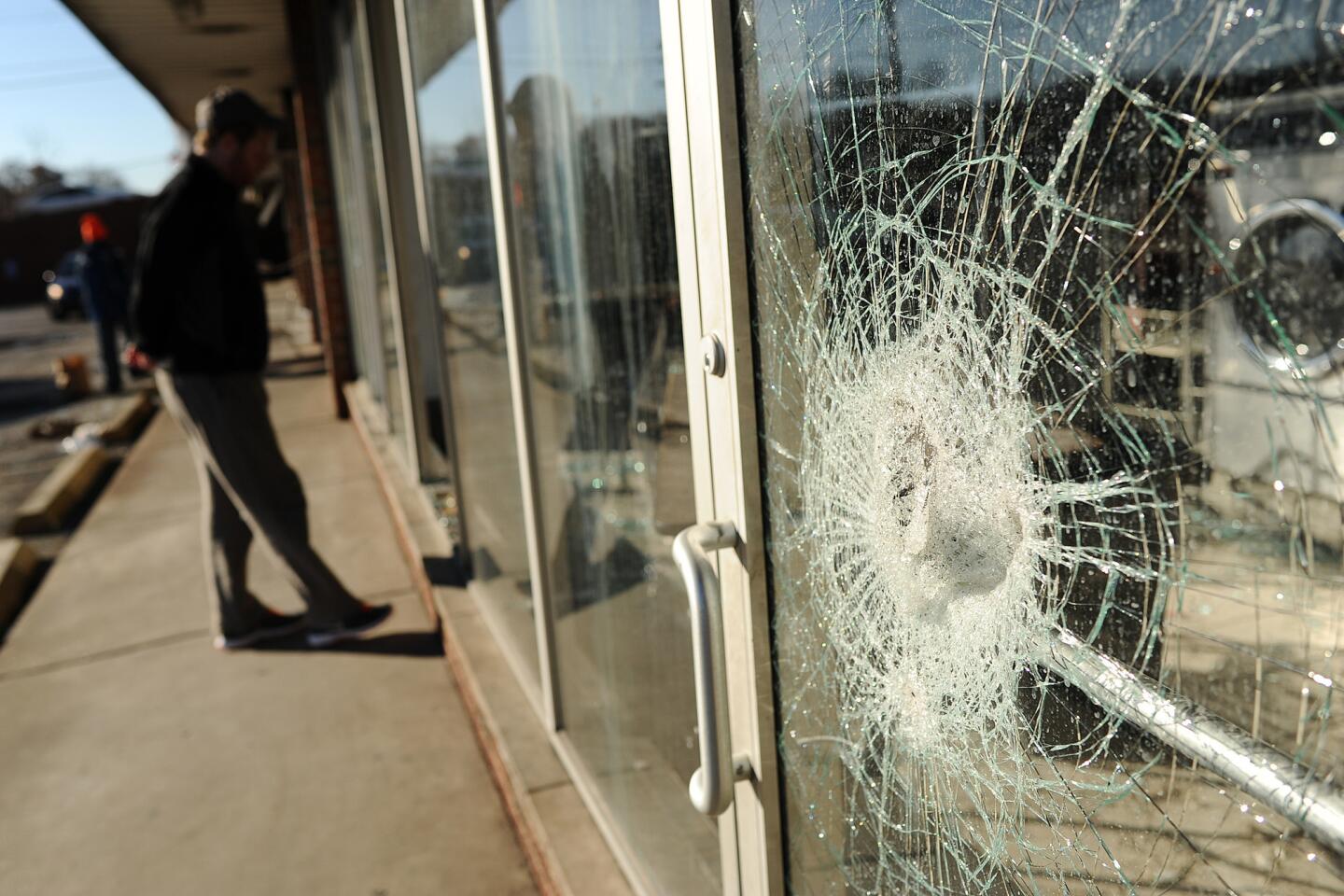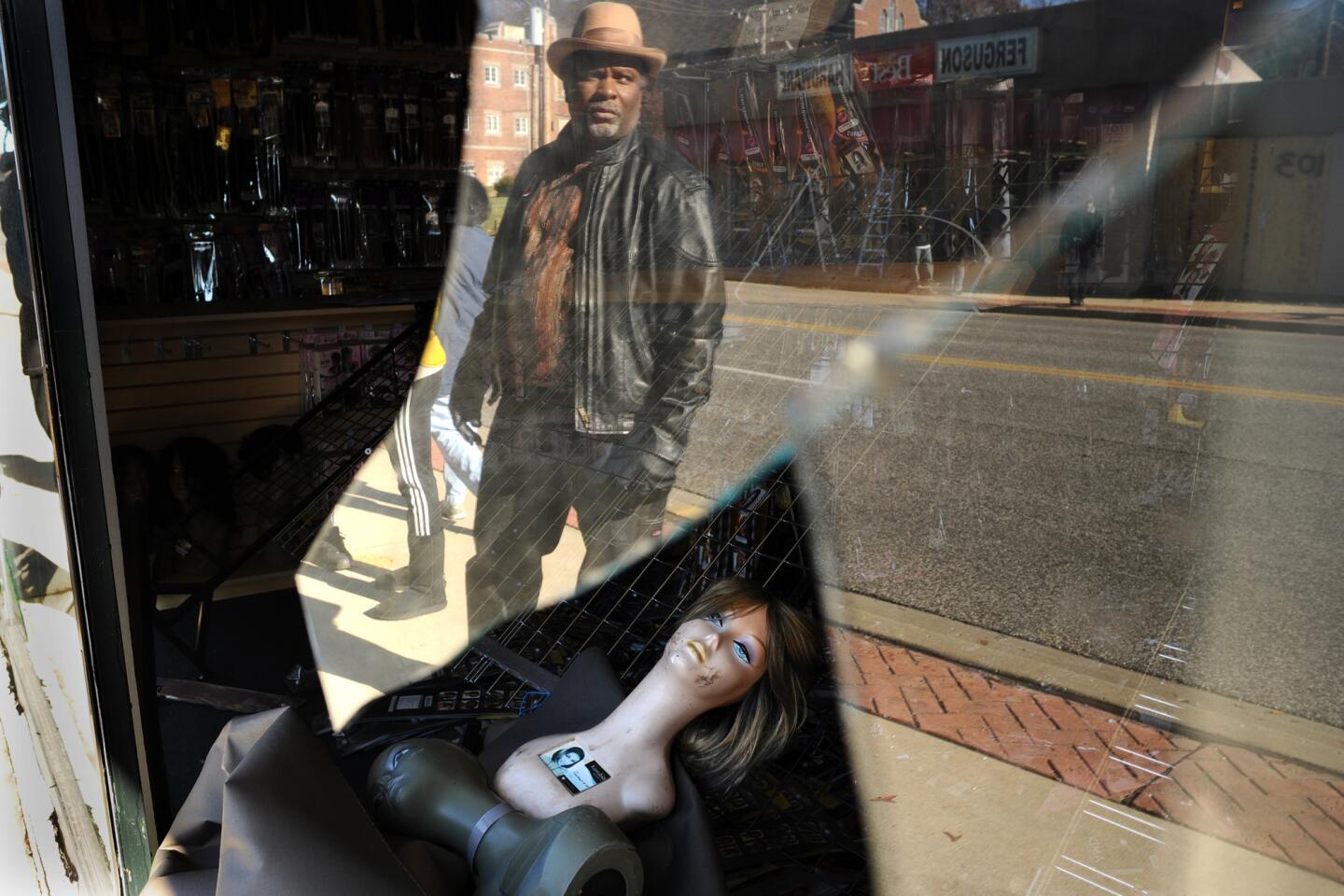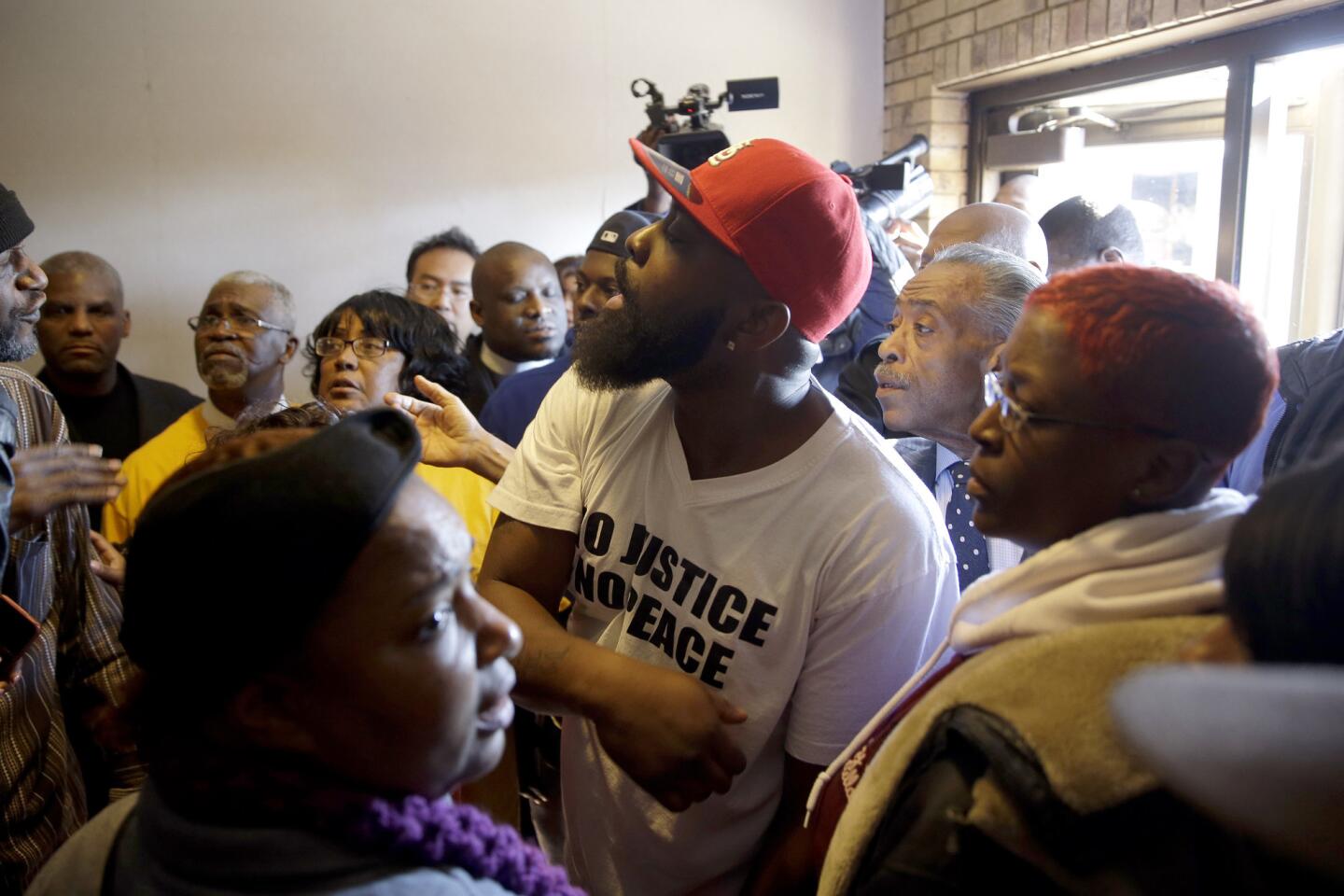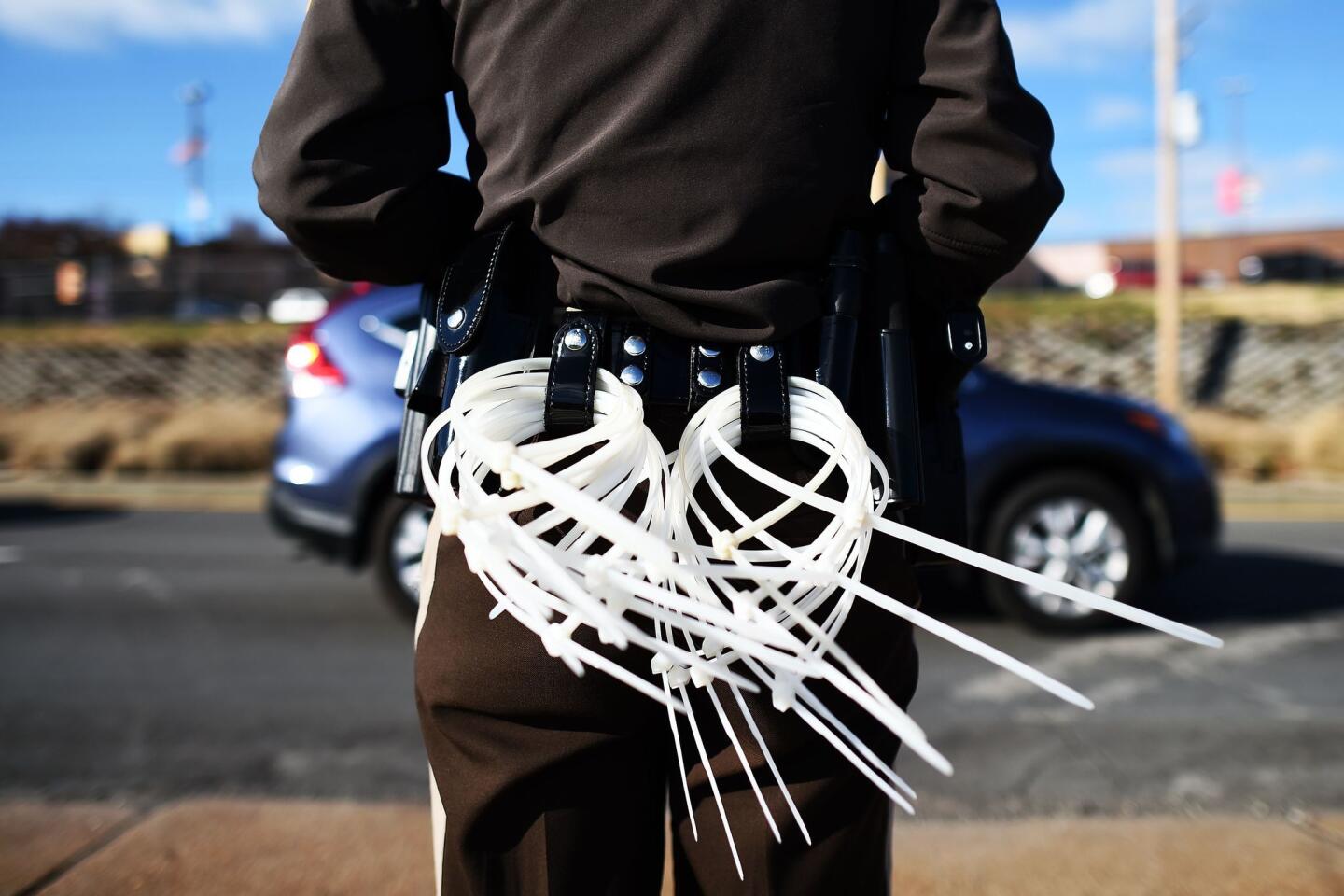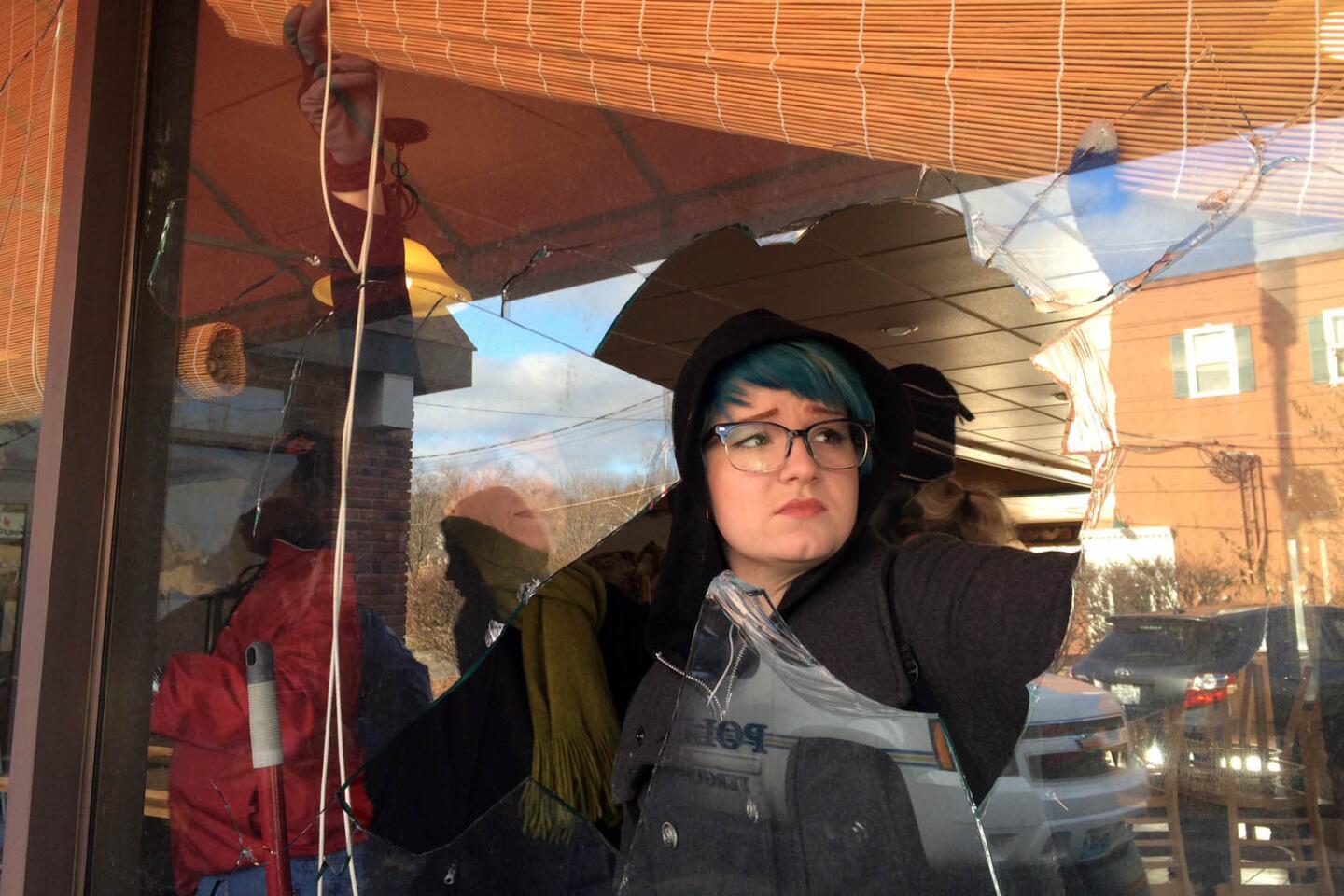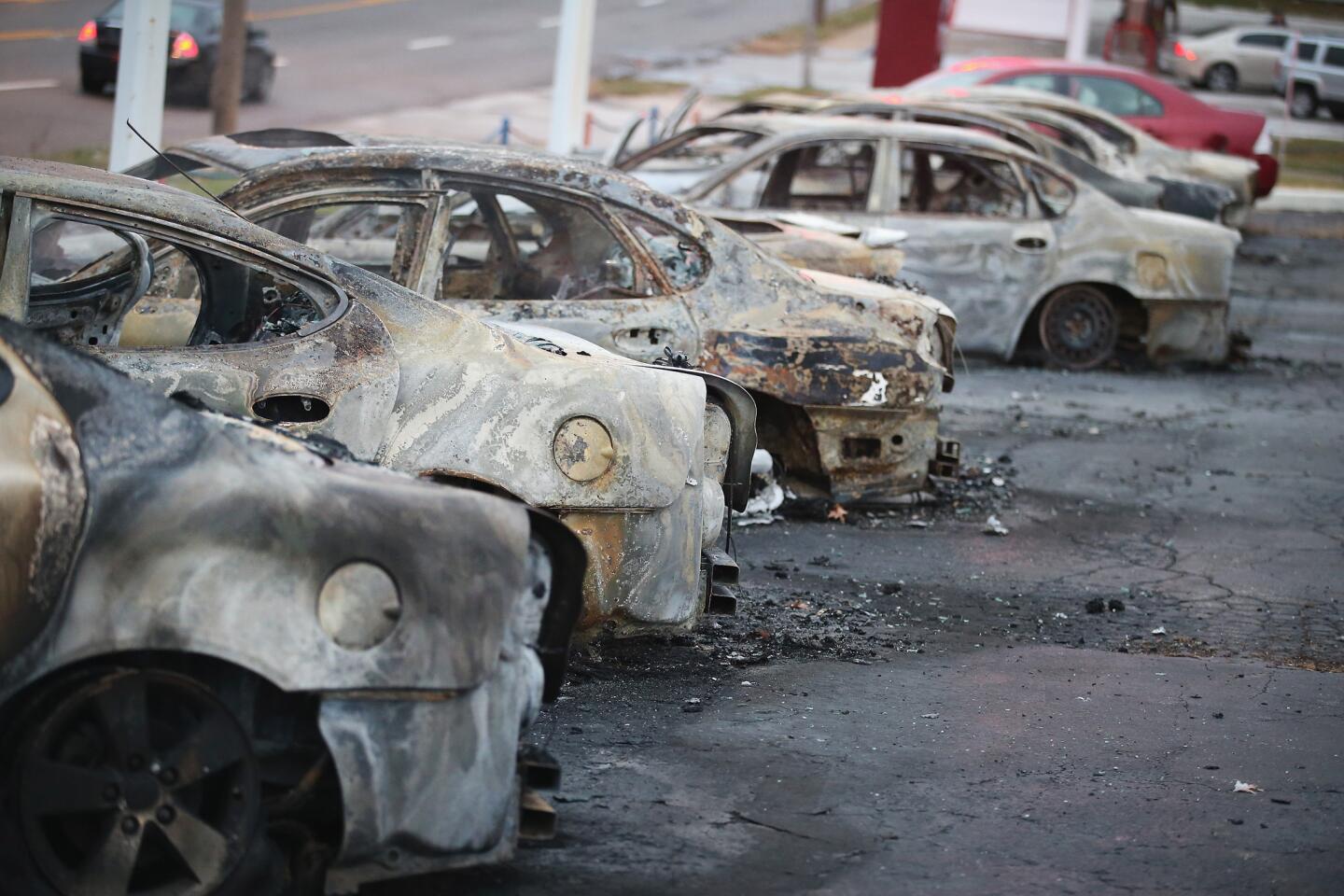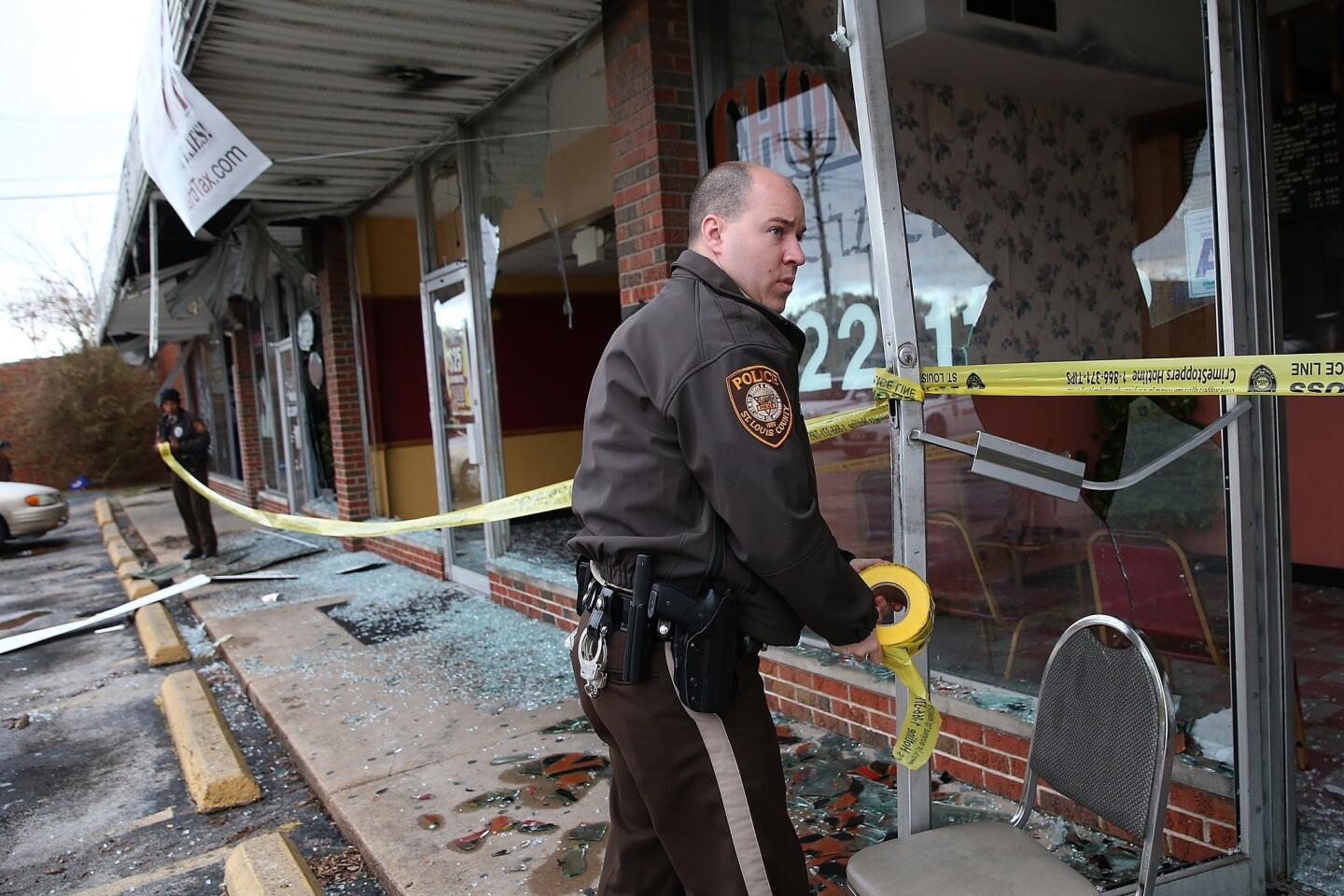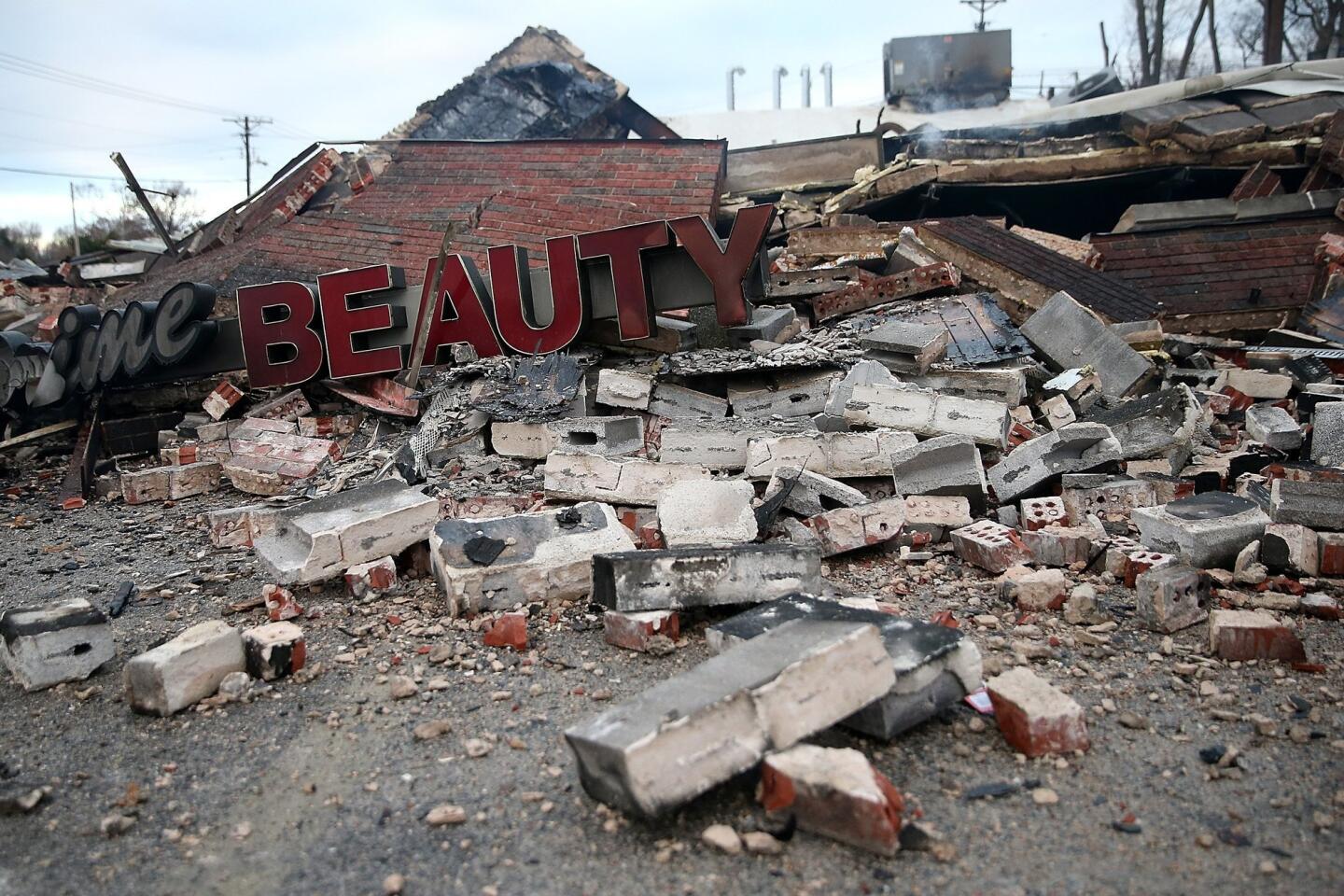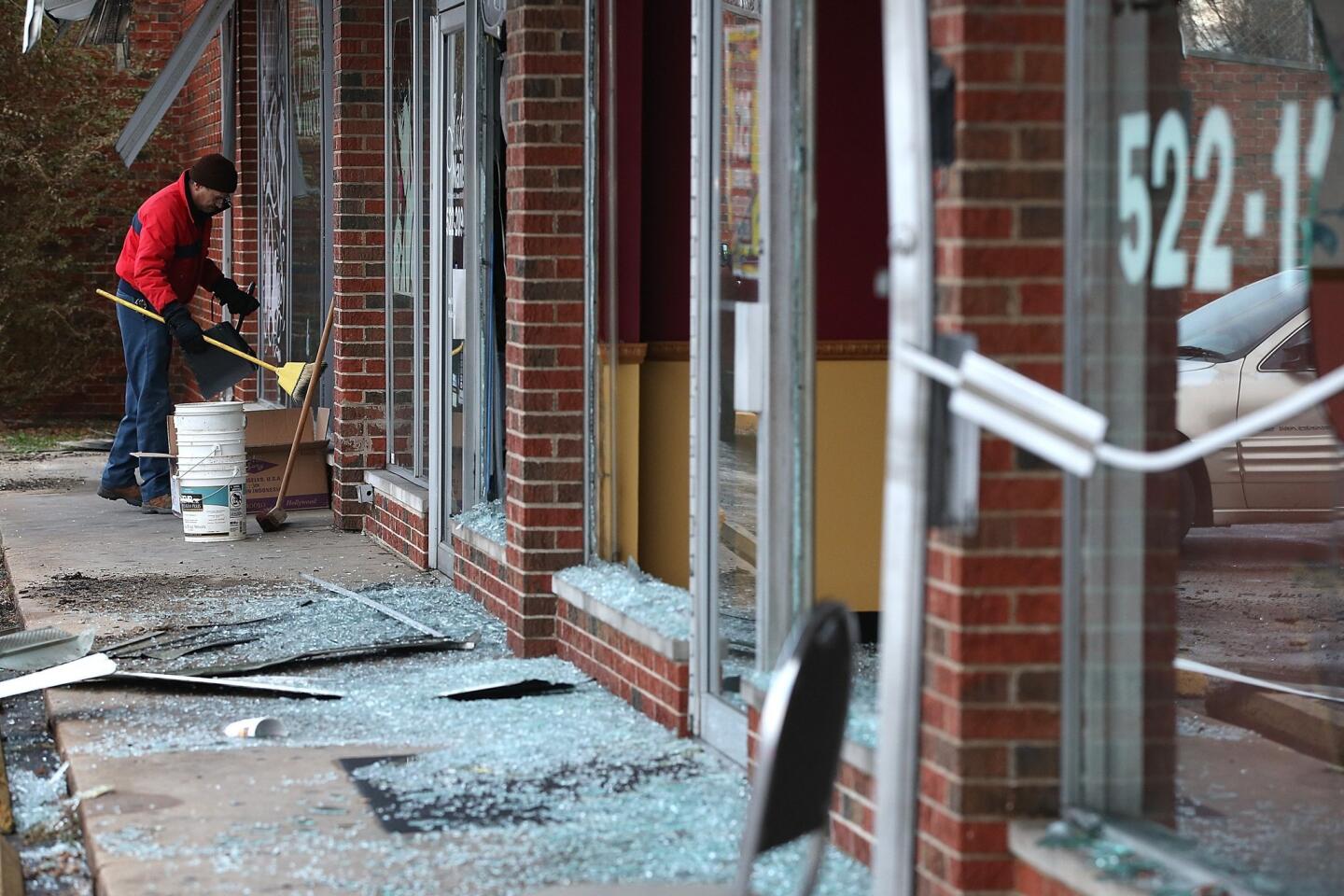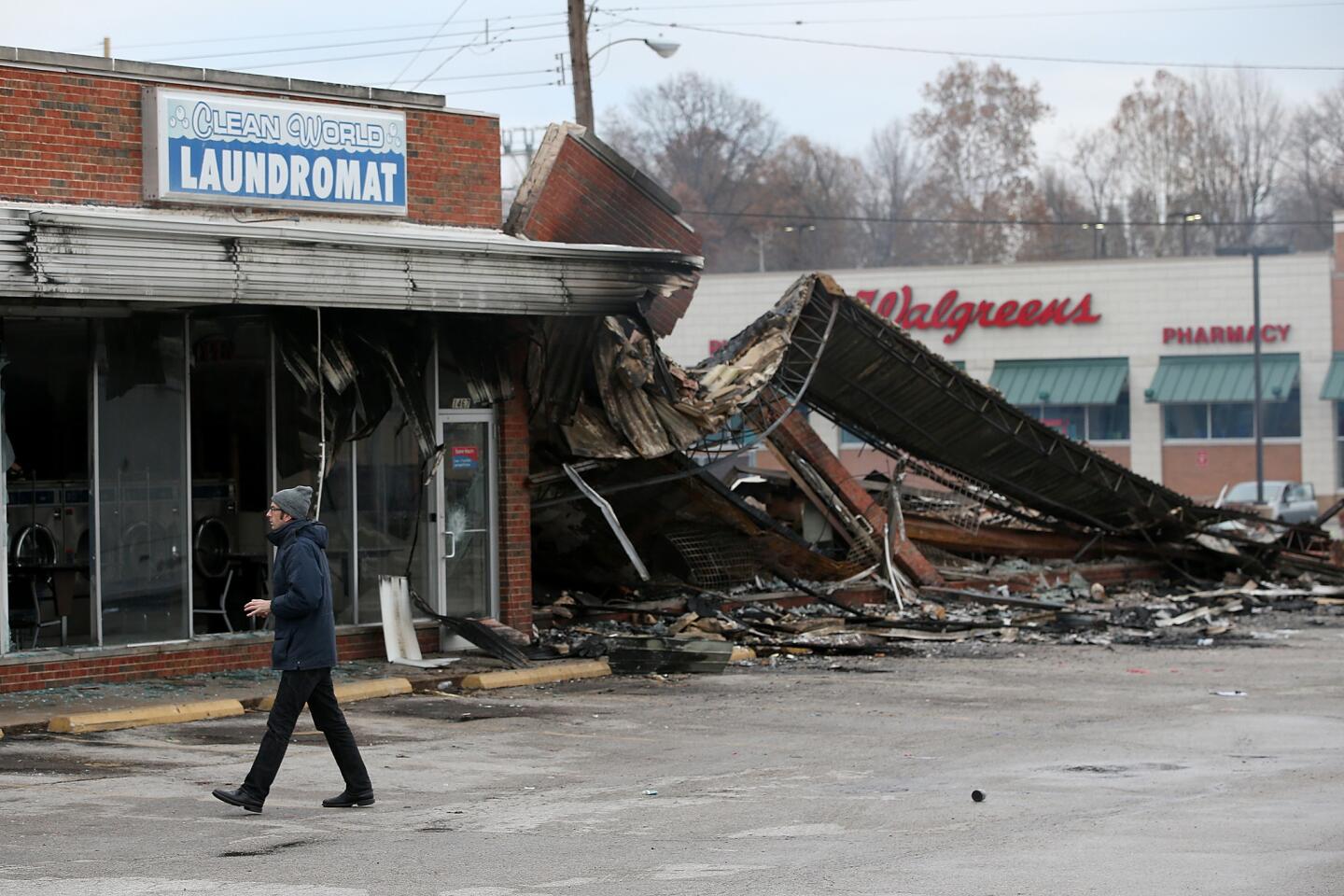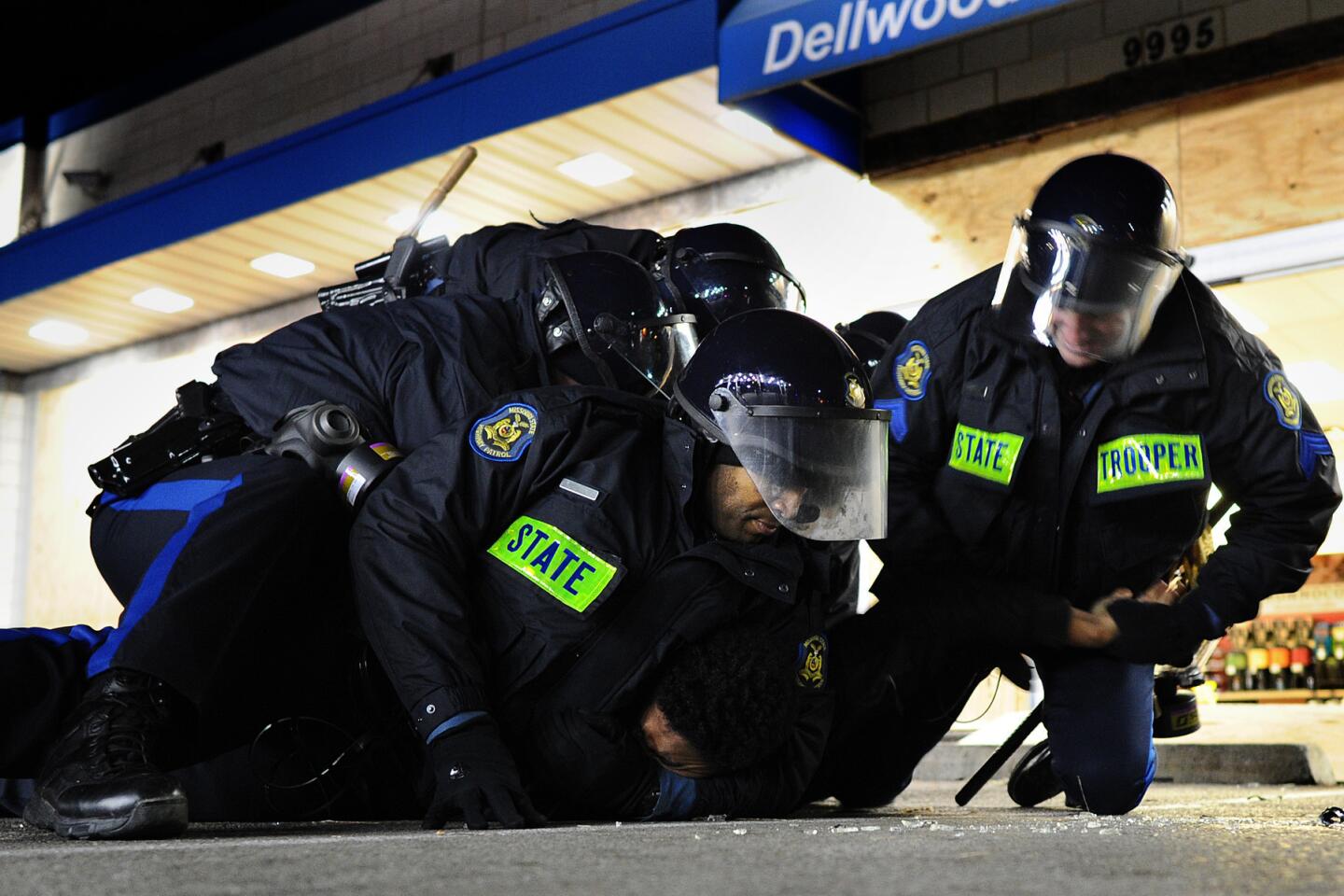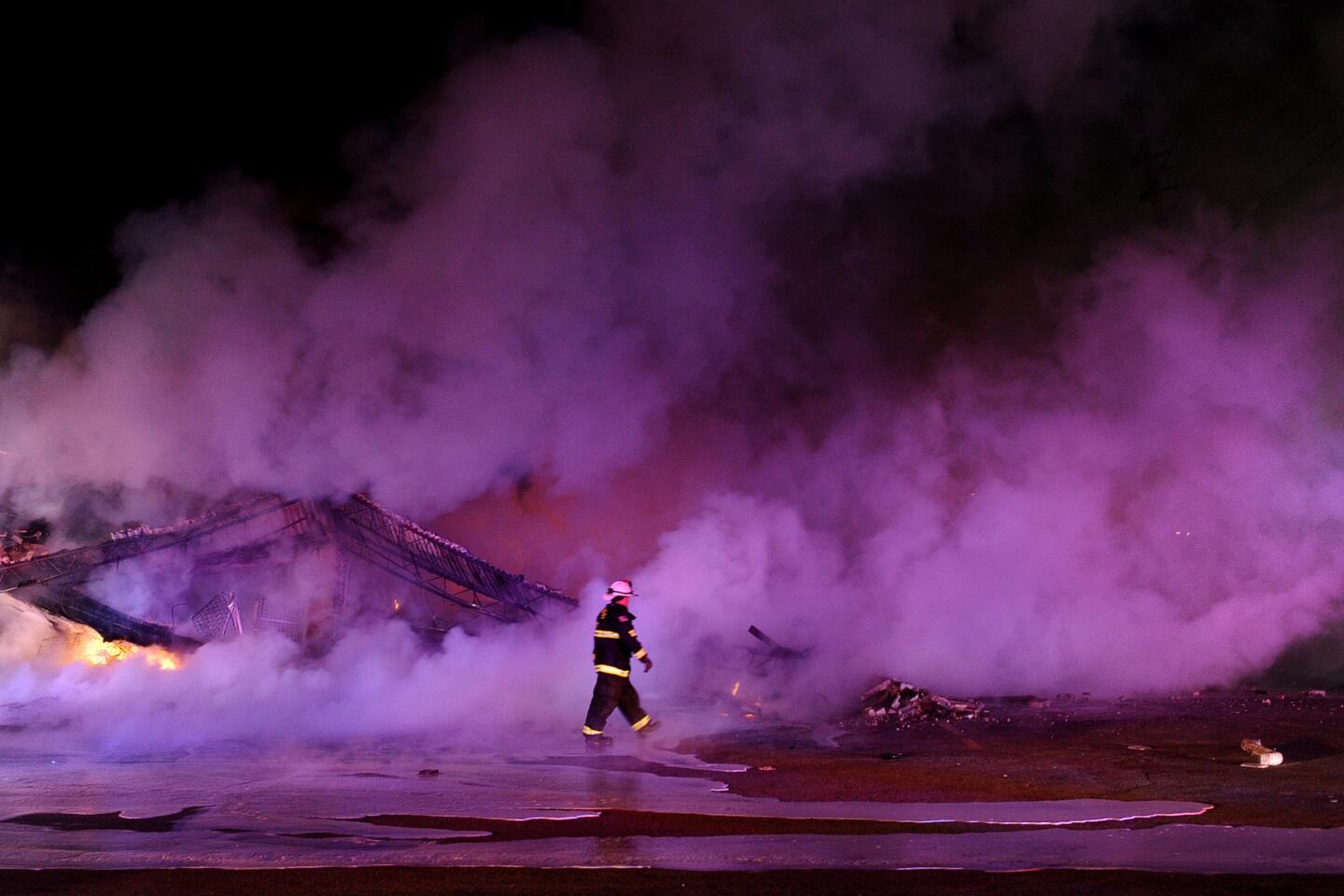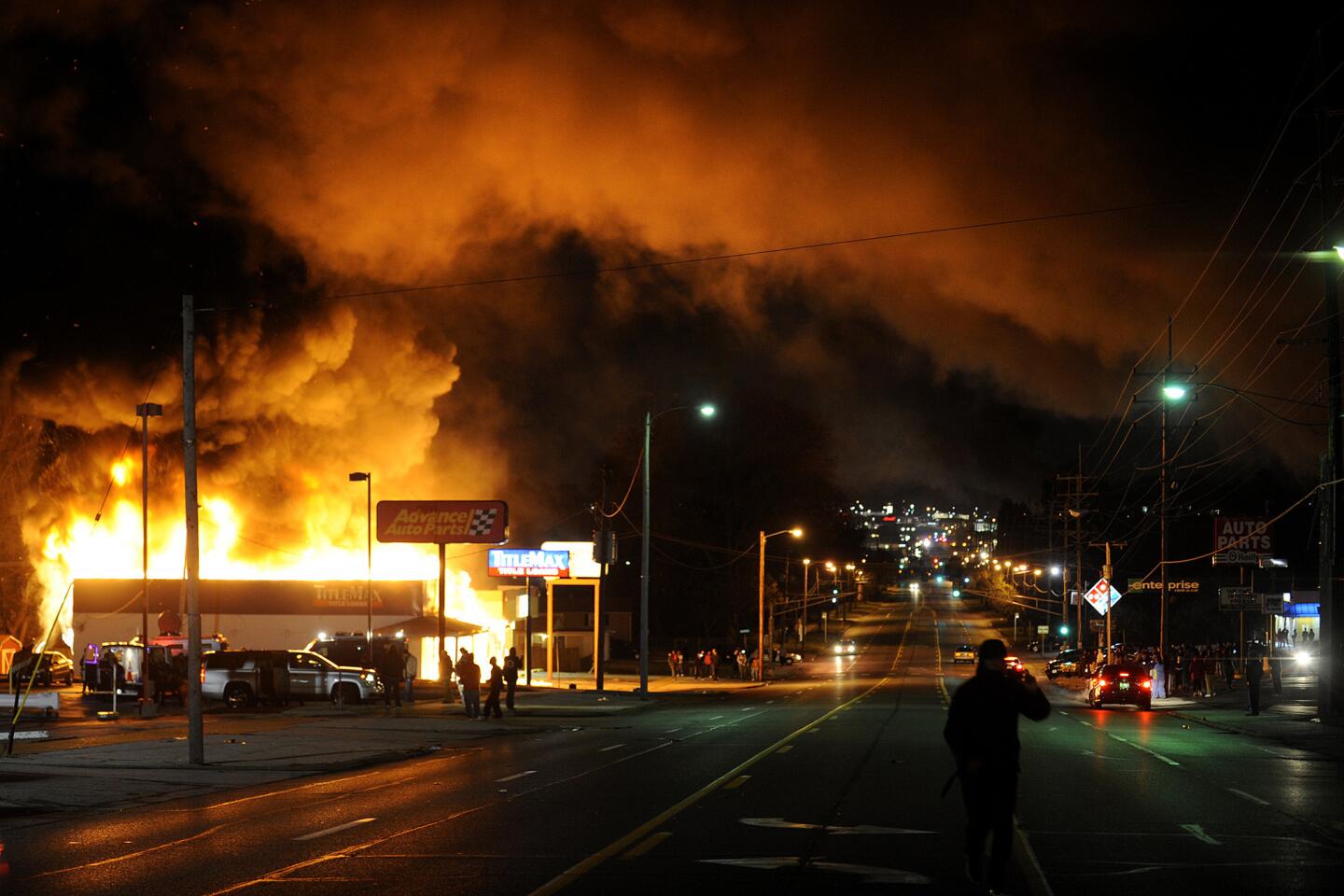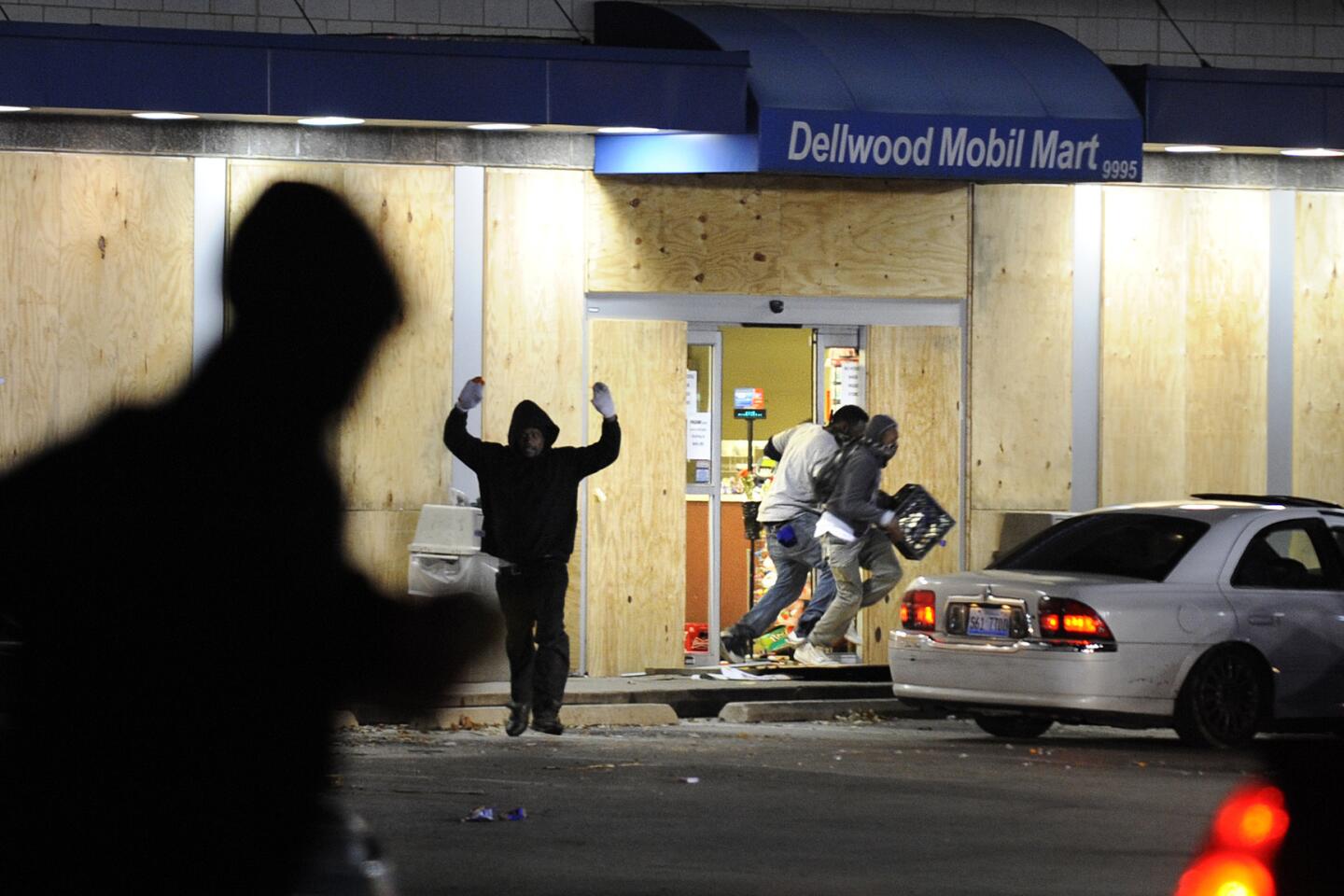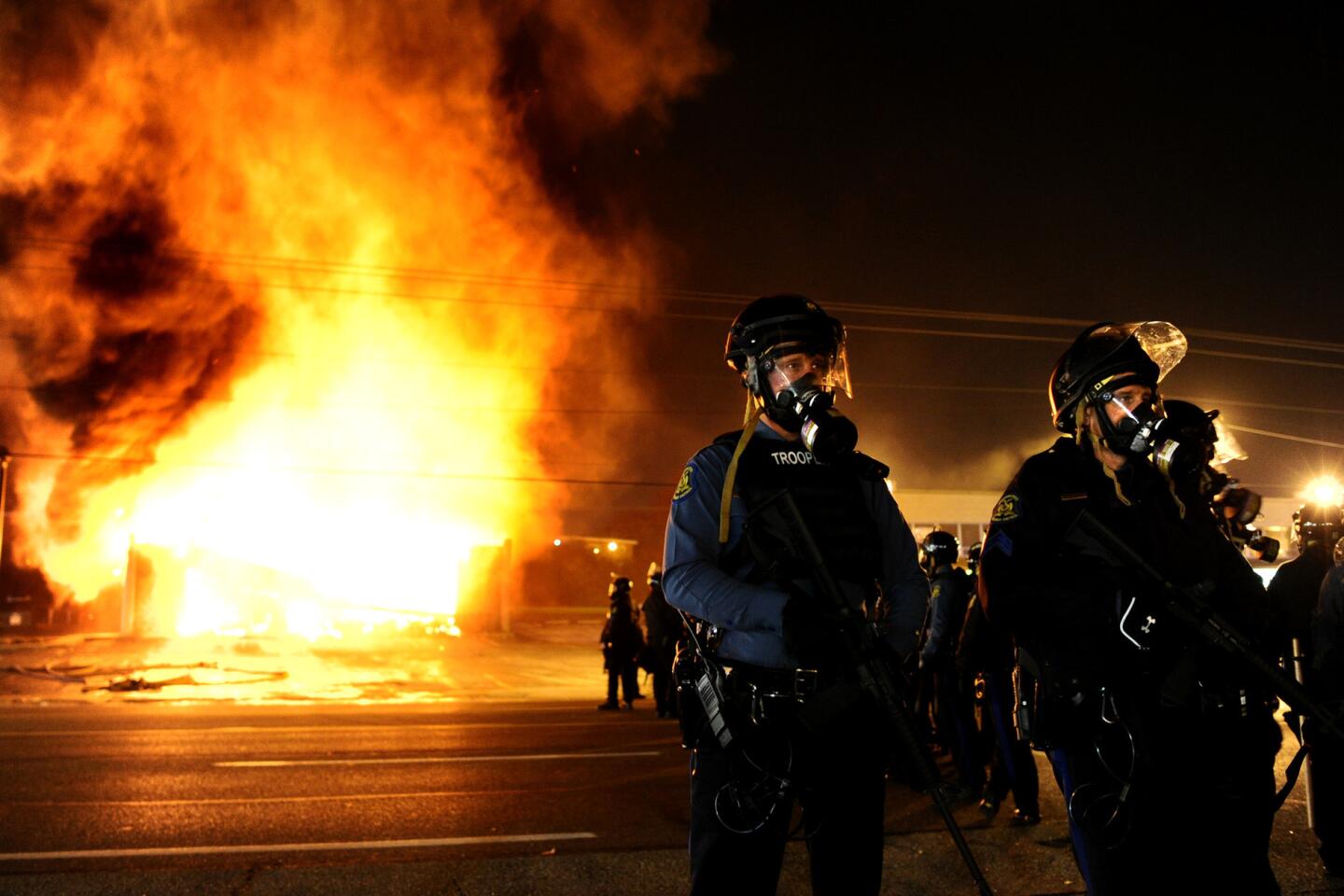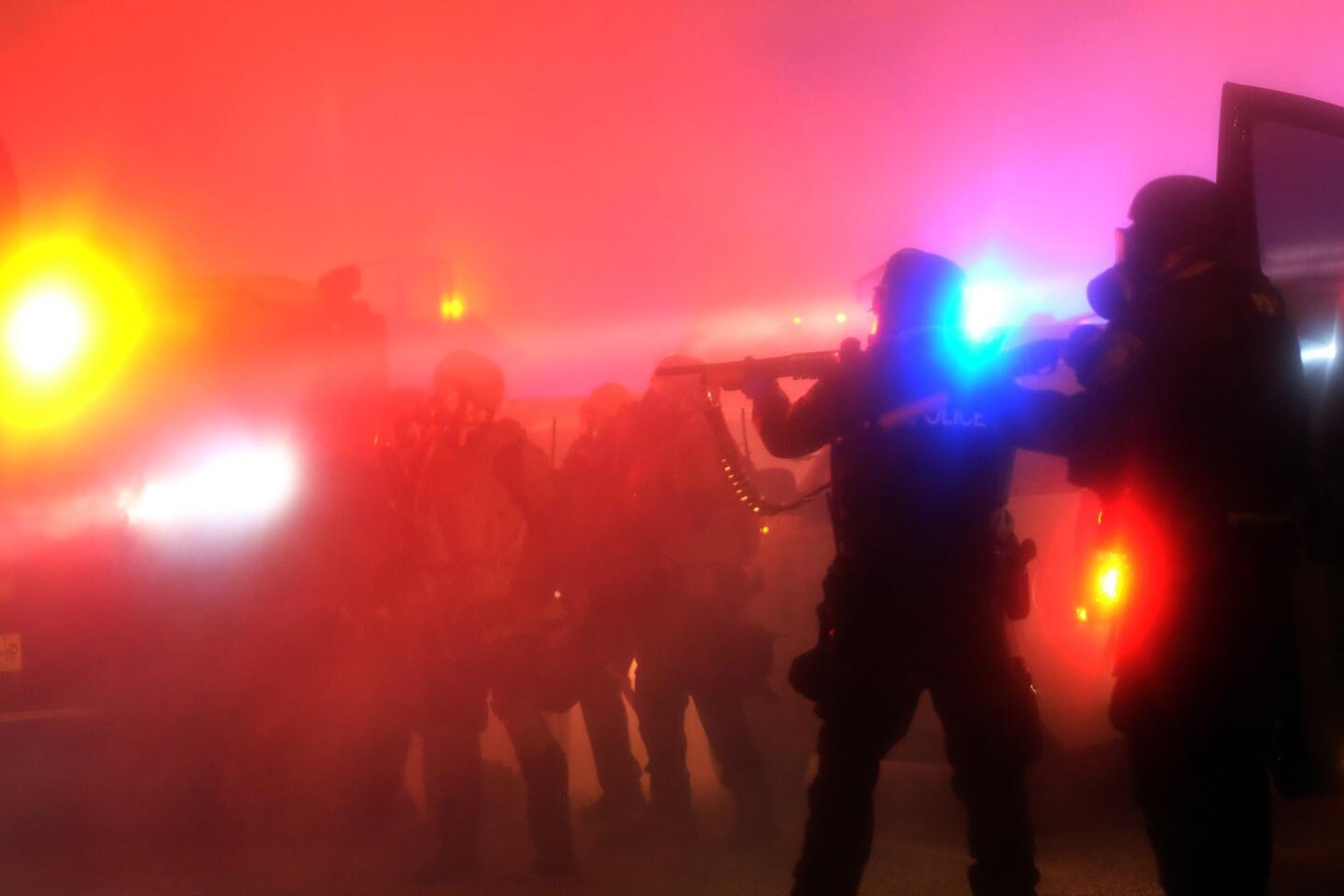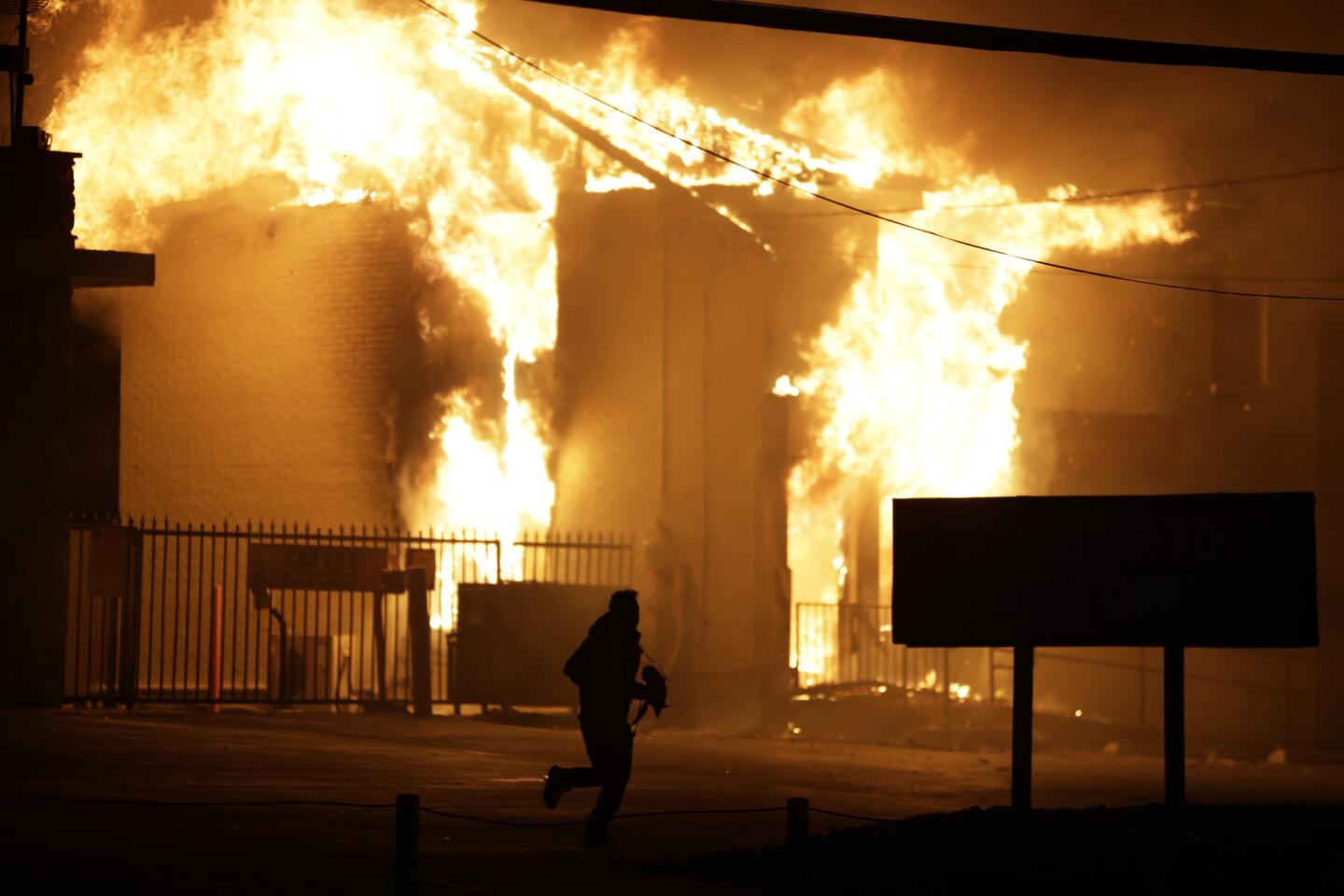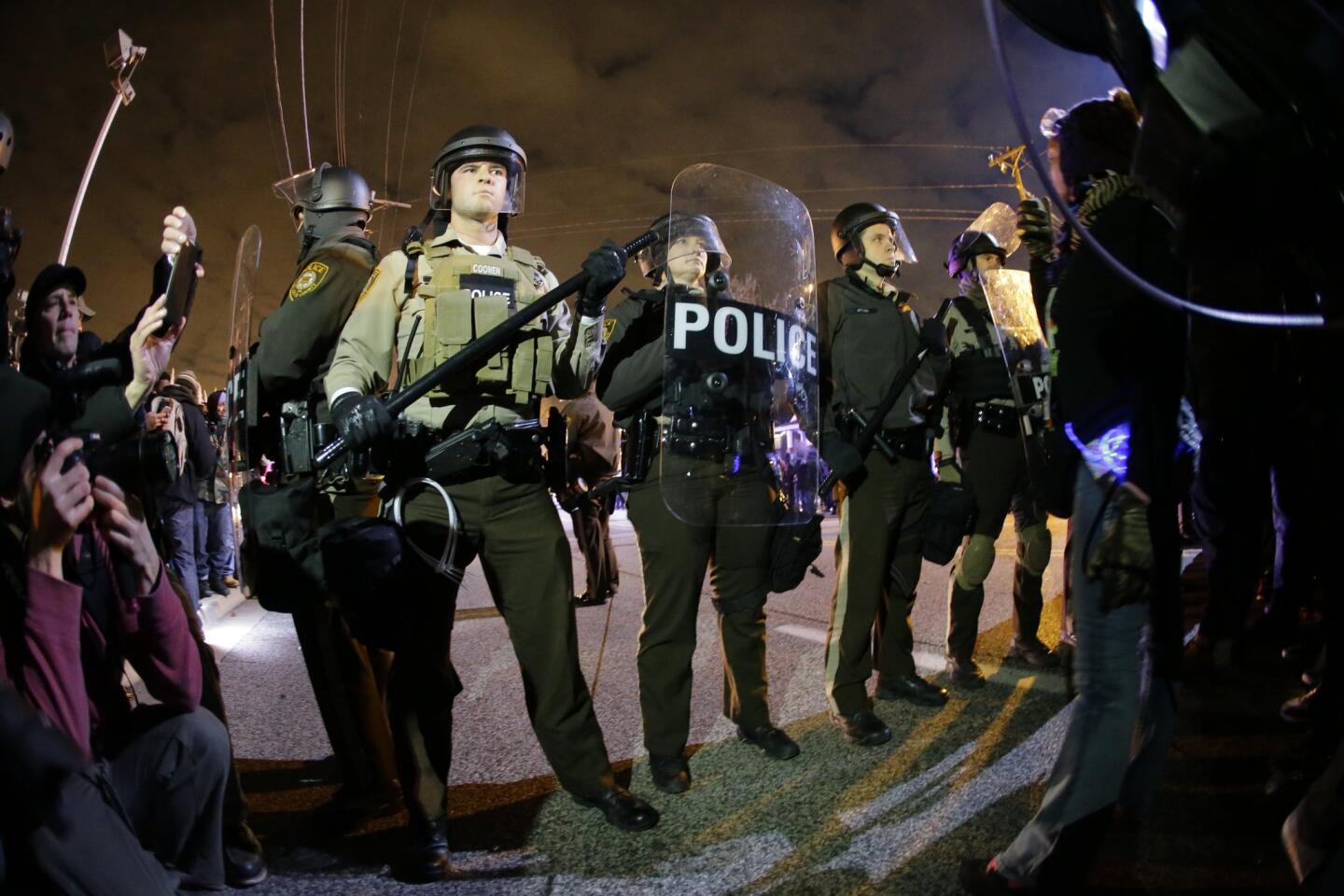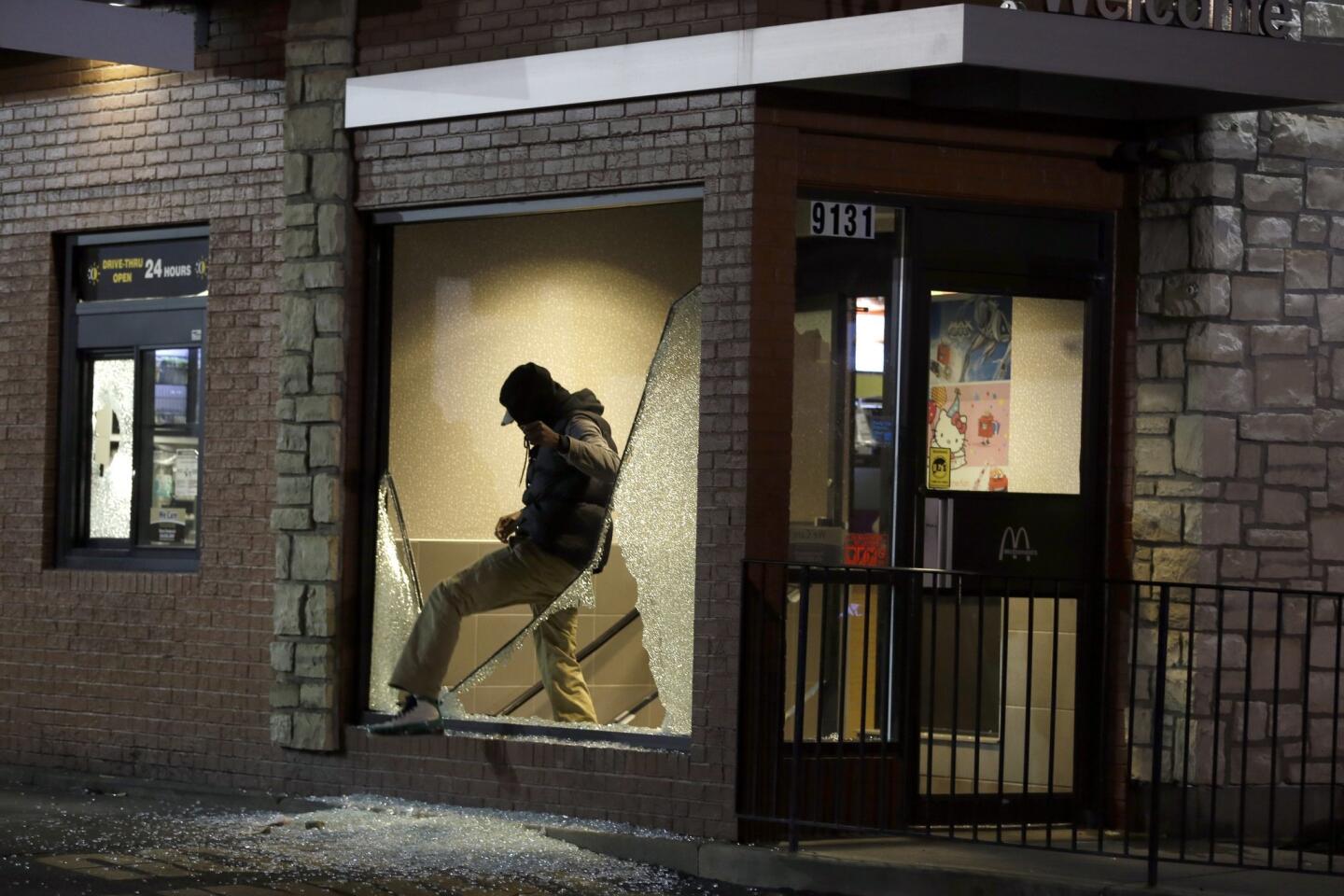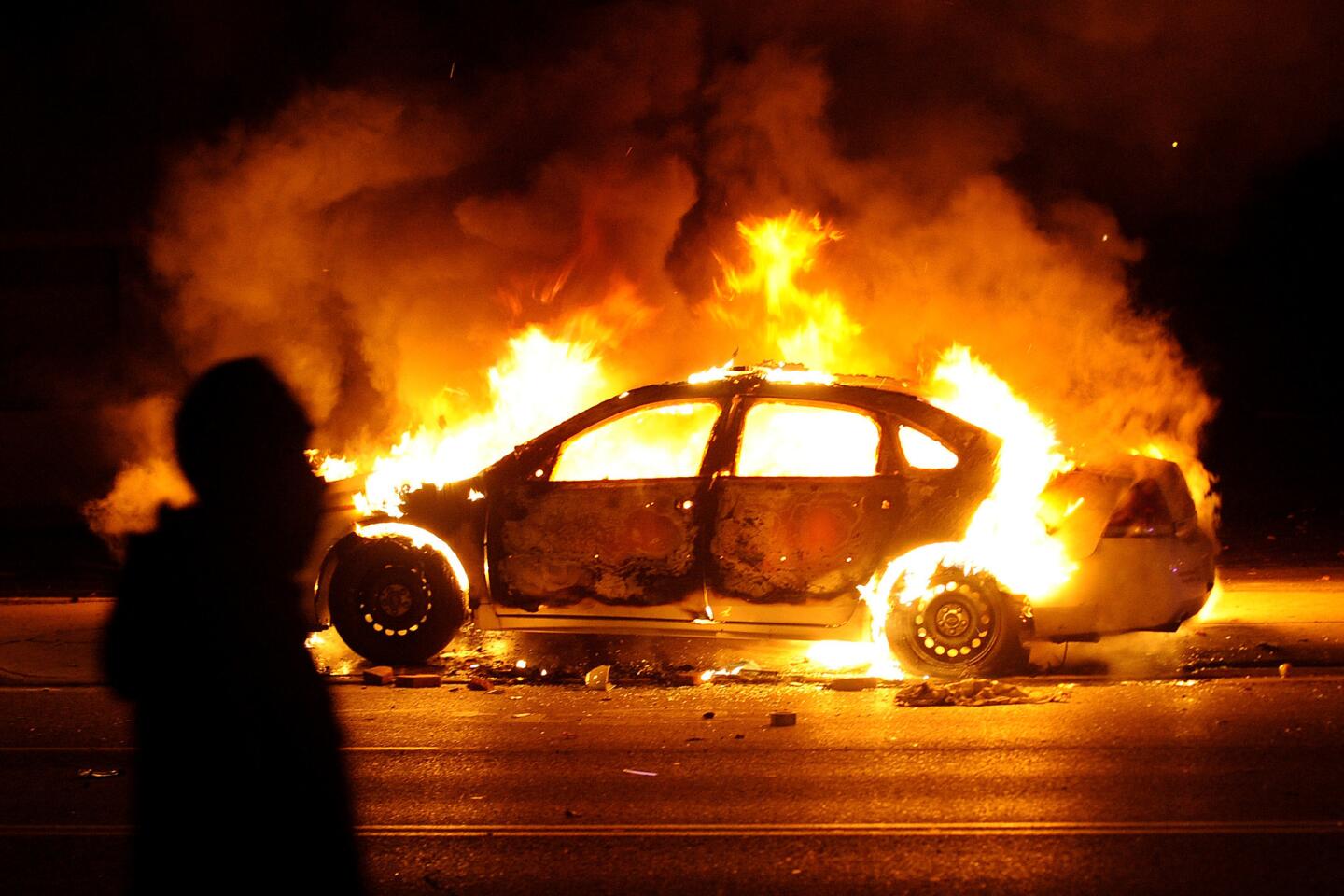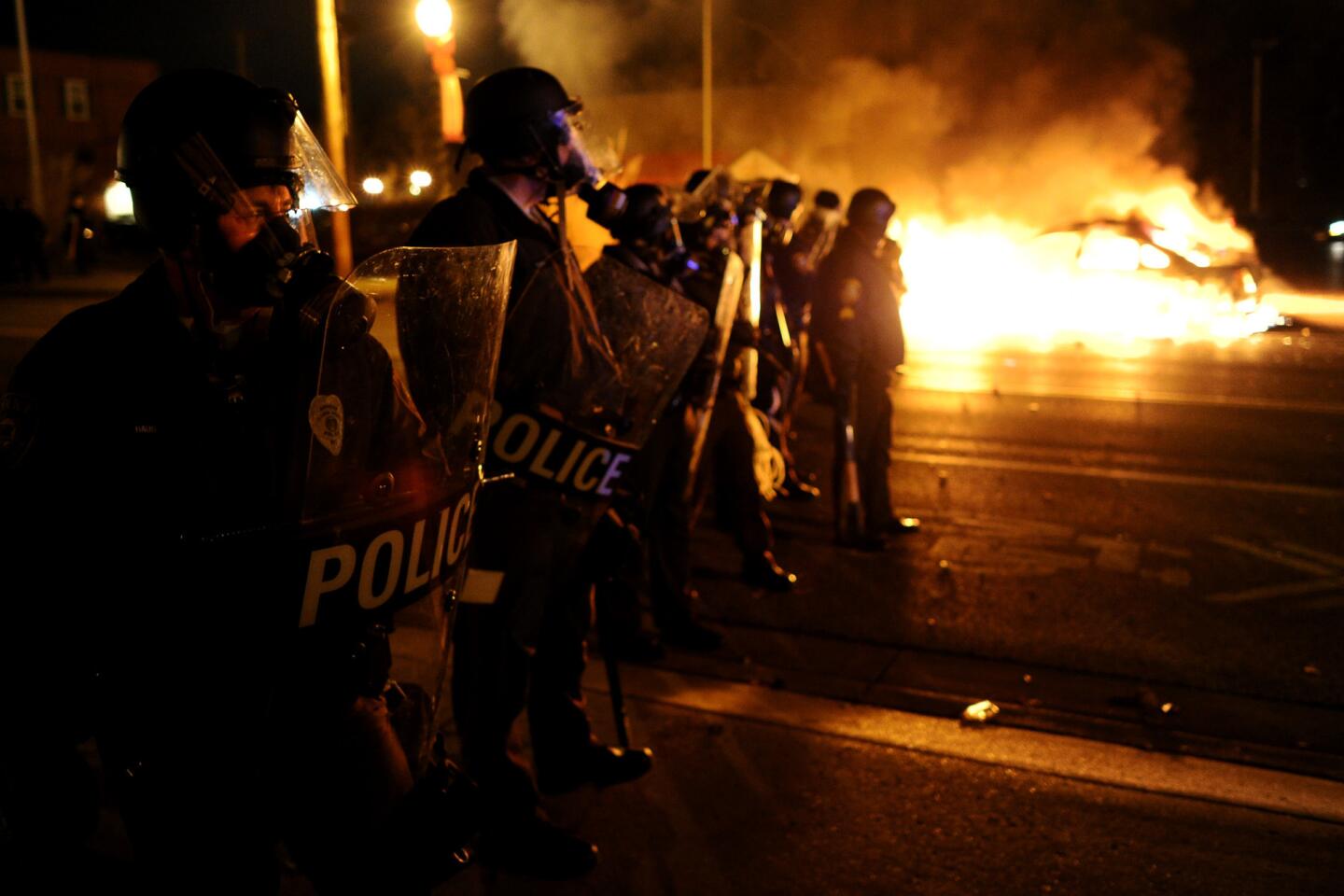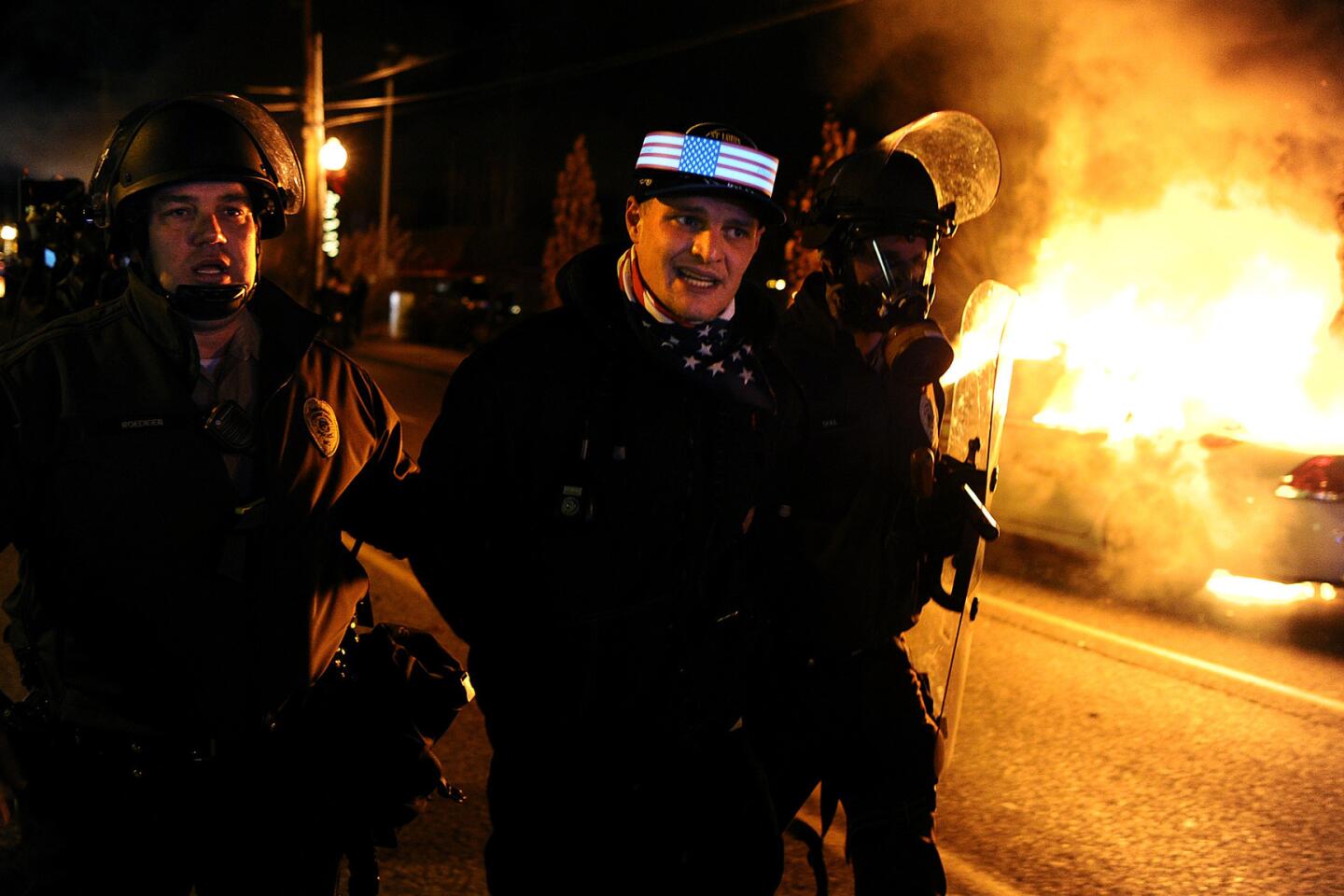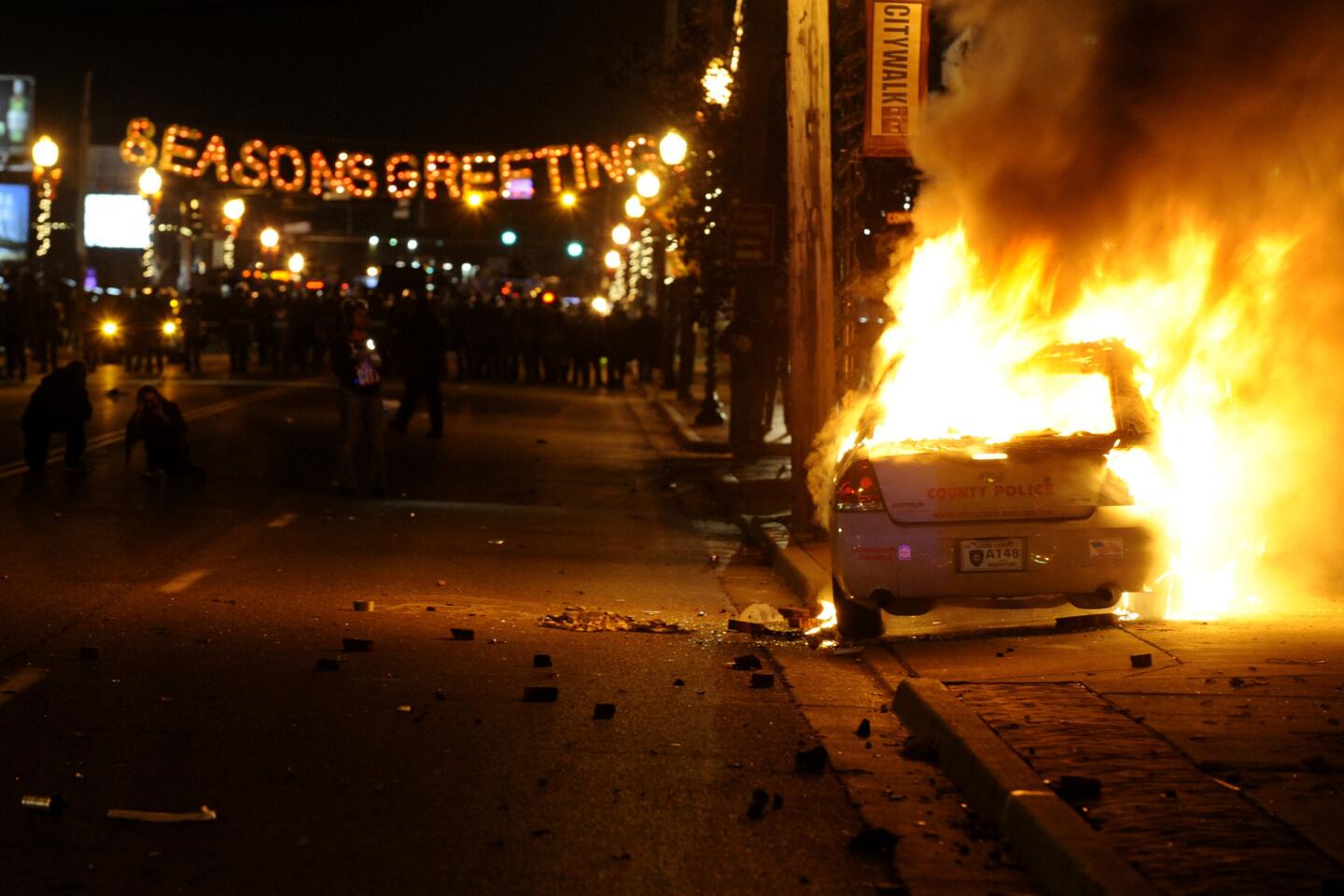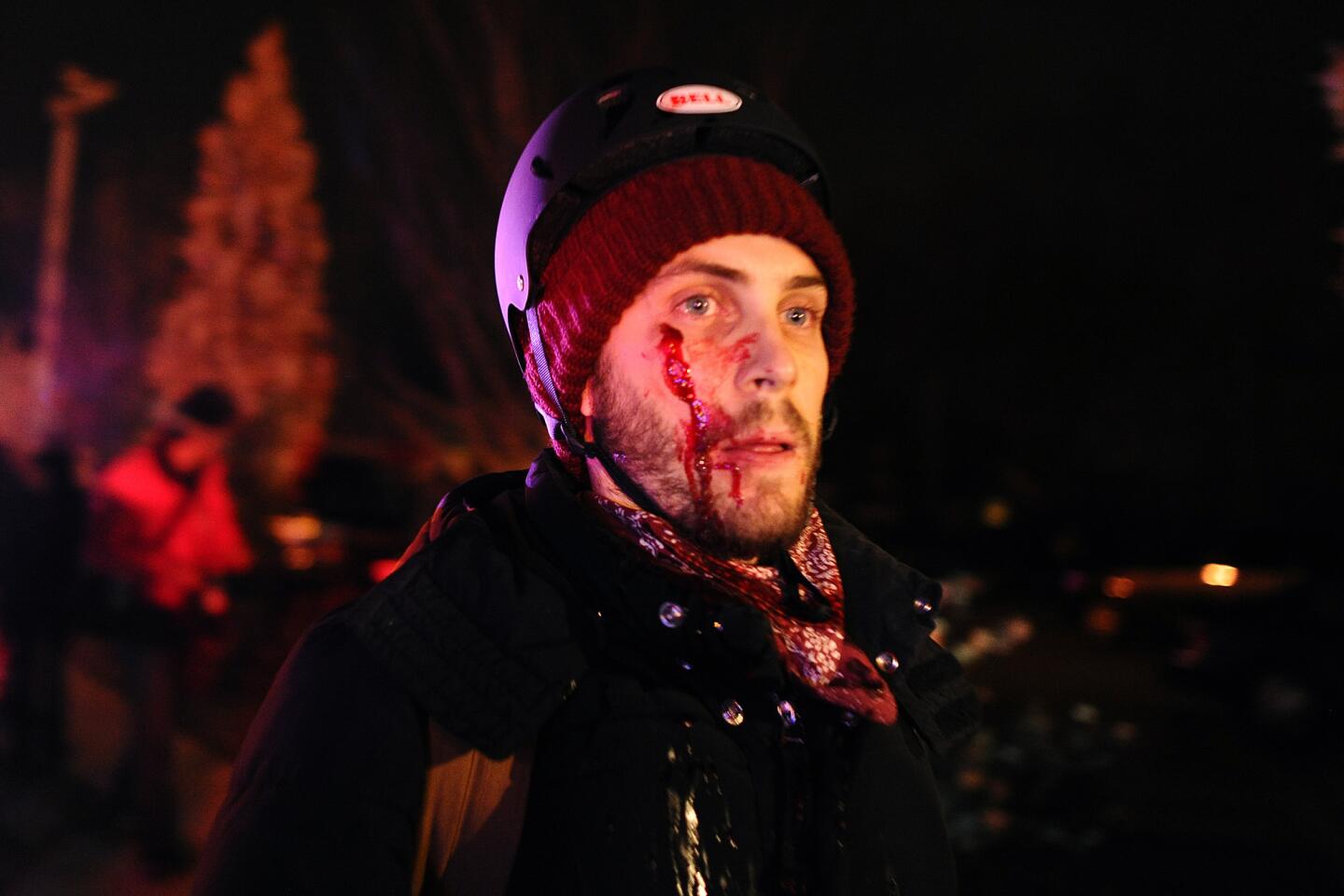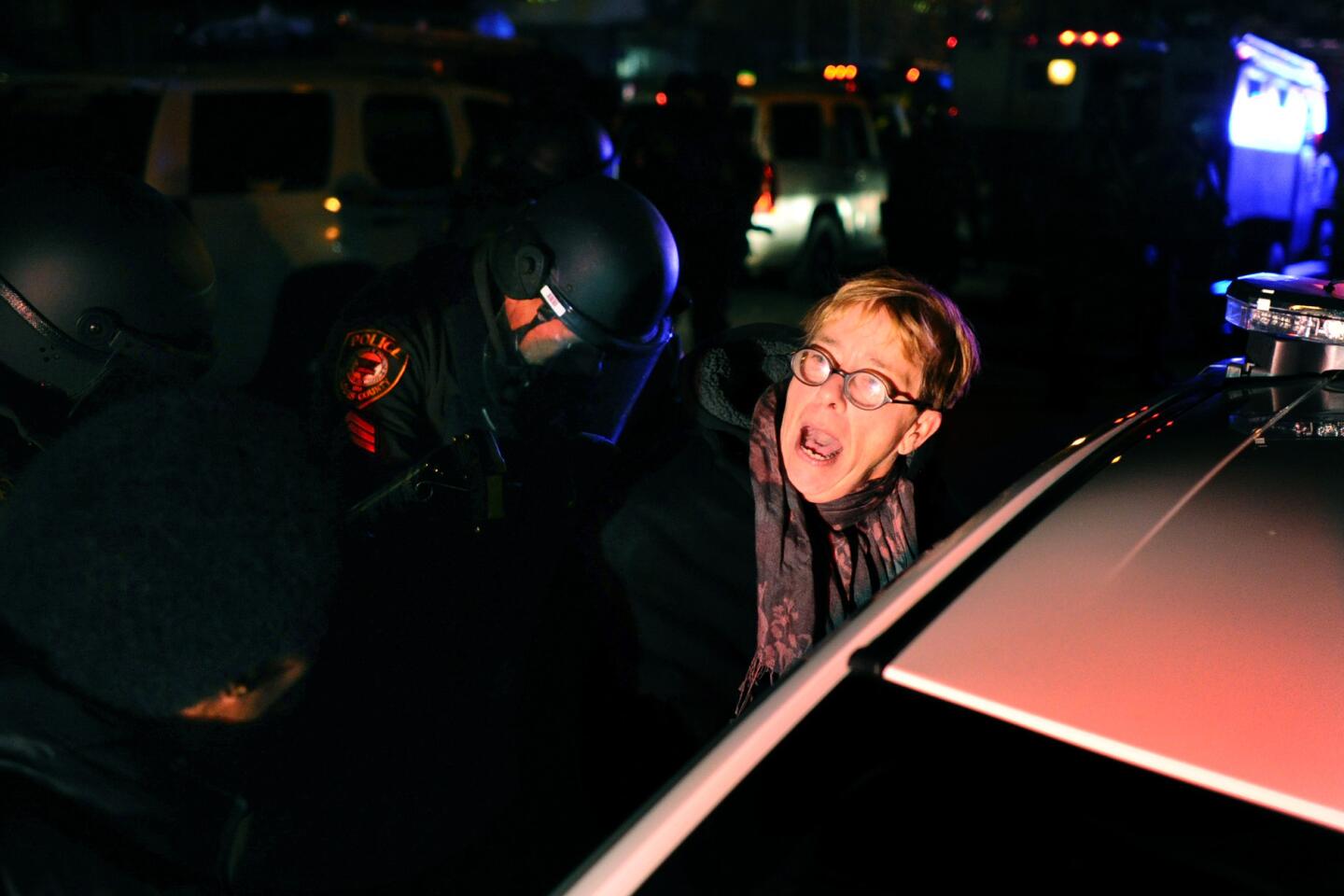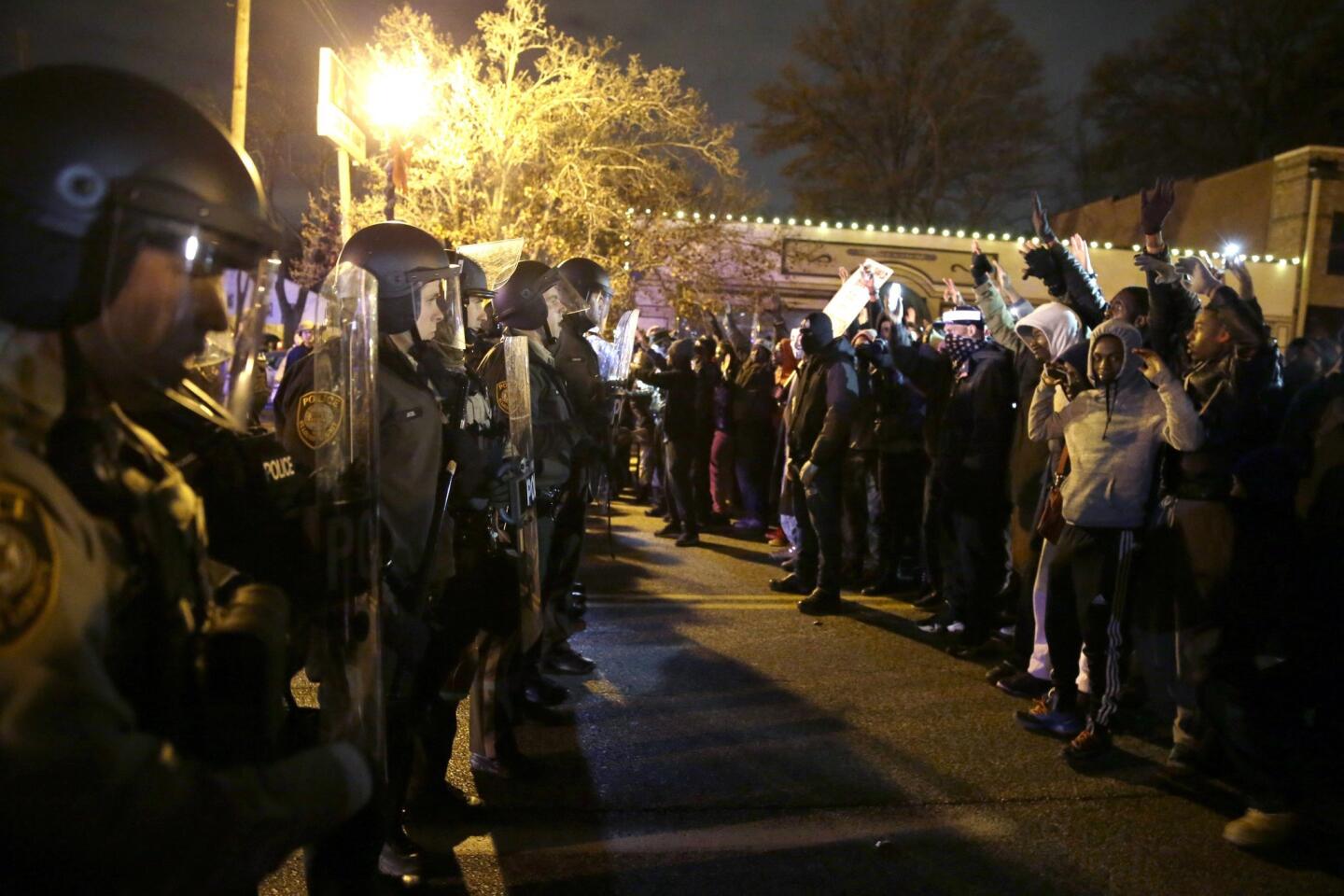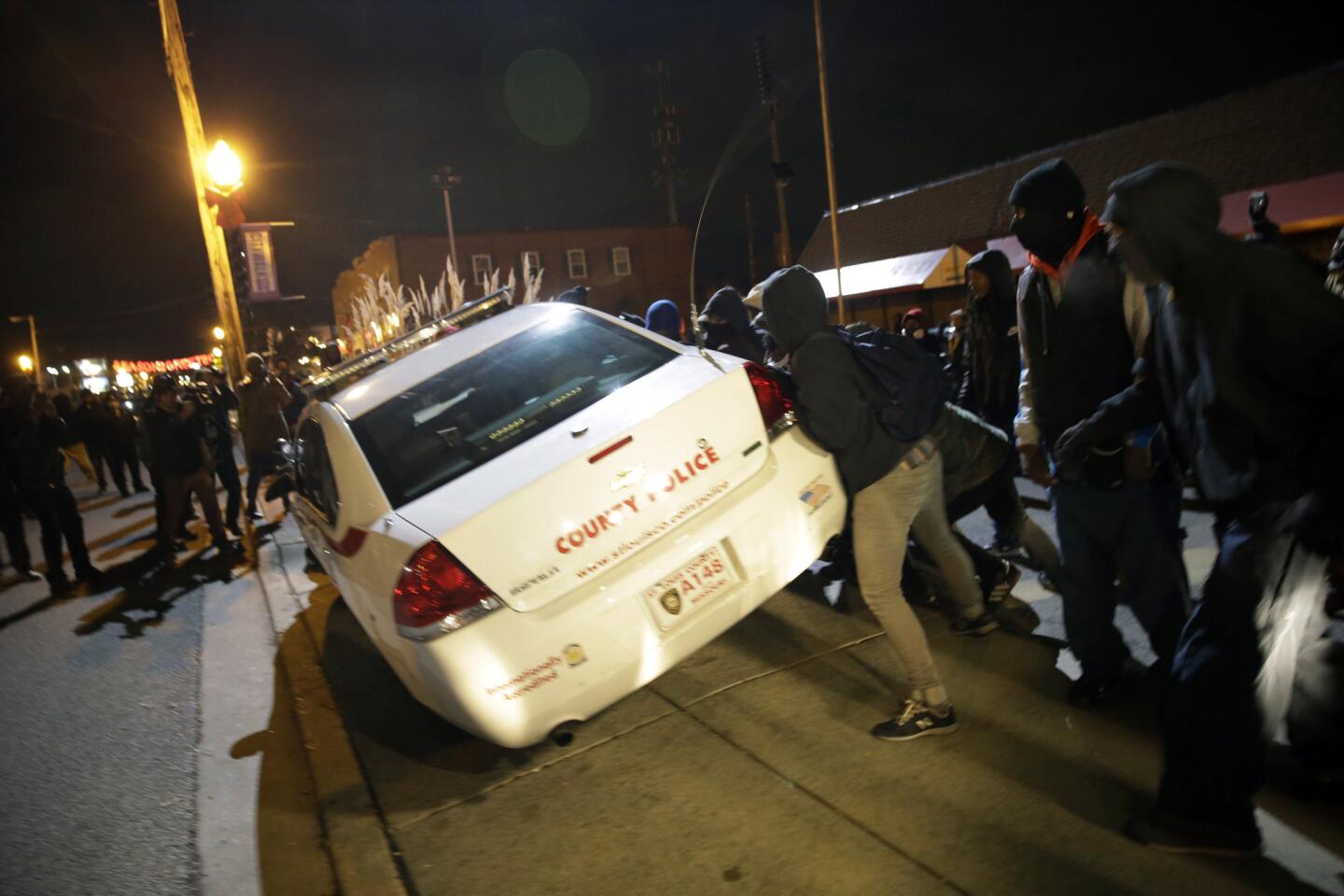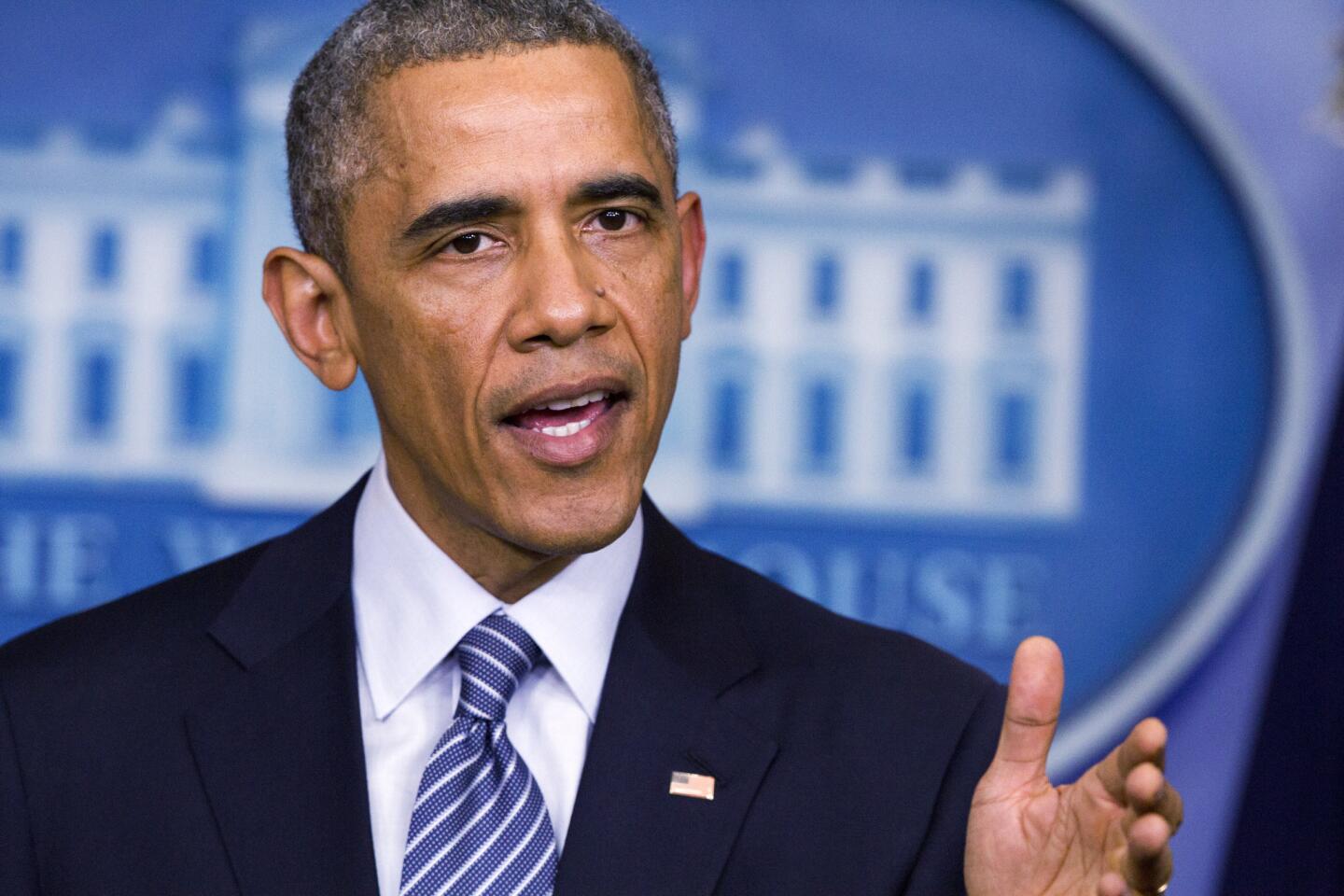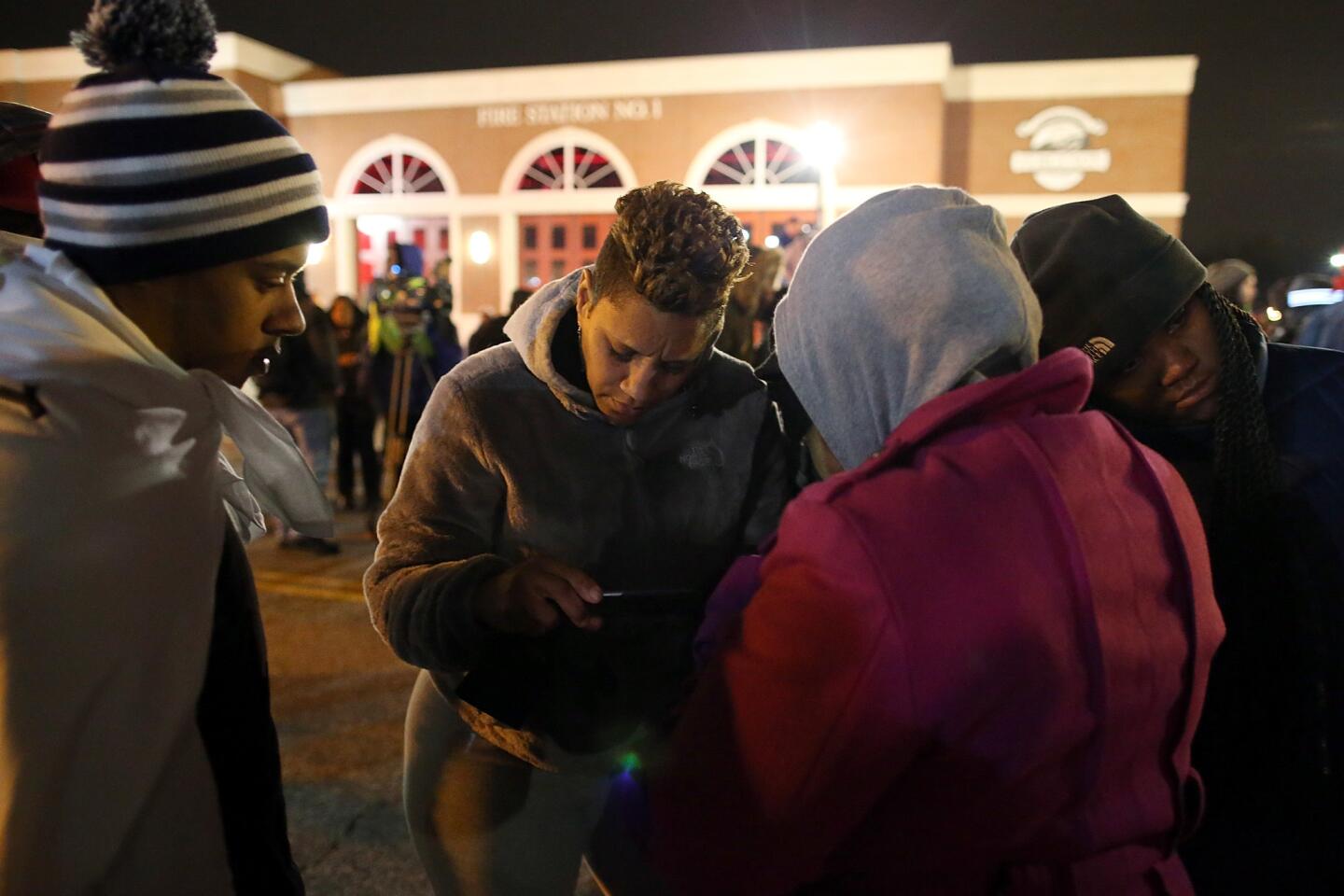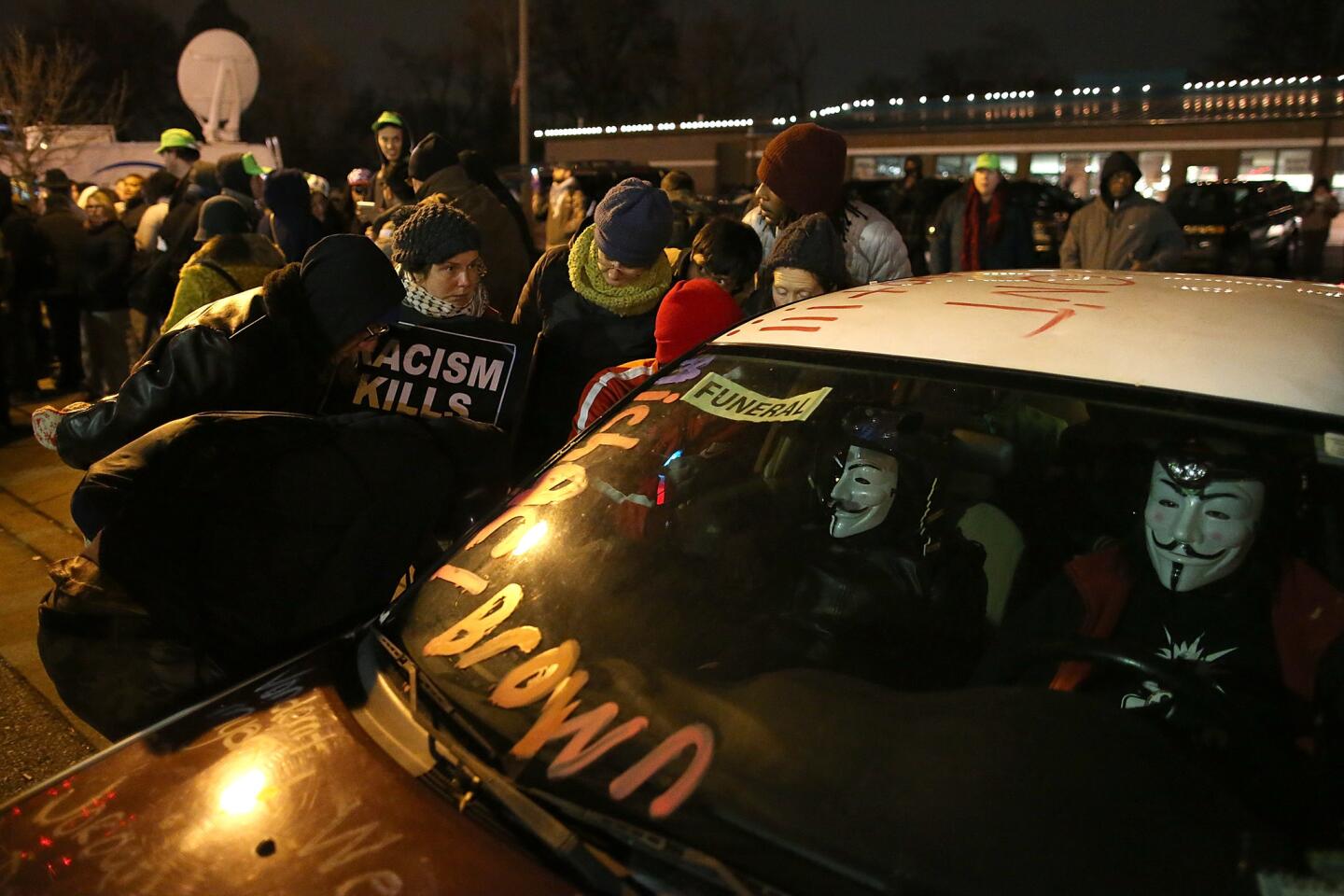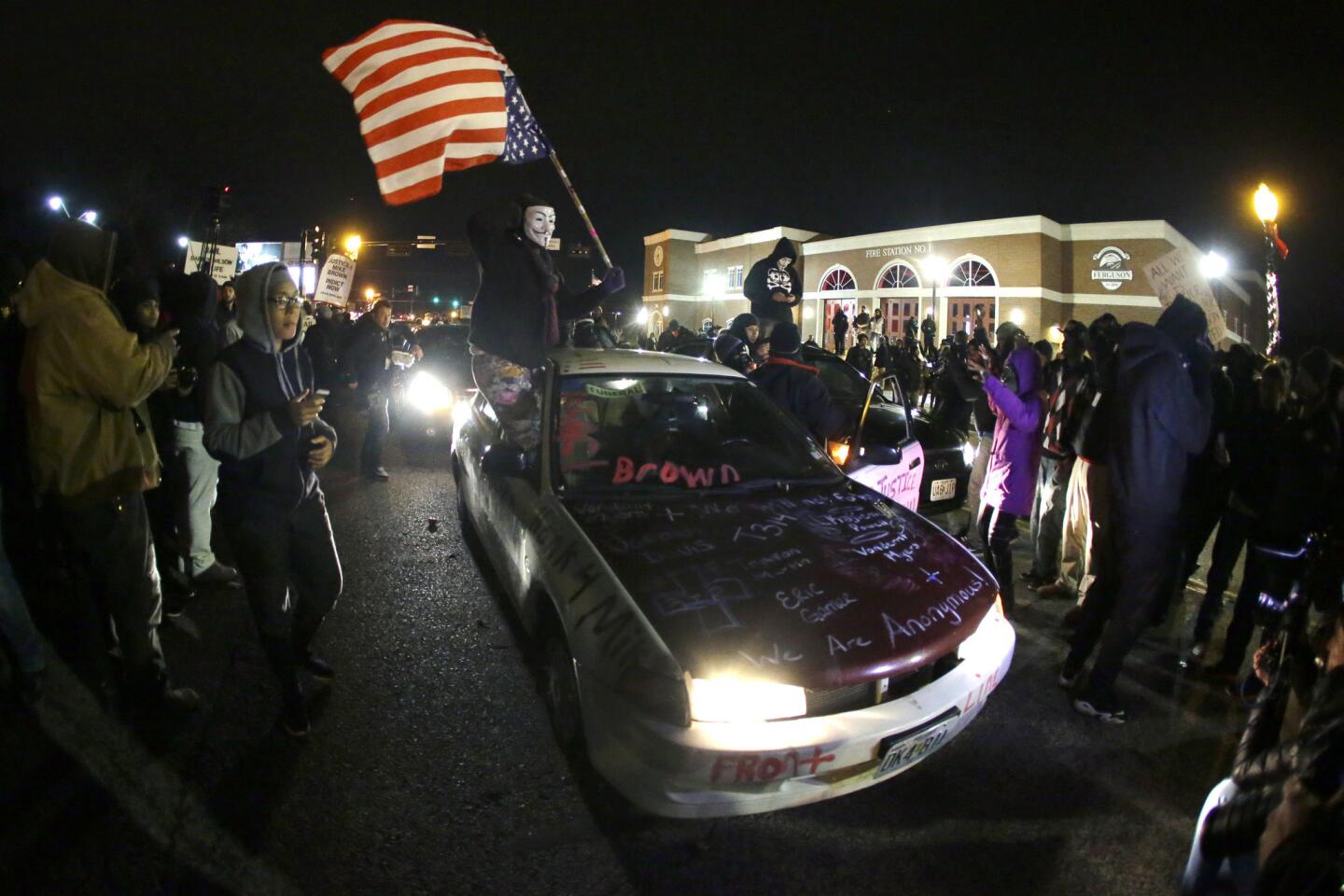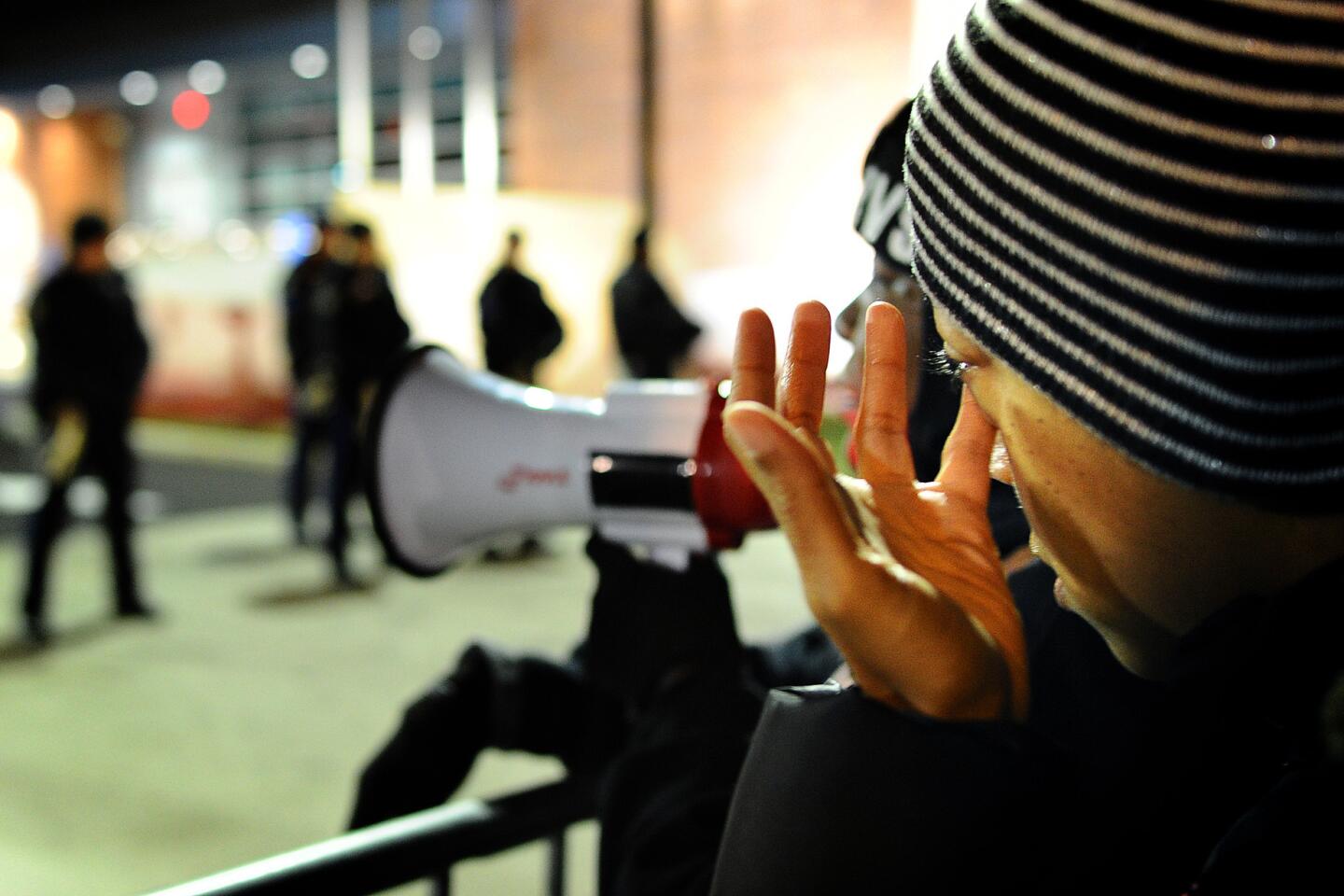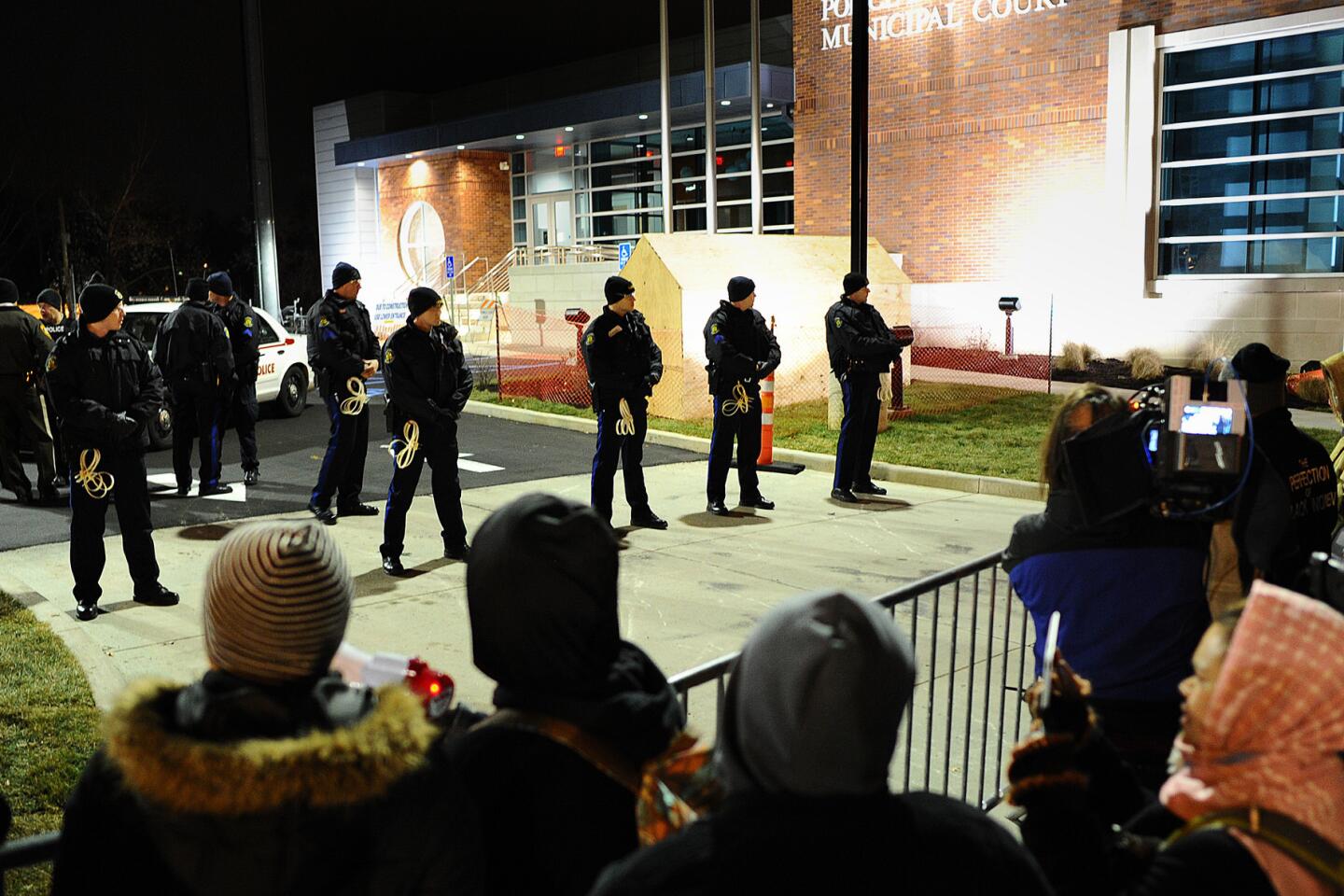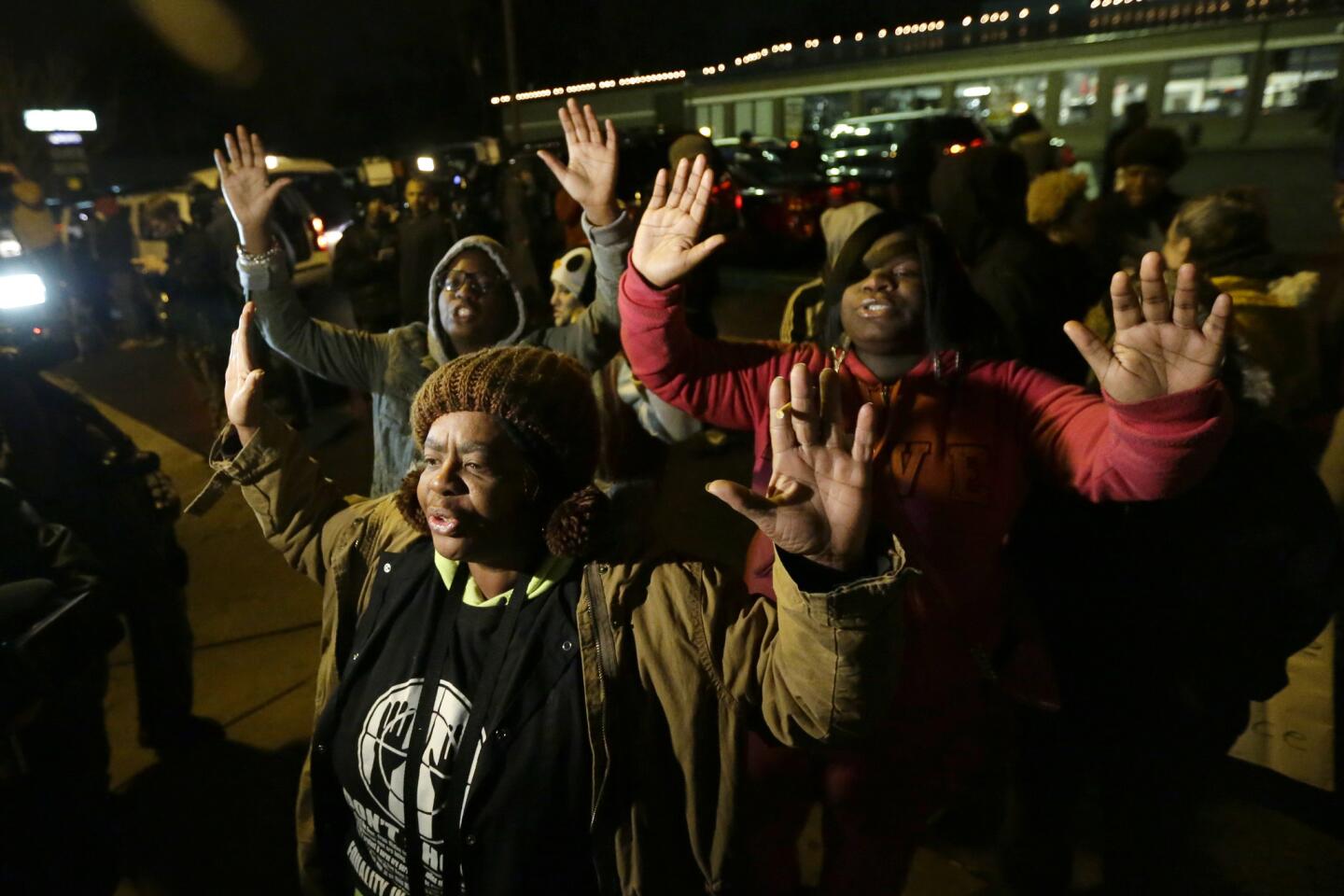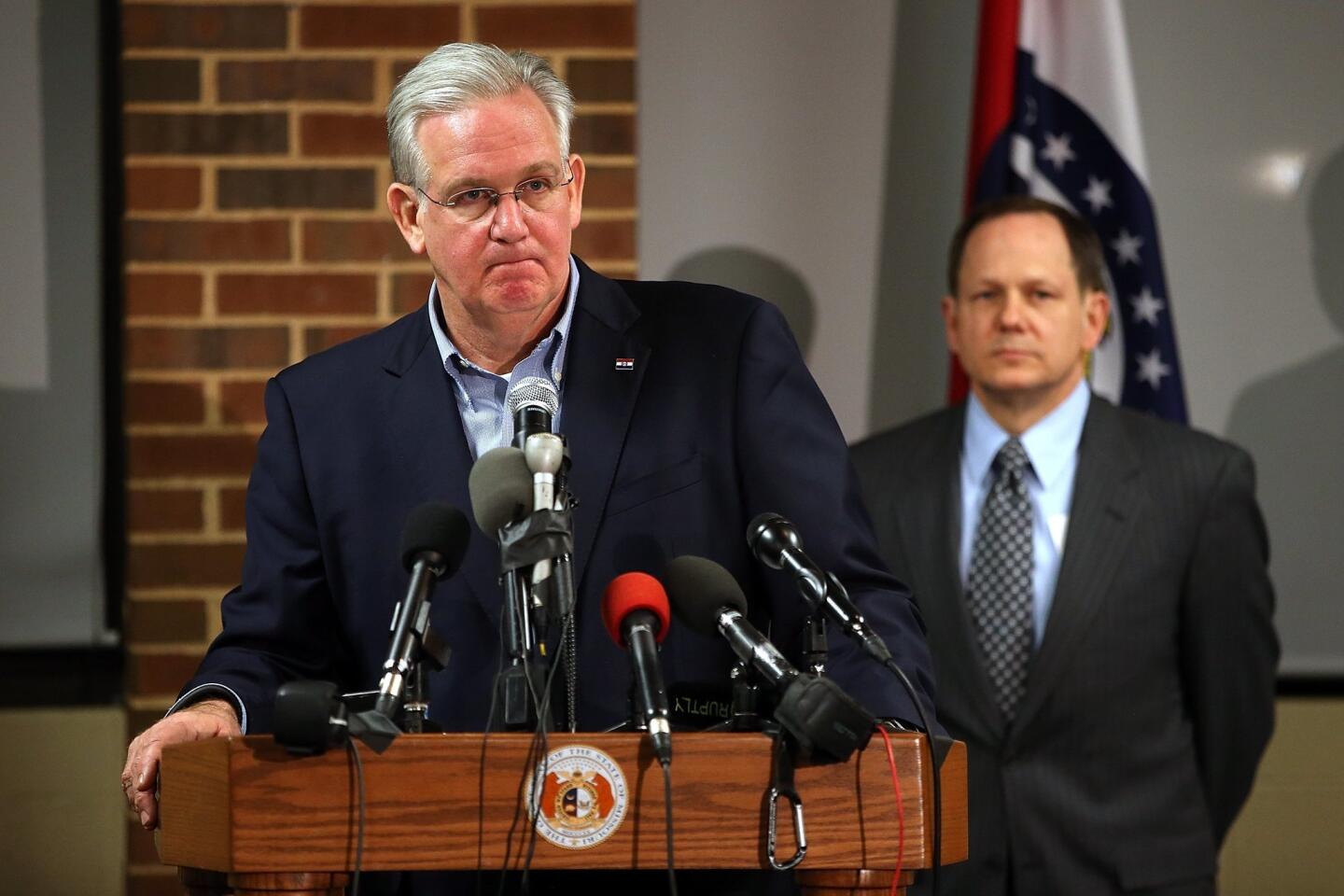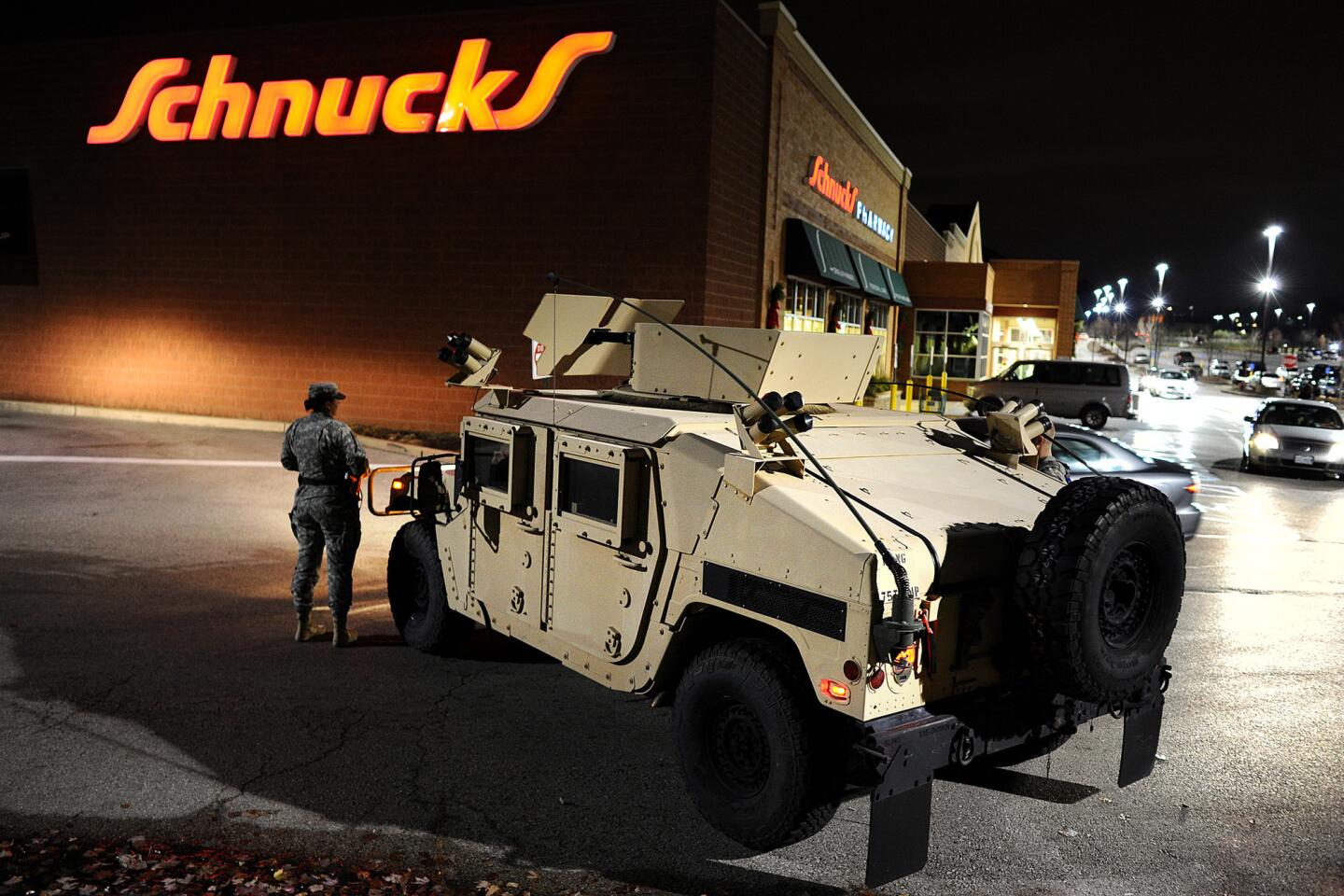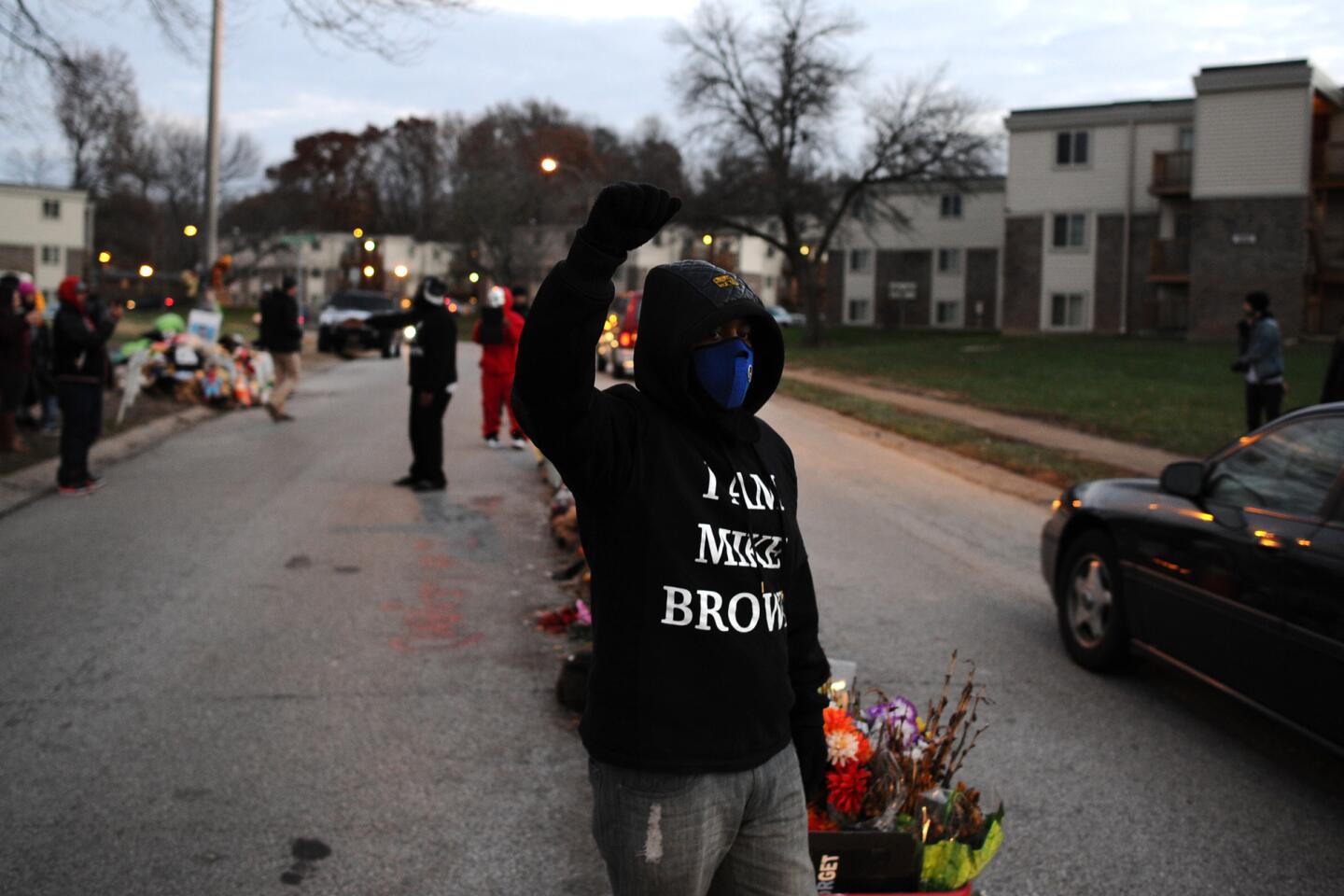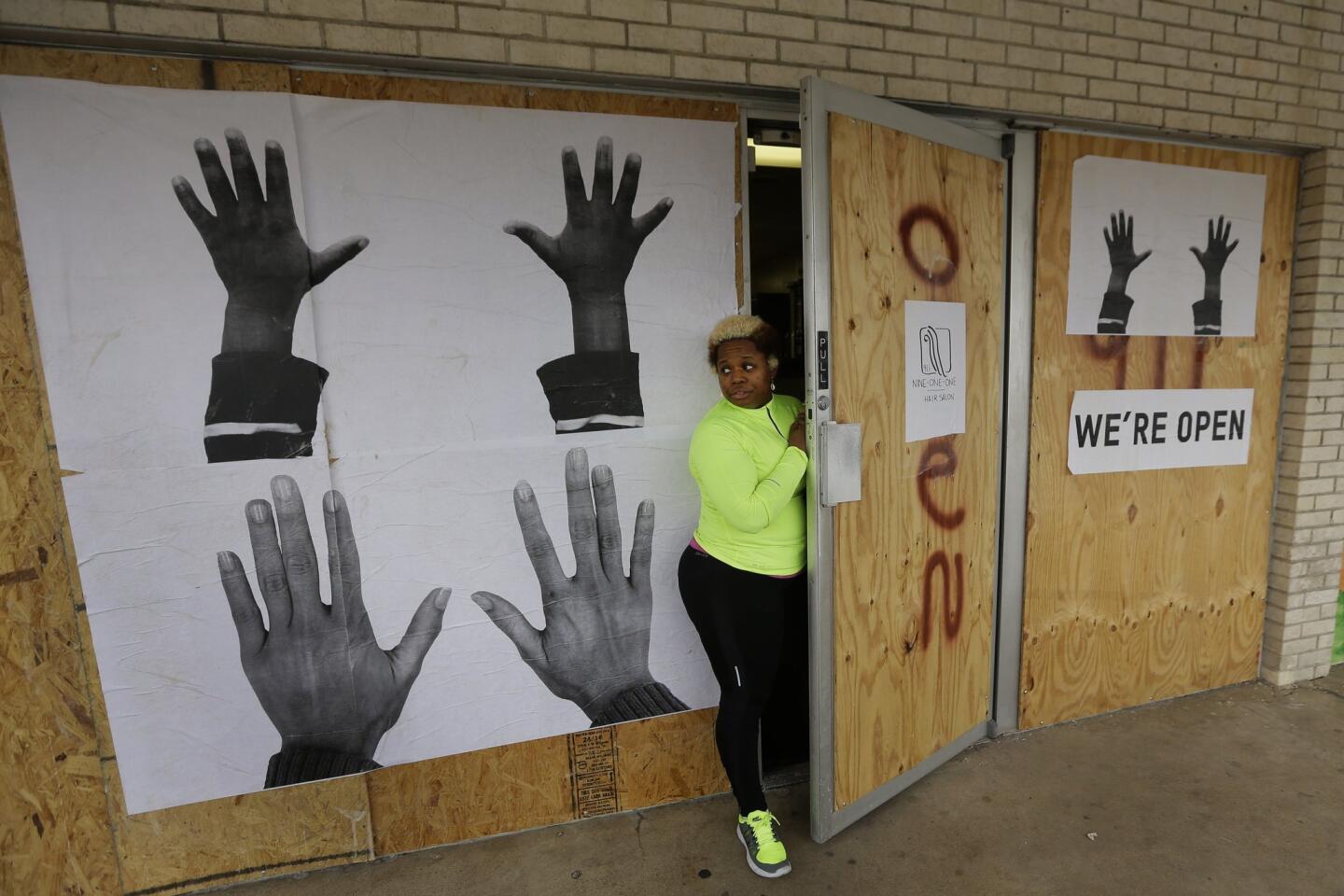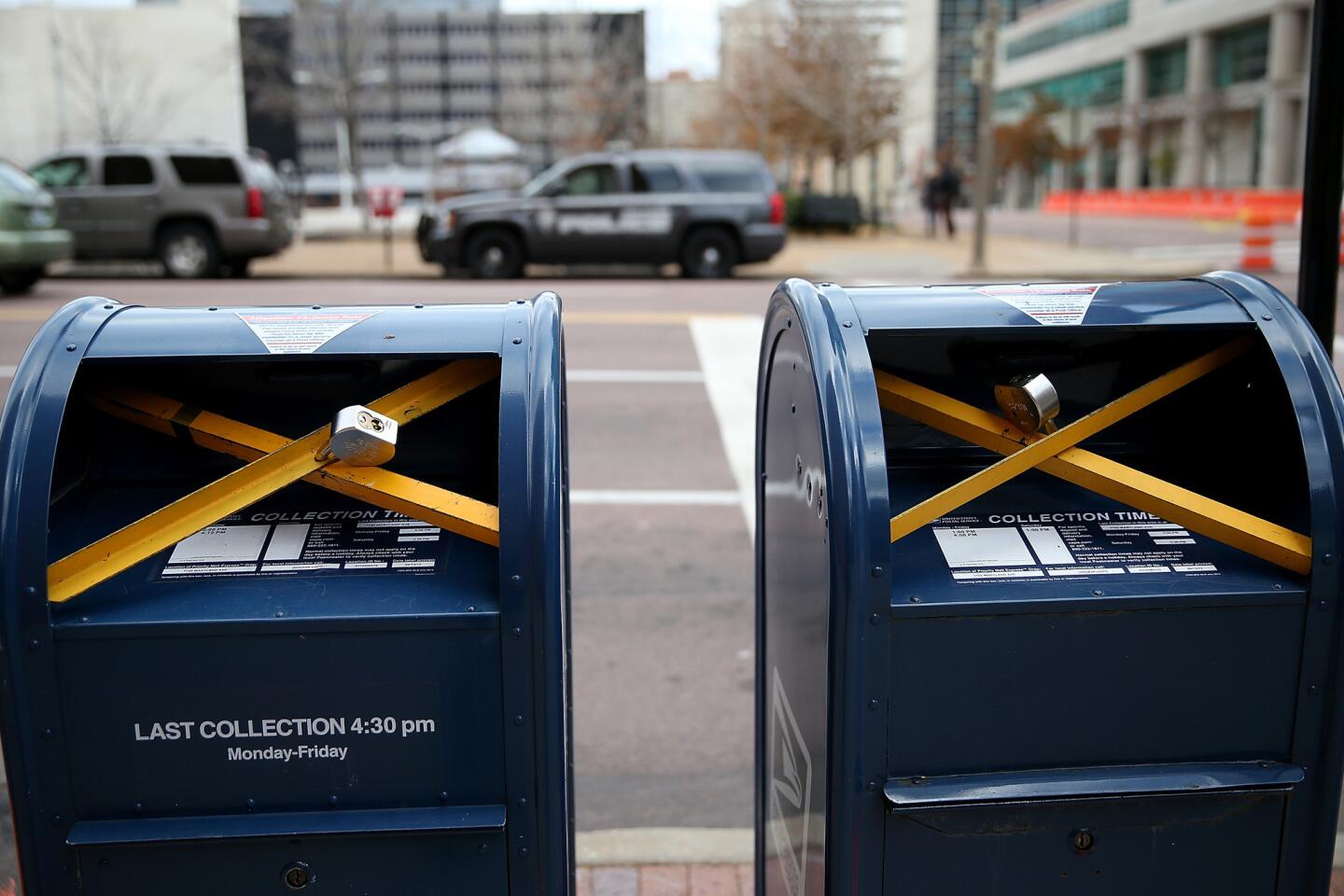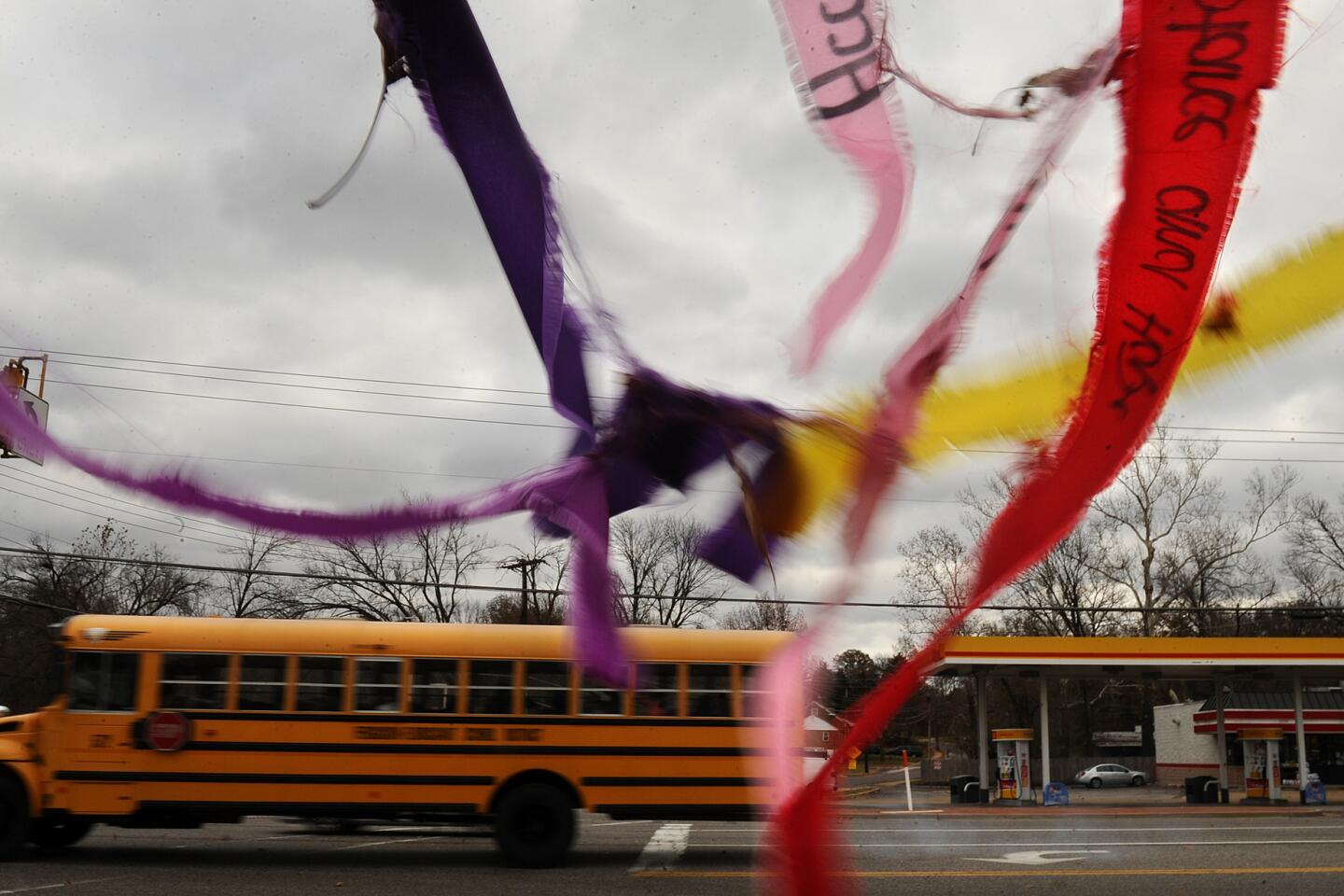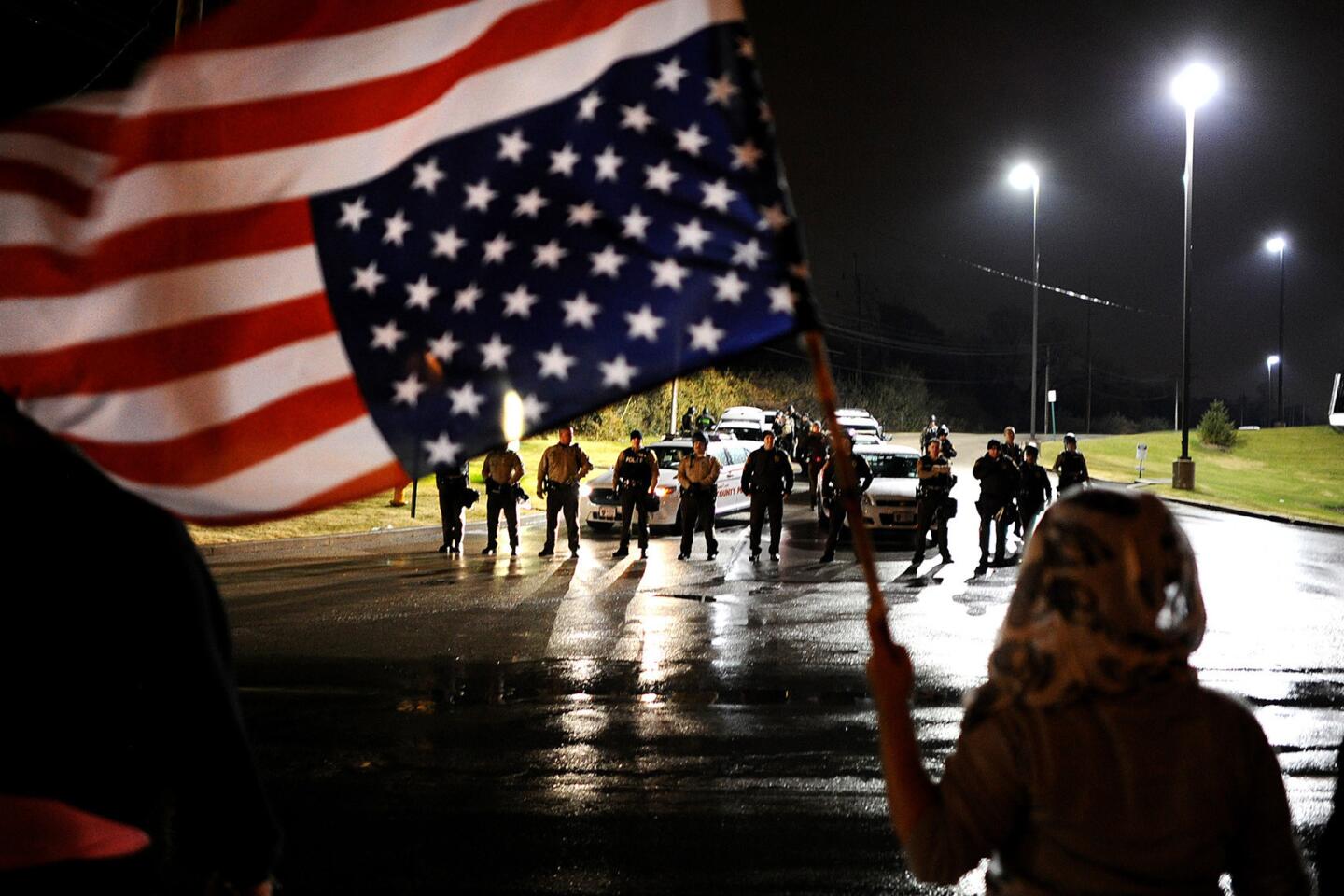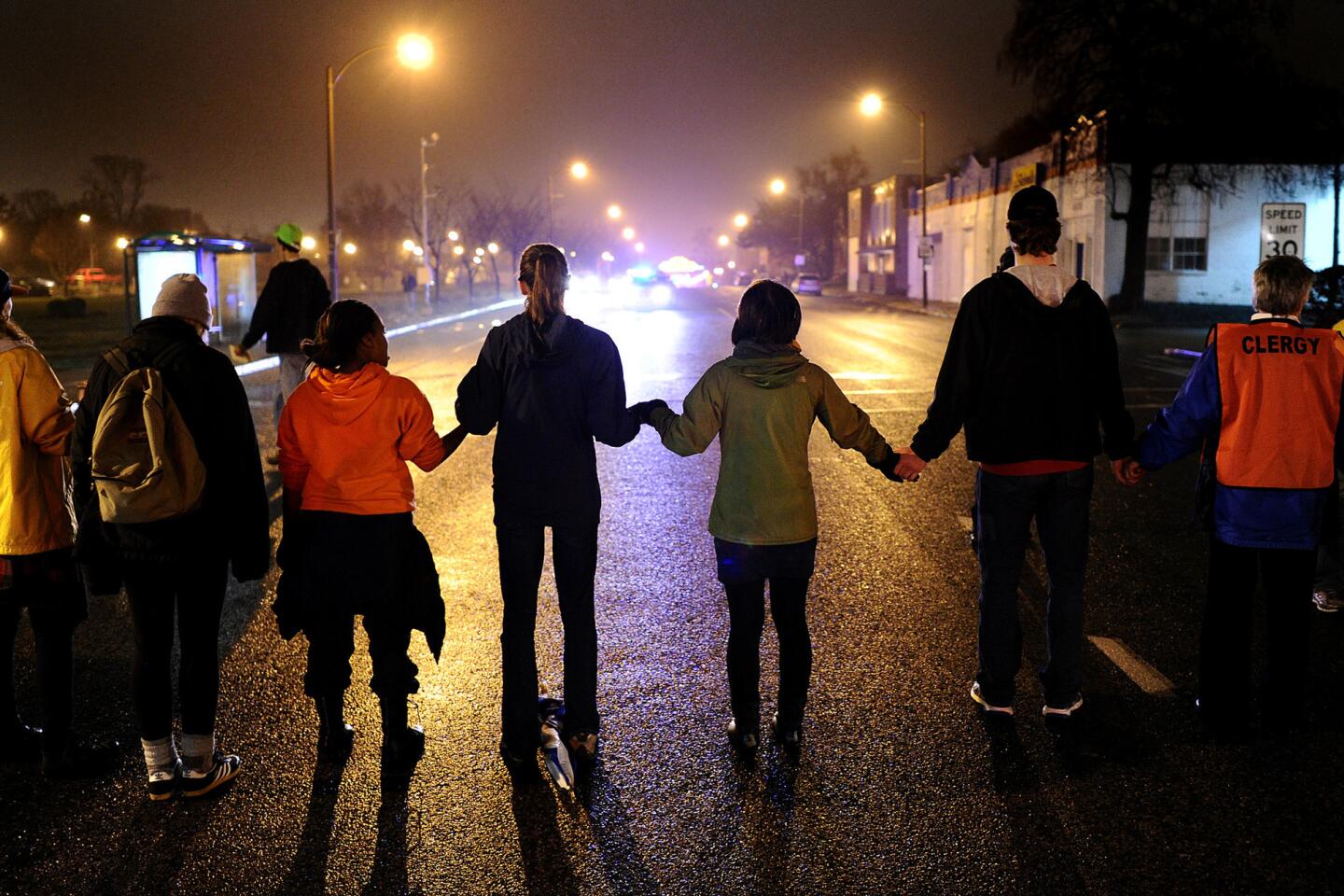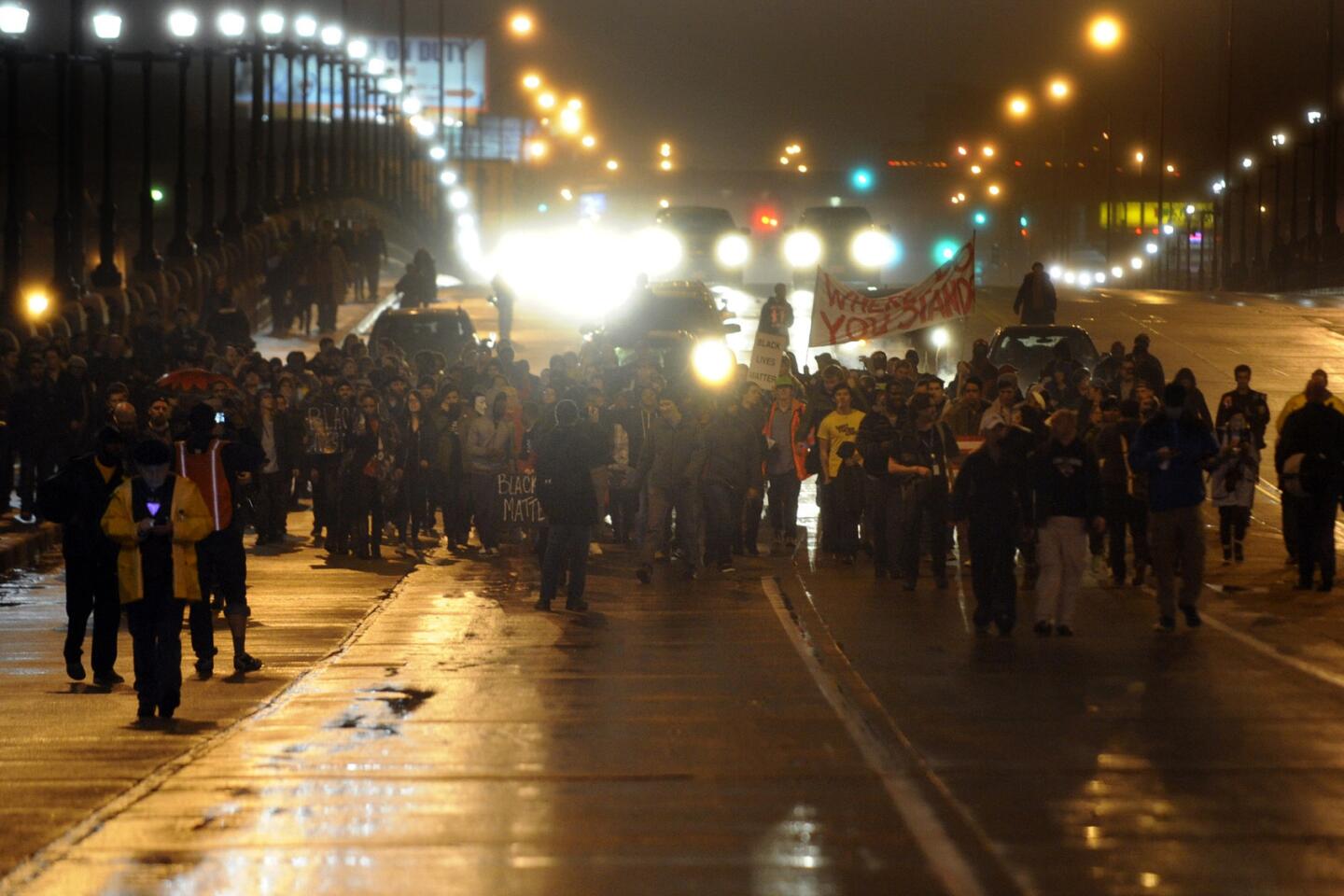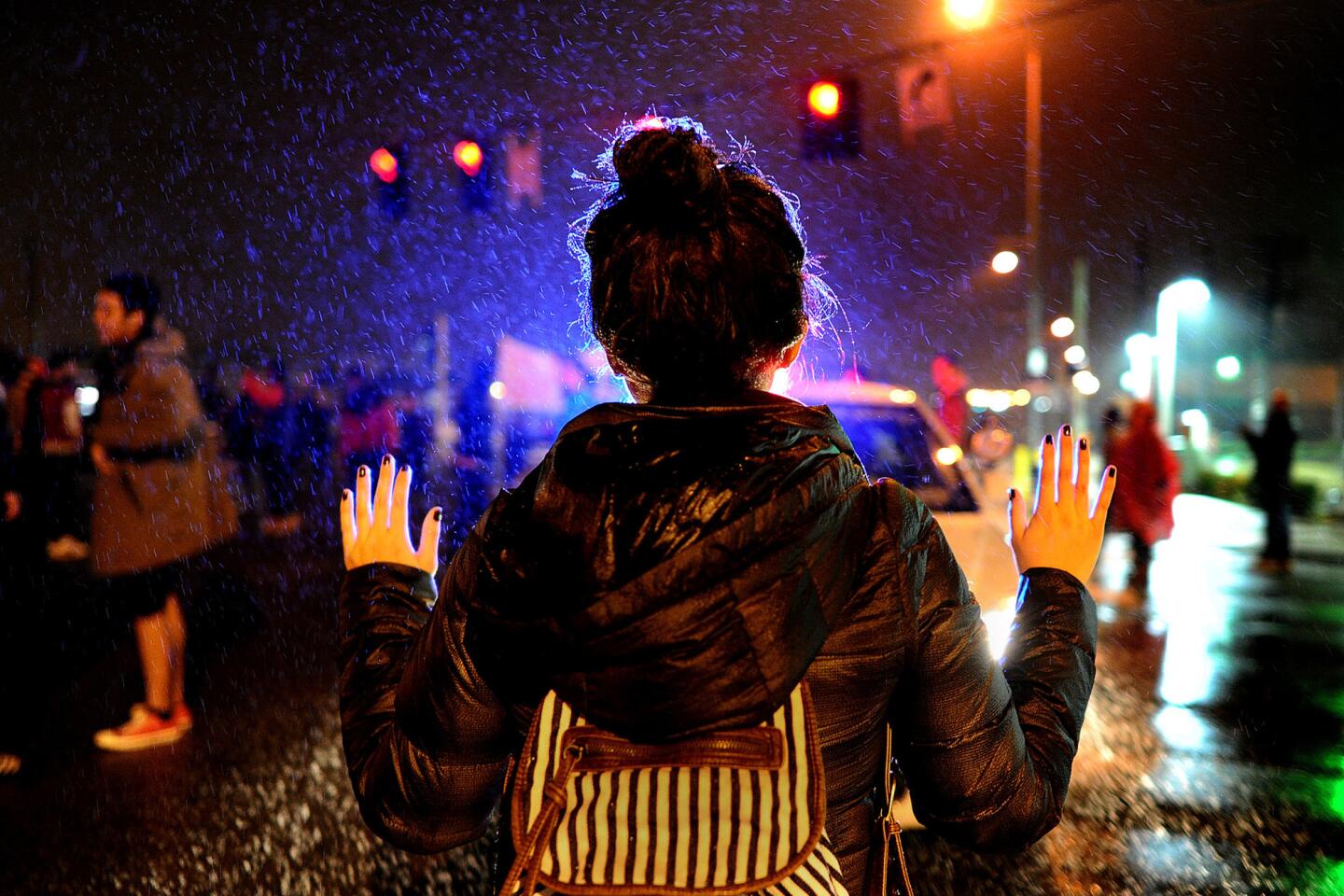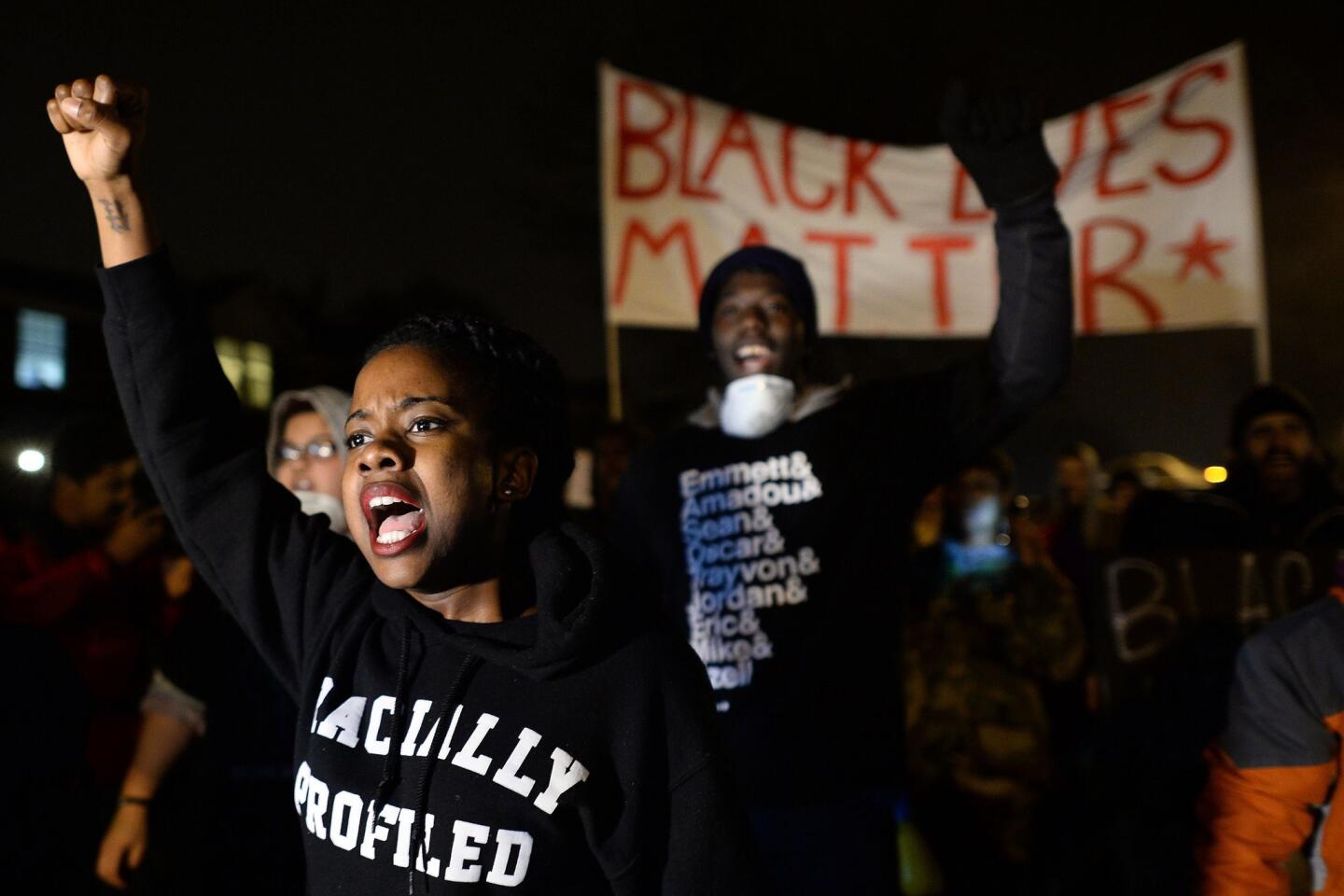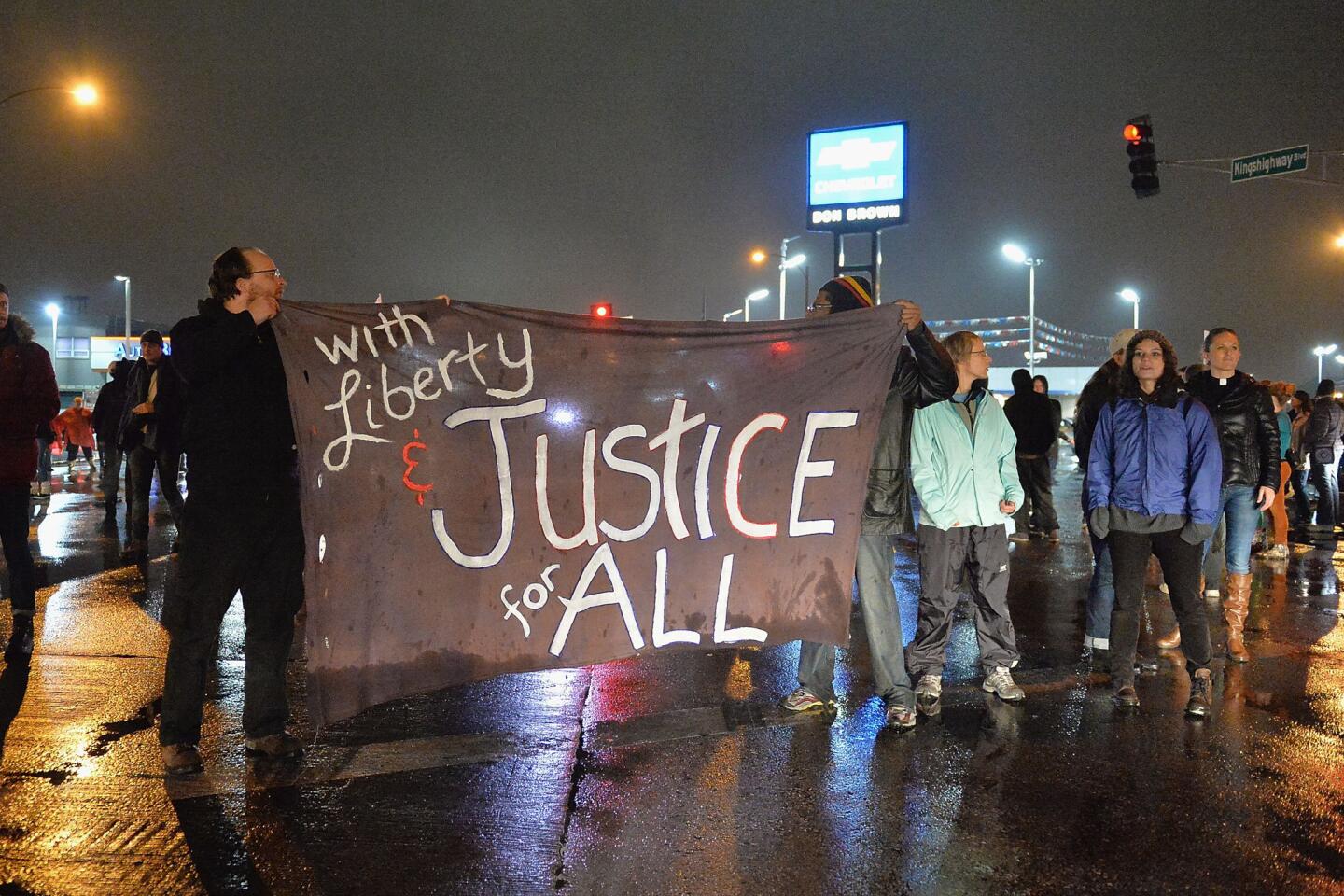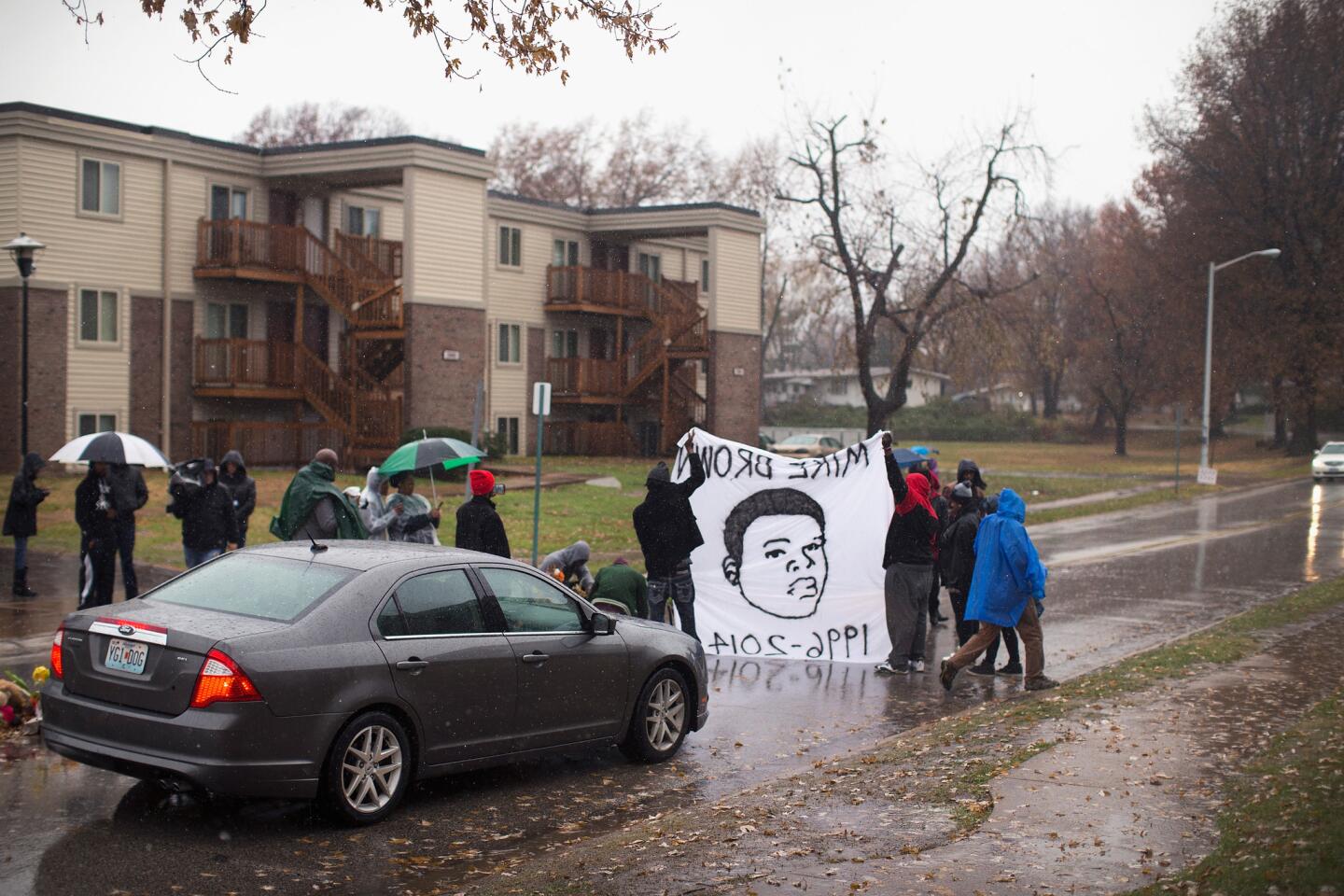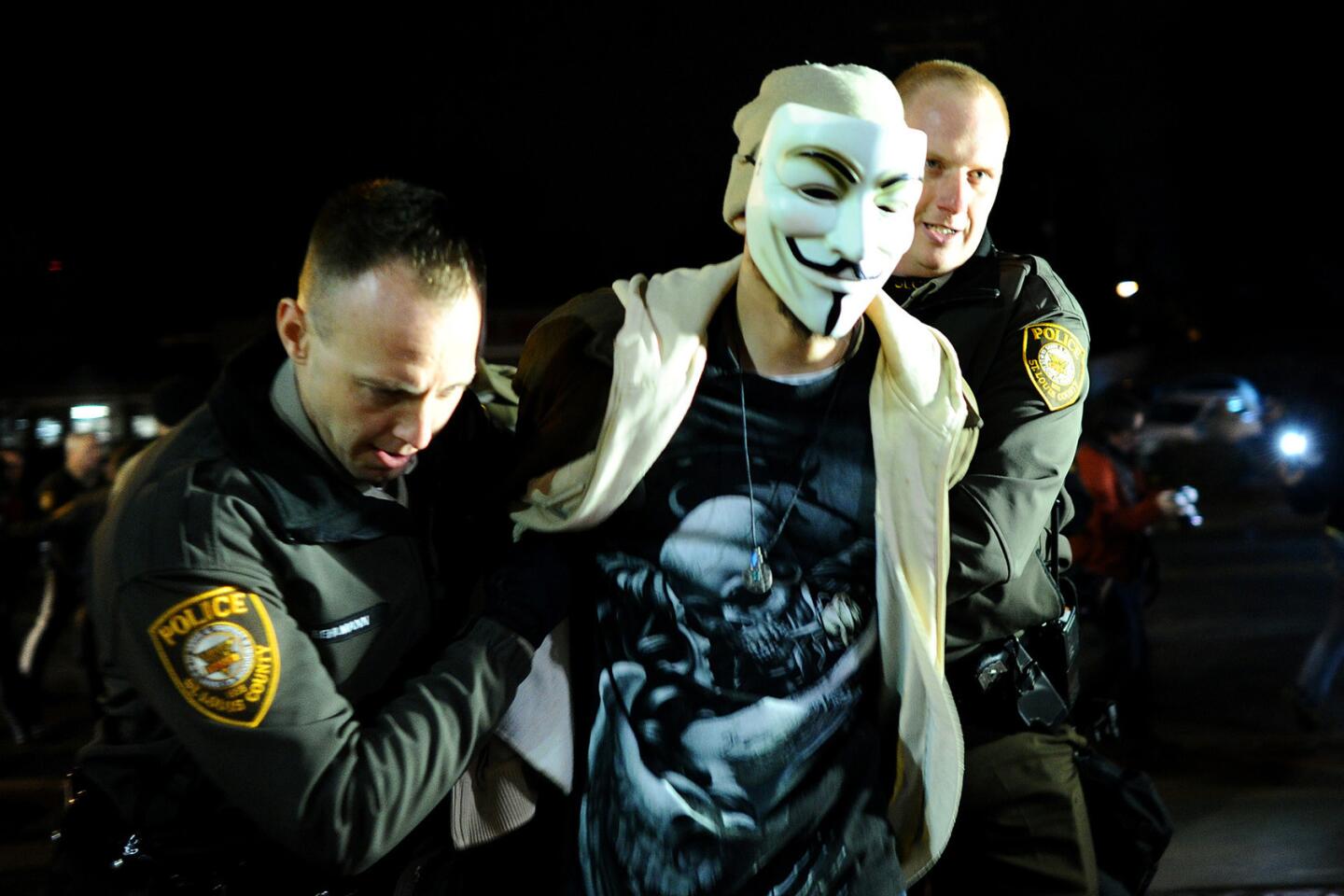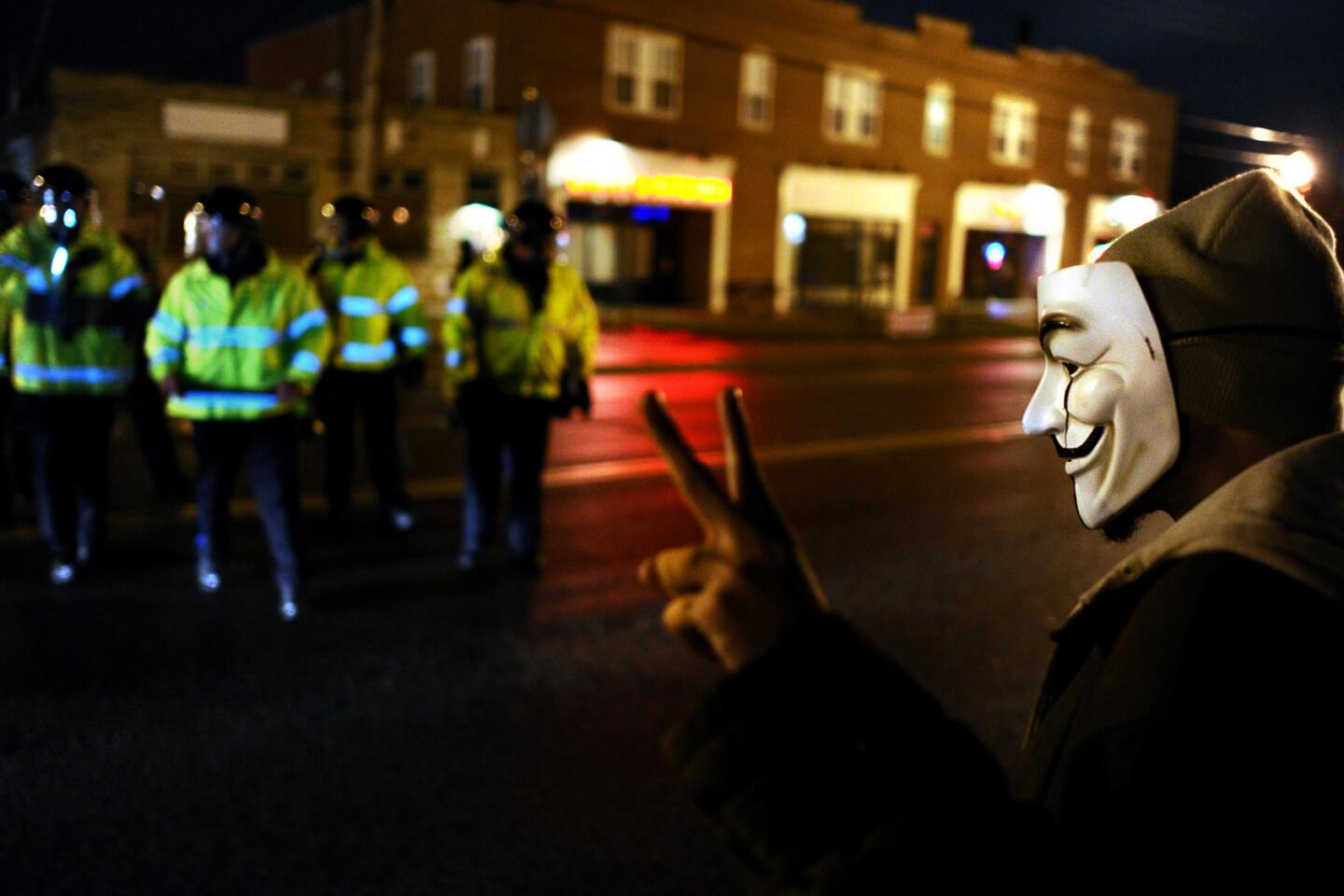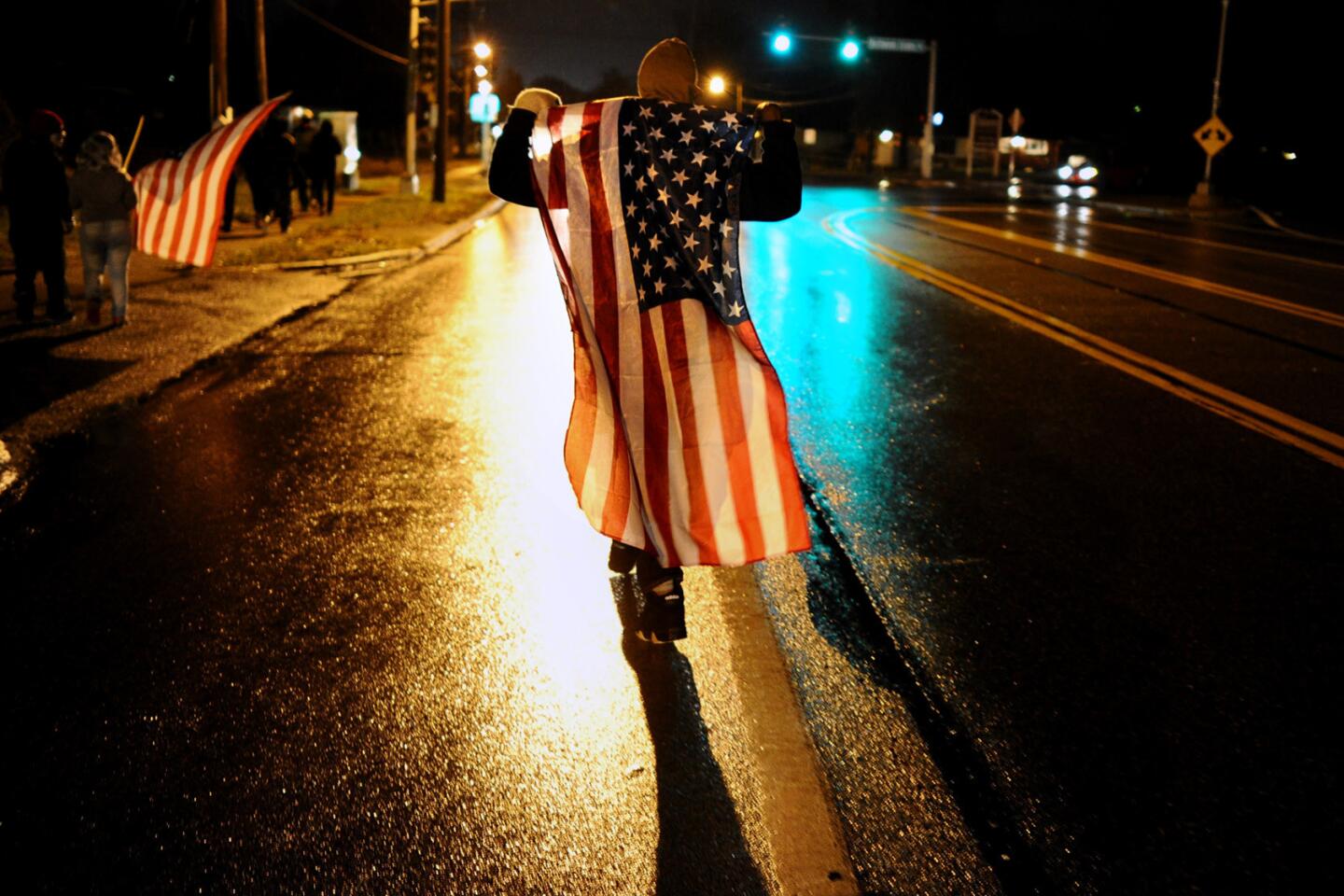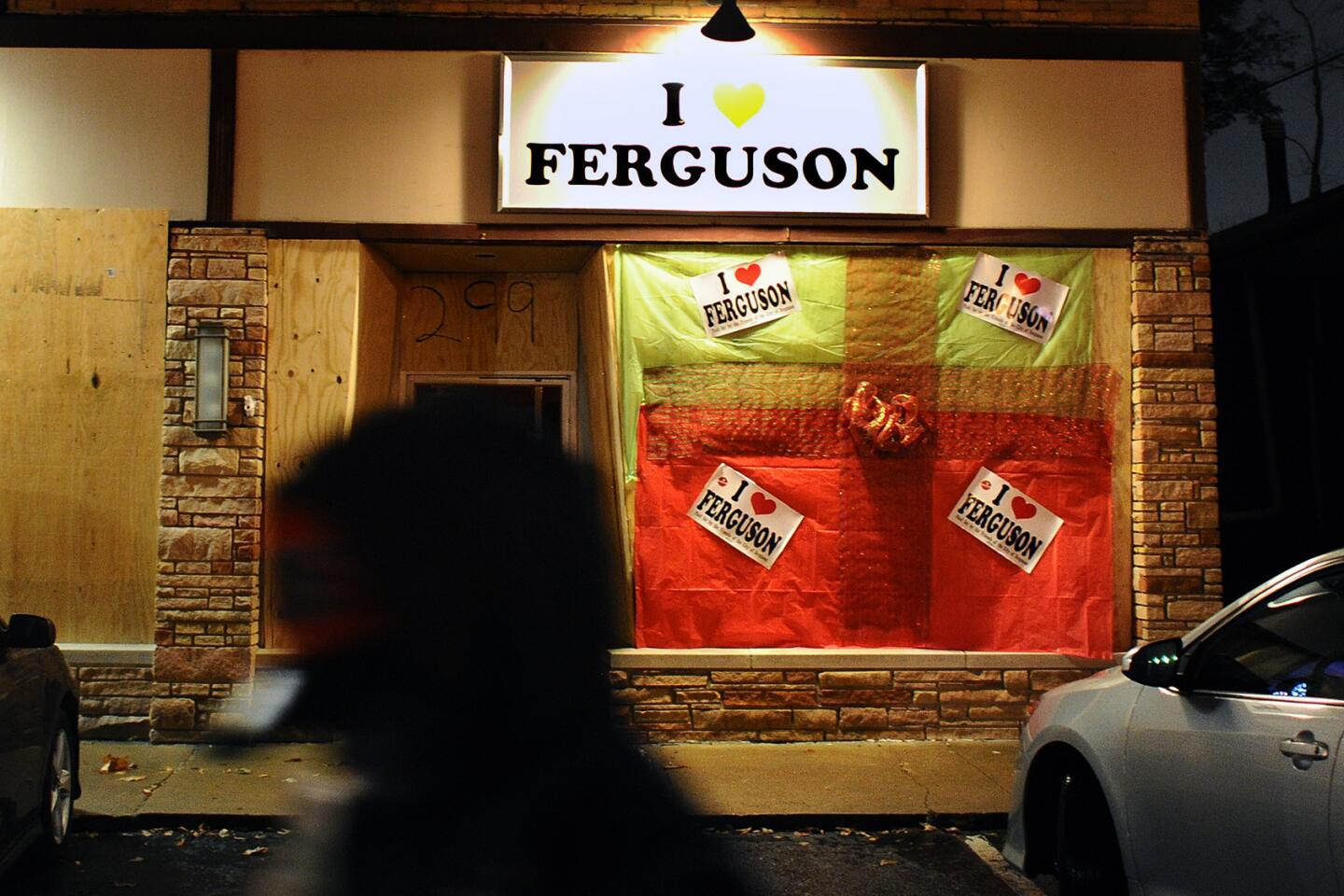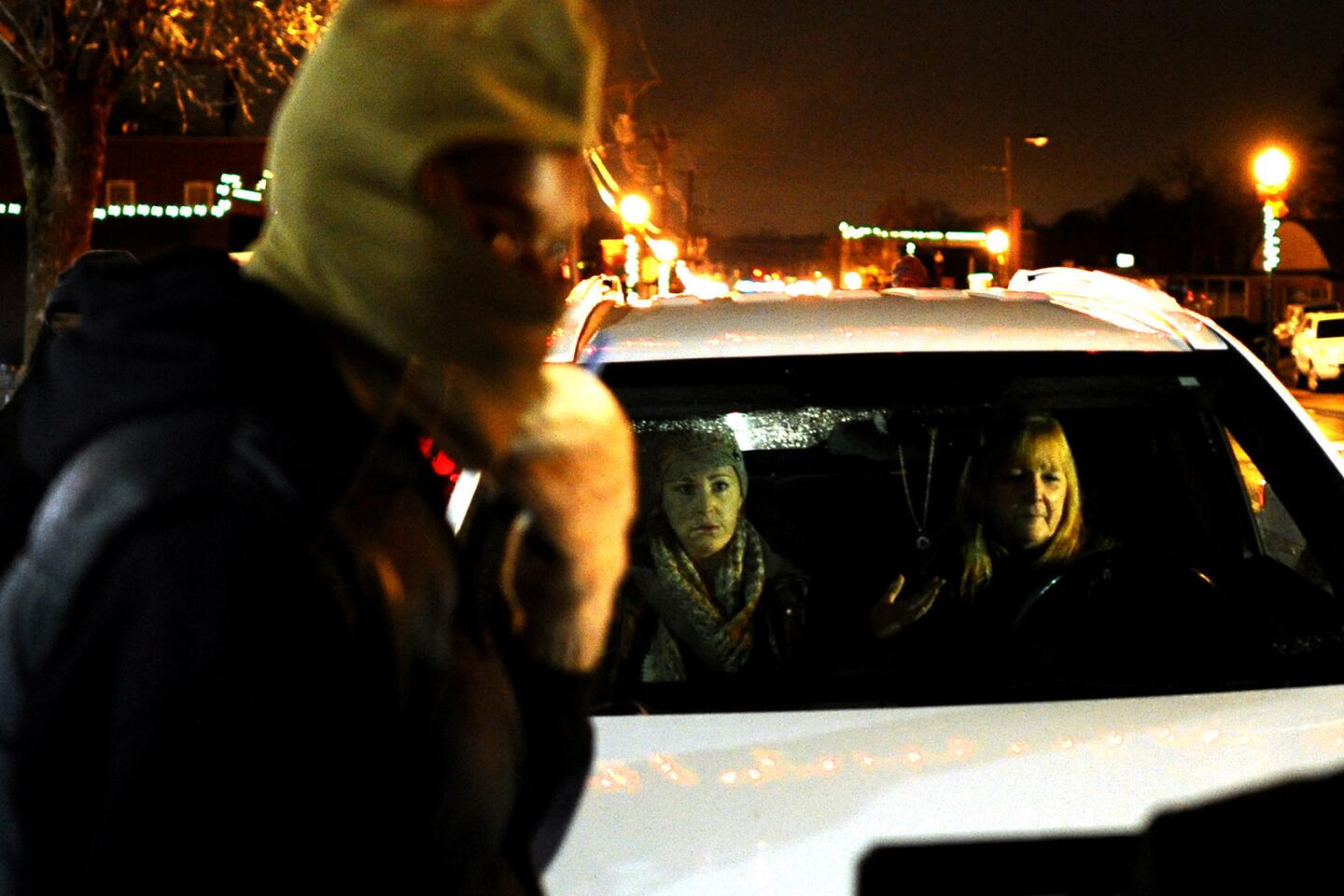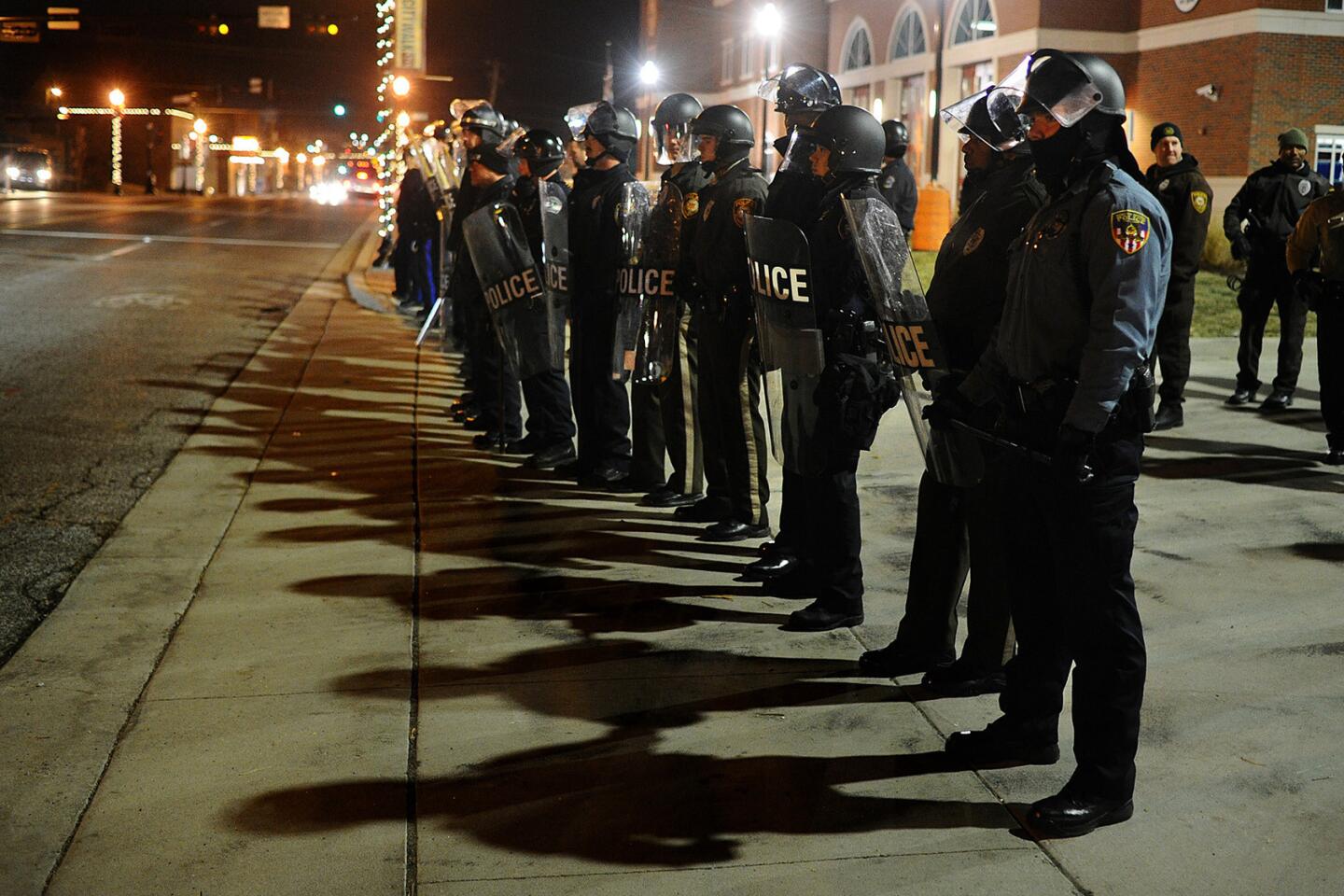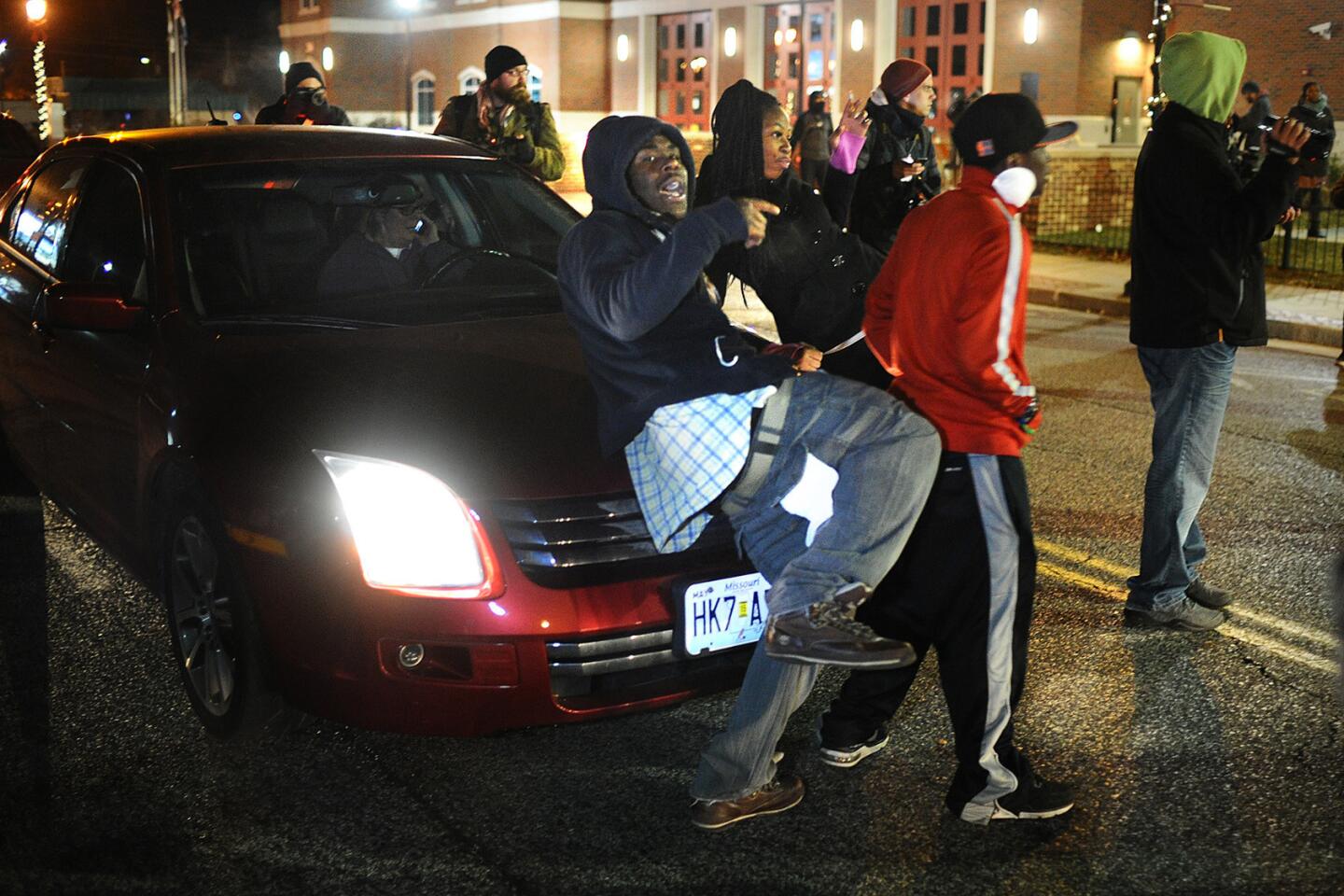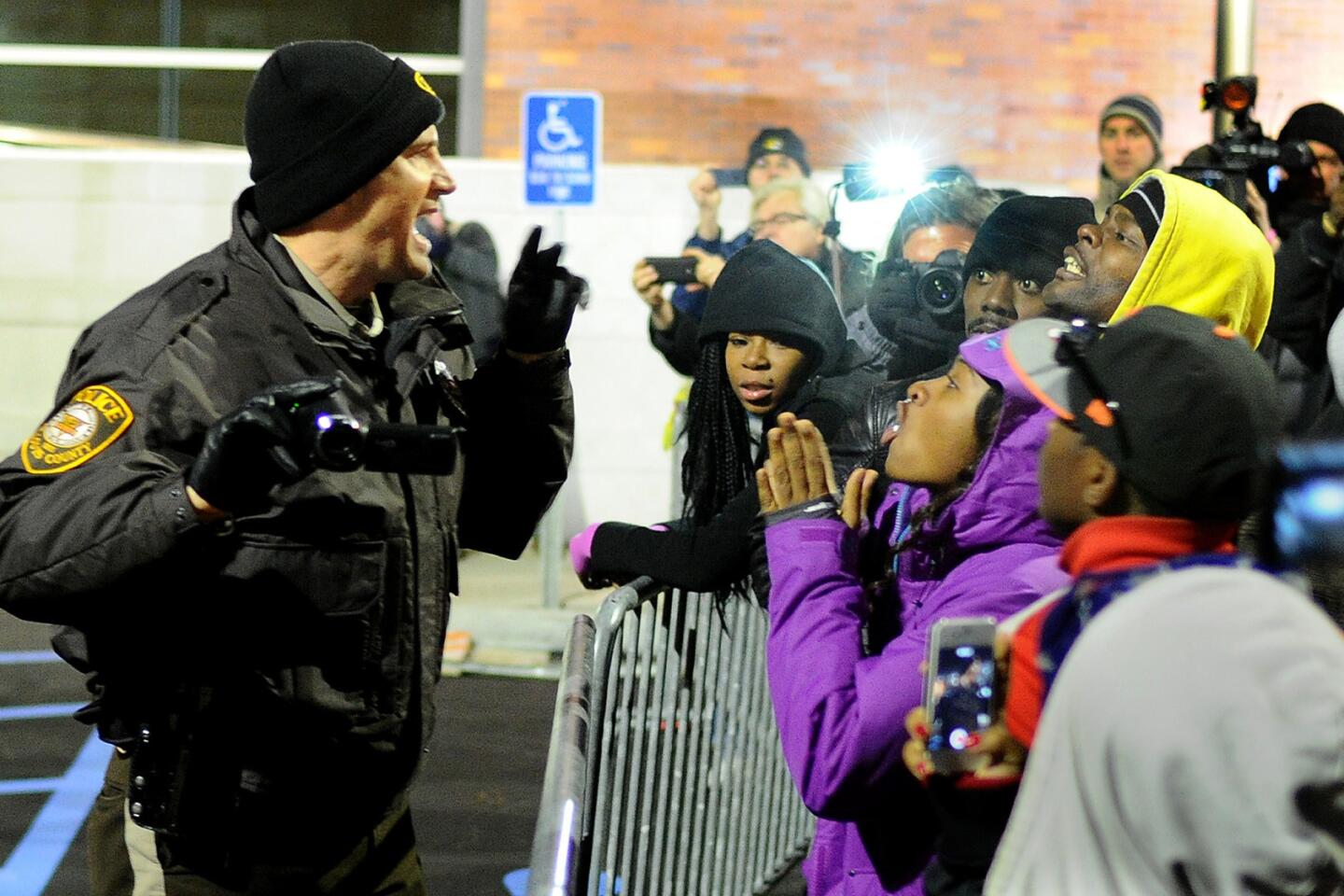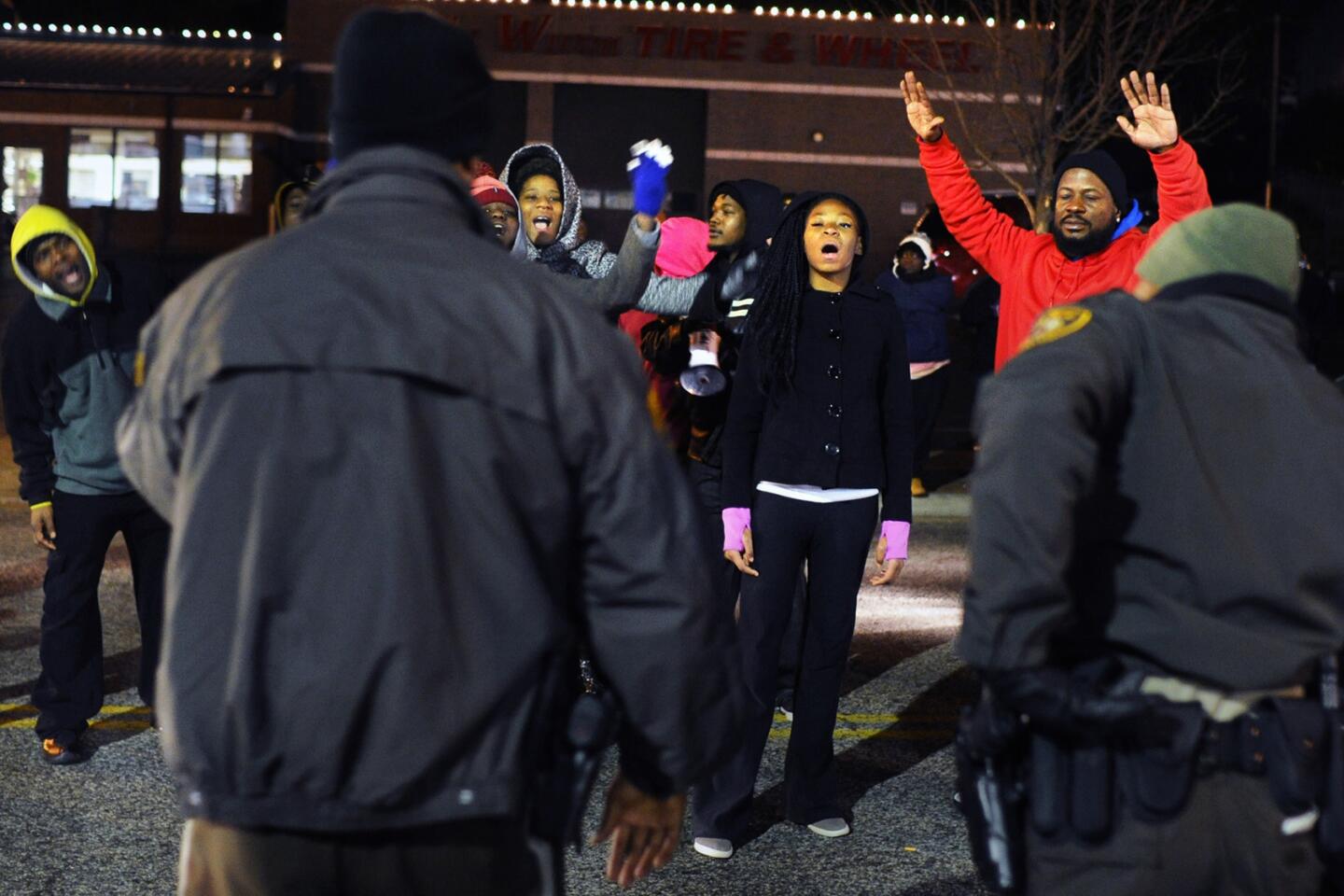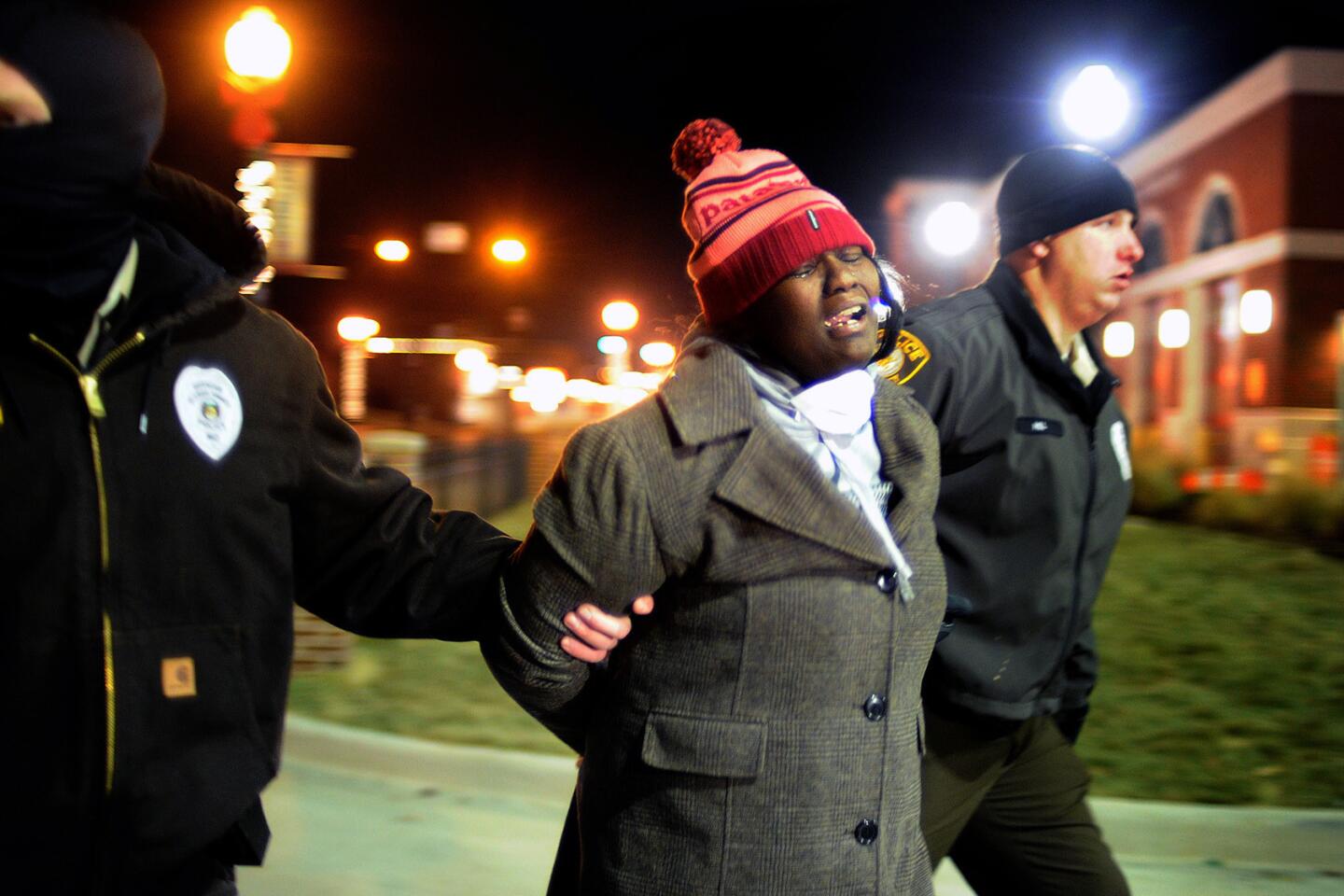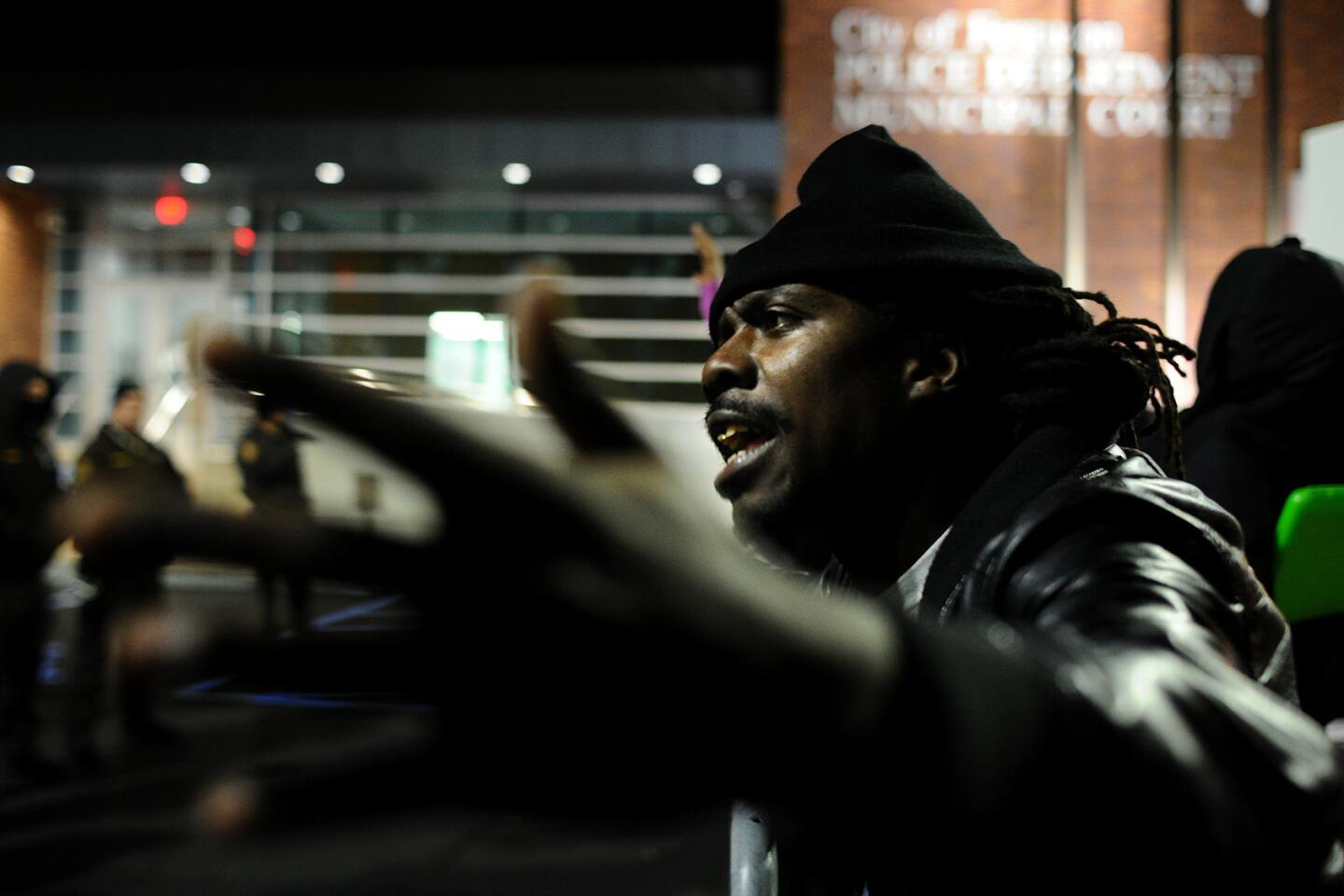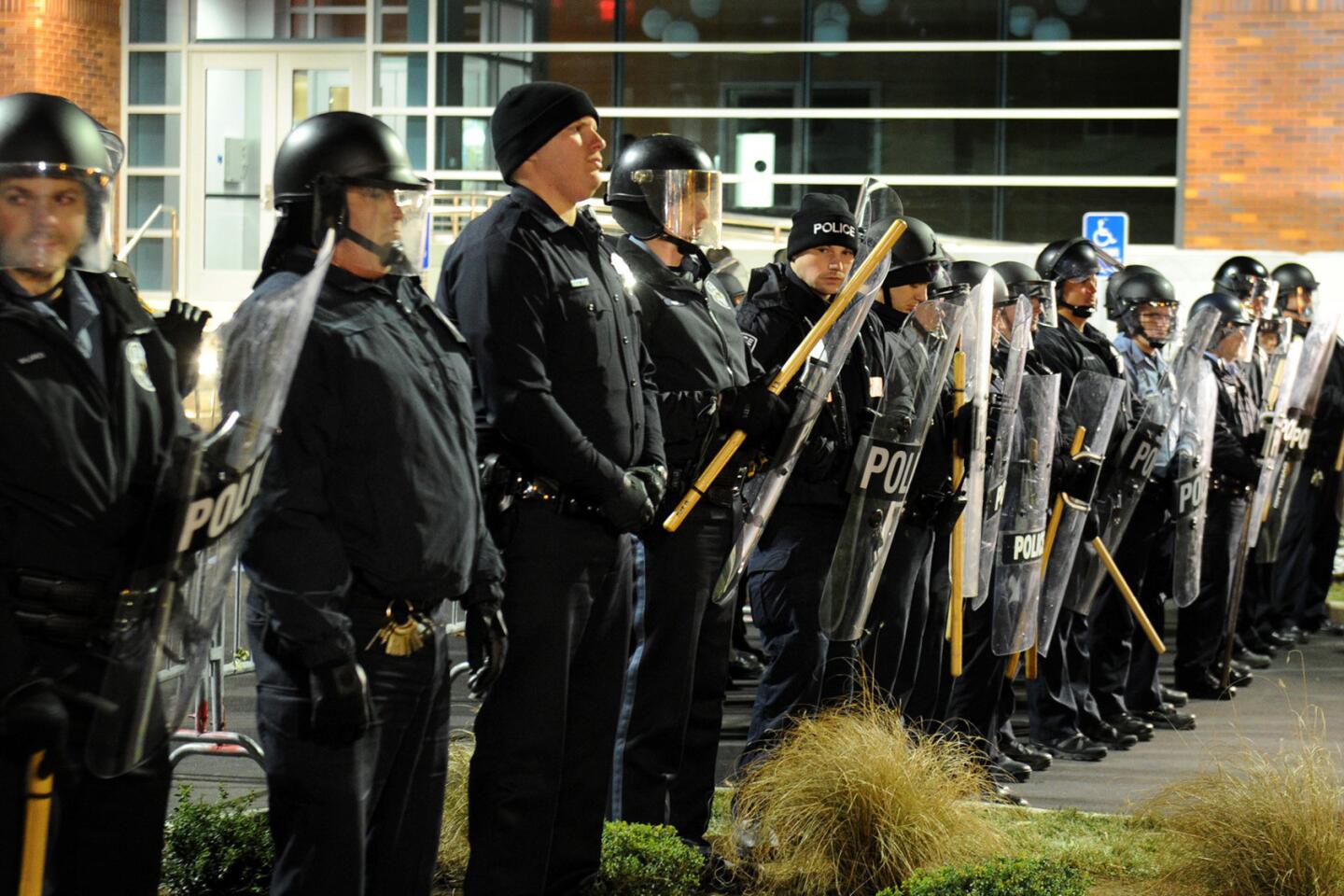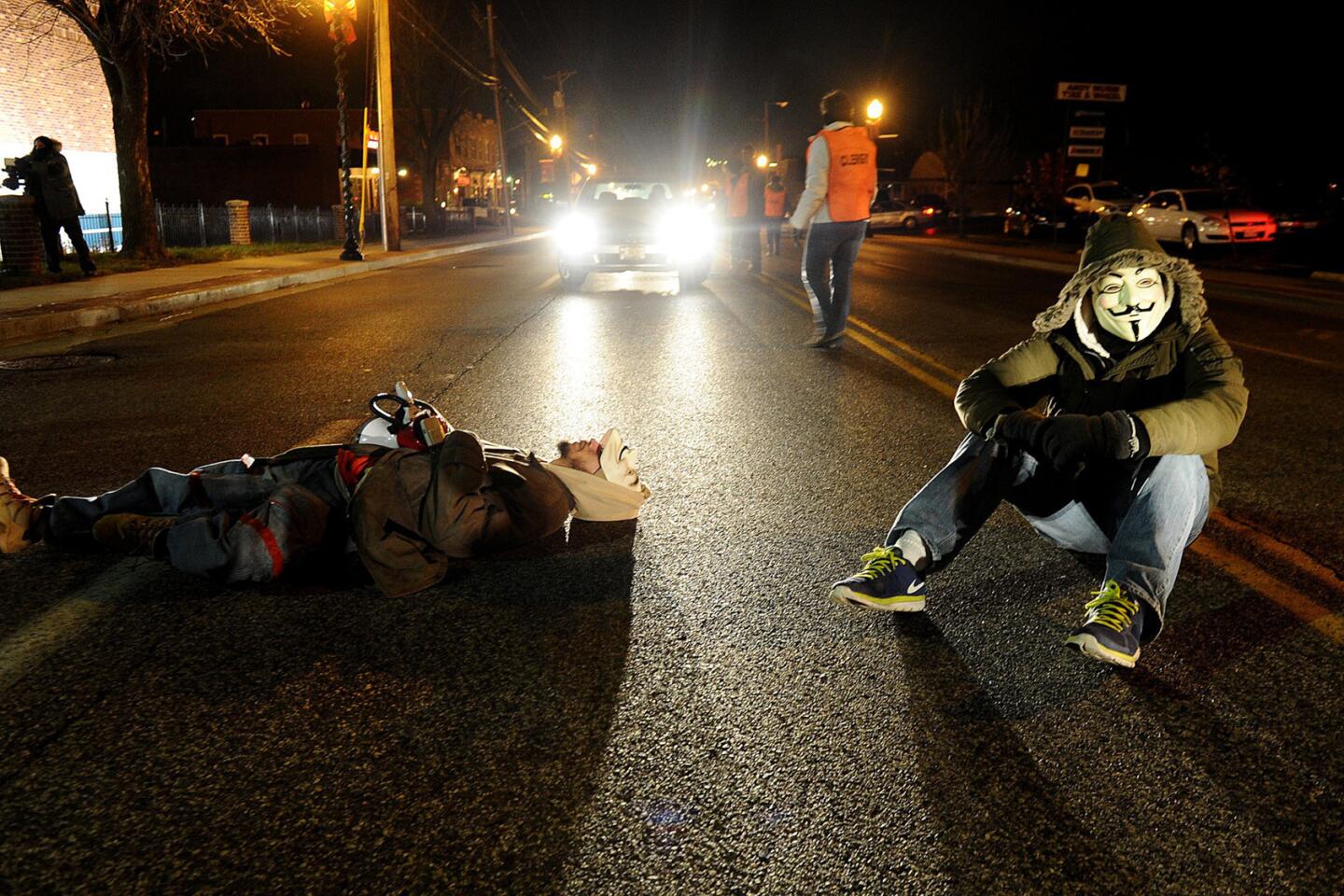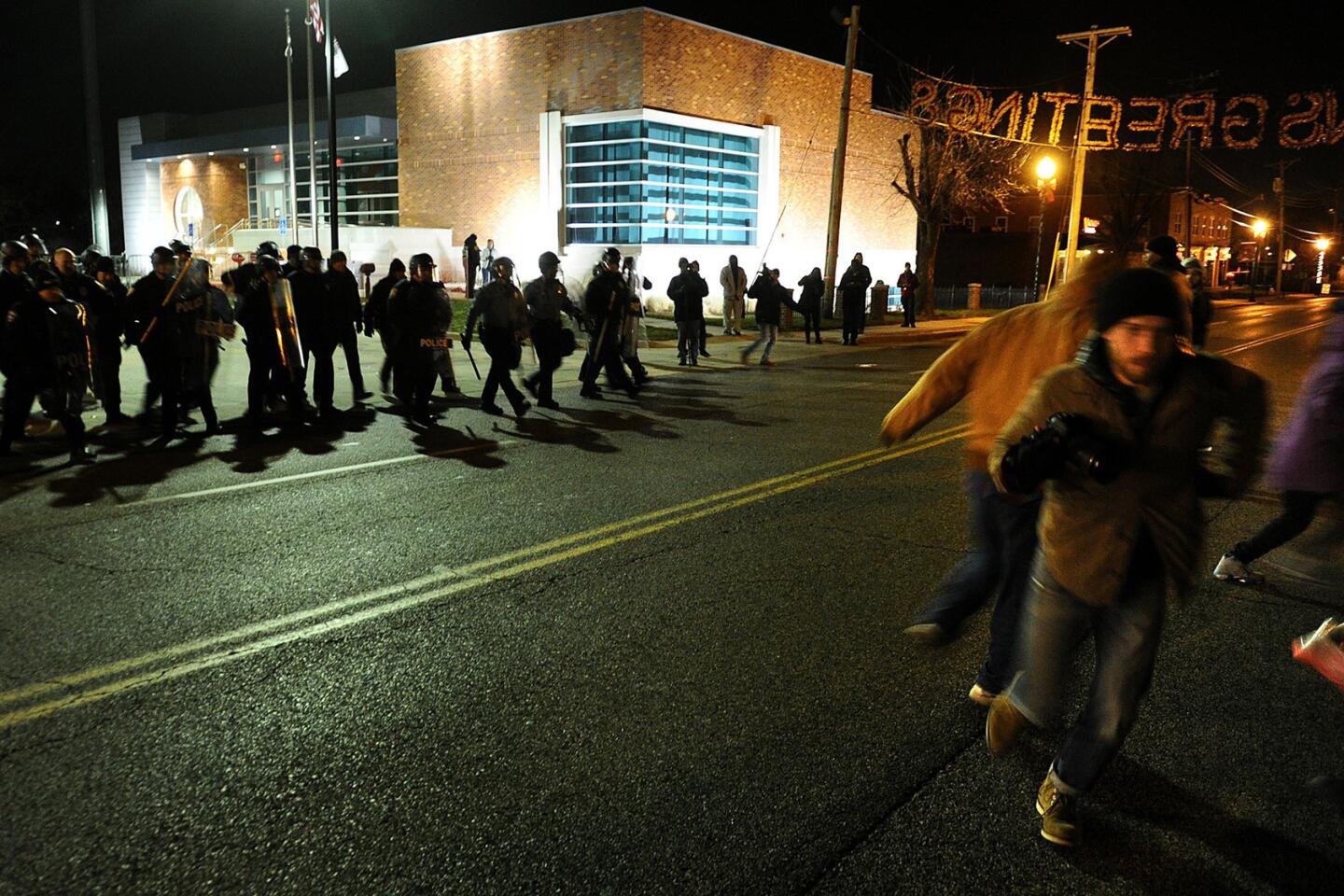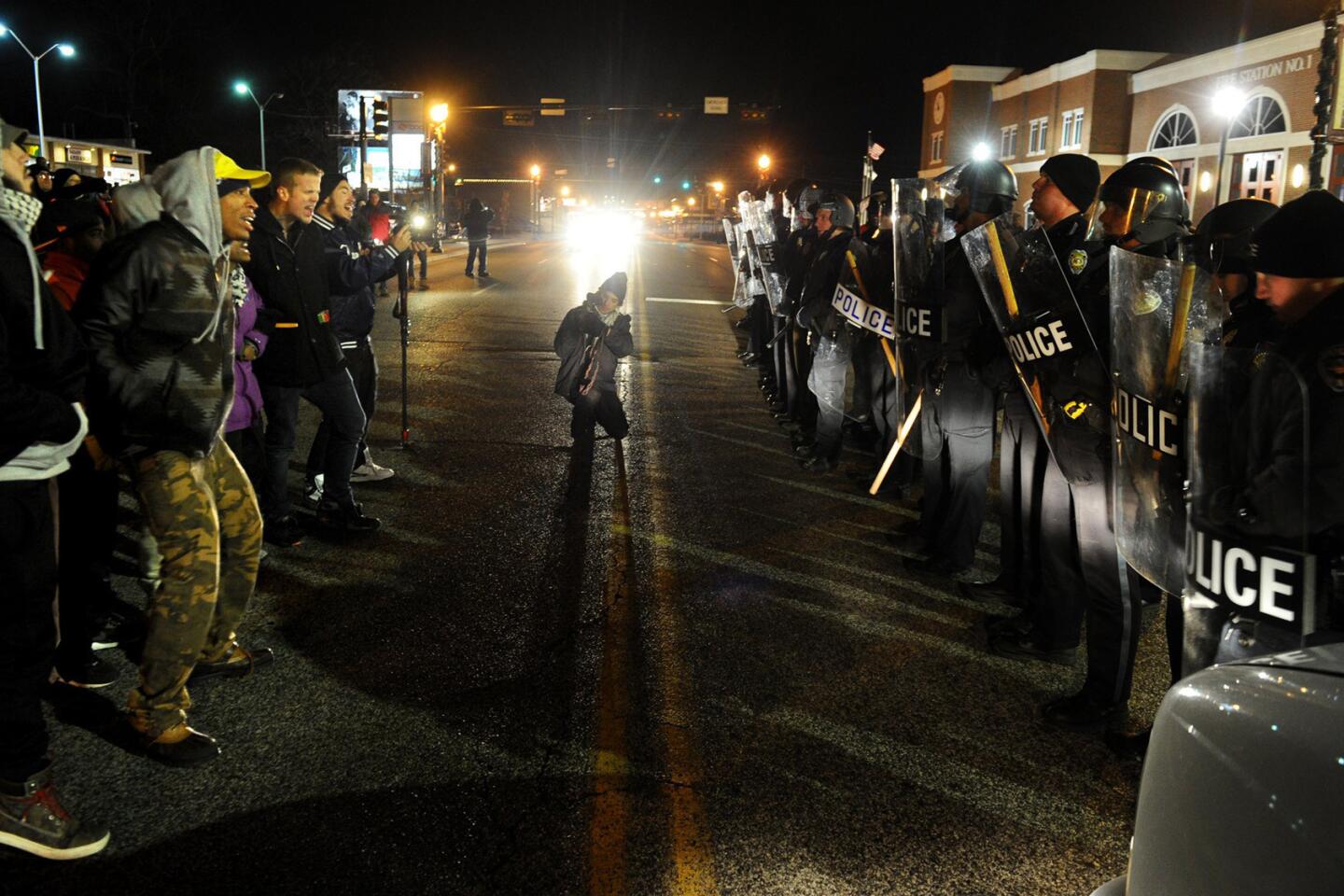Ferguson protest updates: Hundreds of arrests across nation follow grand jury decision
The protests that ensued after a grand jury decided not to indict Police Officer Darren Wilson in the shooting death of Michael Brown in Ferguson, Mo. have resulted in hundreds of arrests there and in cities across the nation. Brown's family and advocates have continued to criticize a decision they found devastating, and Missouri Gov. Jay Nixon has deployed thousands of National Guard troops in the Ferguson area.
Insights and analysis from our reporters and others in St. Louis during the aftermath of the decision are below. We are no longer updating here, but for more see full coverage of the situation in Ferguson, Los Angeles and around the nation.
Related stories:
Here’s what happened Tuesday in Ferguson
Demonstrations in Ferguson, Mo., had some ugly spots, but they were much calmer than the Monday night mayhem that erupted on the heels of a grand jury decision not to indict police Officer Darren Wilson in the fatal shooting of Michael Brown. More than 2,000 National Guard troops joined hundreds of police officers in the St. Louis area, and some protesters helped keep the peace, officials said.
St. Louis County Police Chief Jon Belmar said early Wednesday that 44 arrests had been made, including four felony arrests. The worst damage of the night was at and around Ferguson City Hall, where members of the crowd shattered windows, threw things at officers and badly damaged a police car. But it was a far cry from the night before, when at least a dozen buildings were burned and multiple police cars destroyed.
Meanwhile, many U.S. cities, including Los Angeles, New York and Washington, saw largely peaceful demonstrations. Several of those protests intentionally blocked traffic on freeways and major roads in honor of Brown, who was initially stopped by Wilson for walking in the middle of a street.
130 arrested in L.A. protests overnight
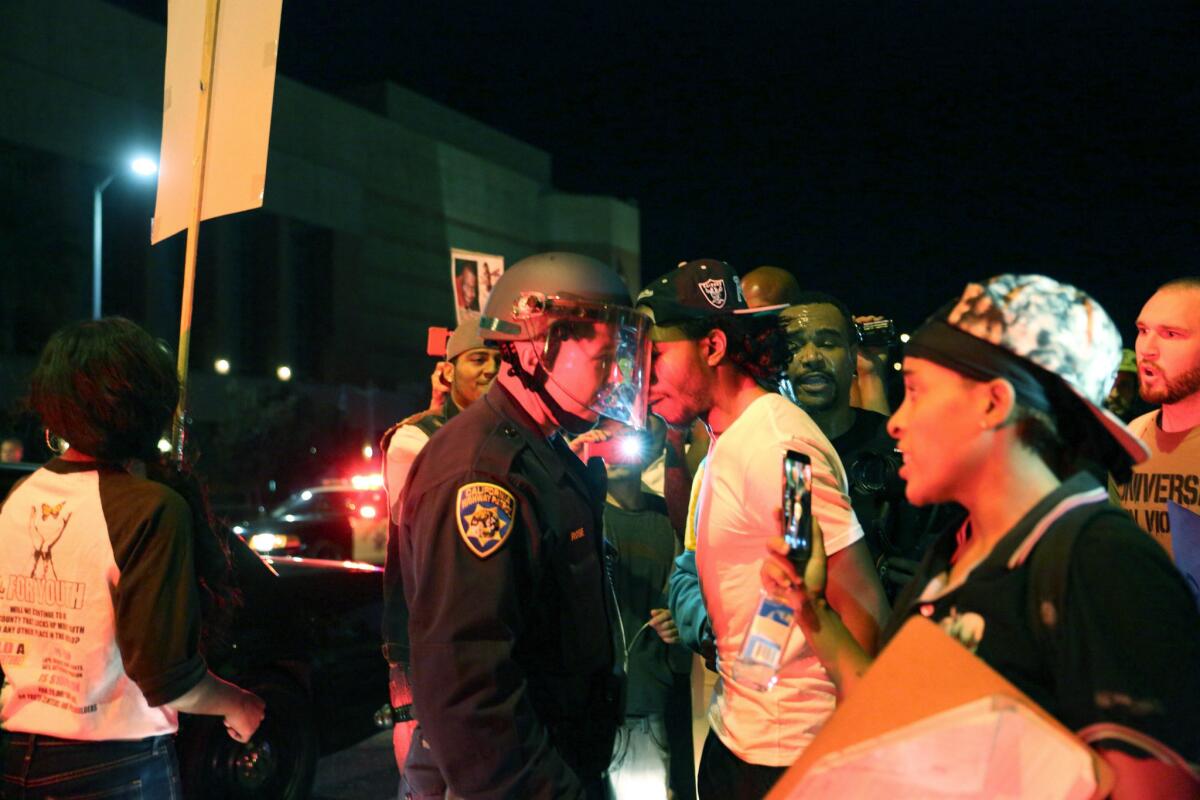
Marcus Yam/Los Angeles Times
Los Angeles police arrested 130 protesters overnight during a second night of demonstrations.
A large demonstration ended early Wednesday morning downtown when police officers in riot gear surrounded a group of several dozen protesters.
A much better night in Ferguson
44 arrests in Ferguson but no arson beyond car fire
Mostly quiet in L.A. but protesters take L.A. Live intersection
'Being silent is much worse'
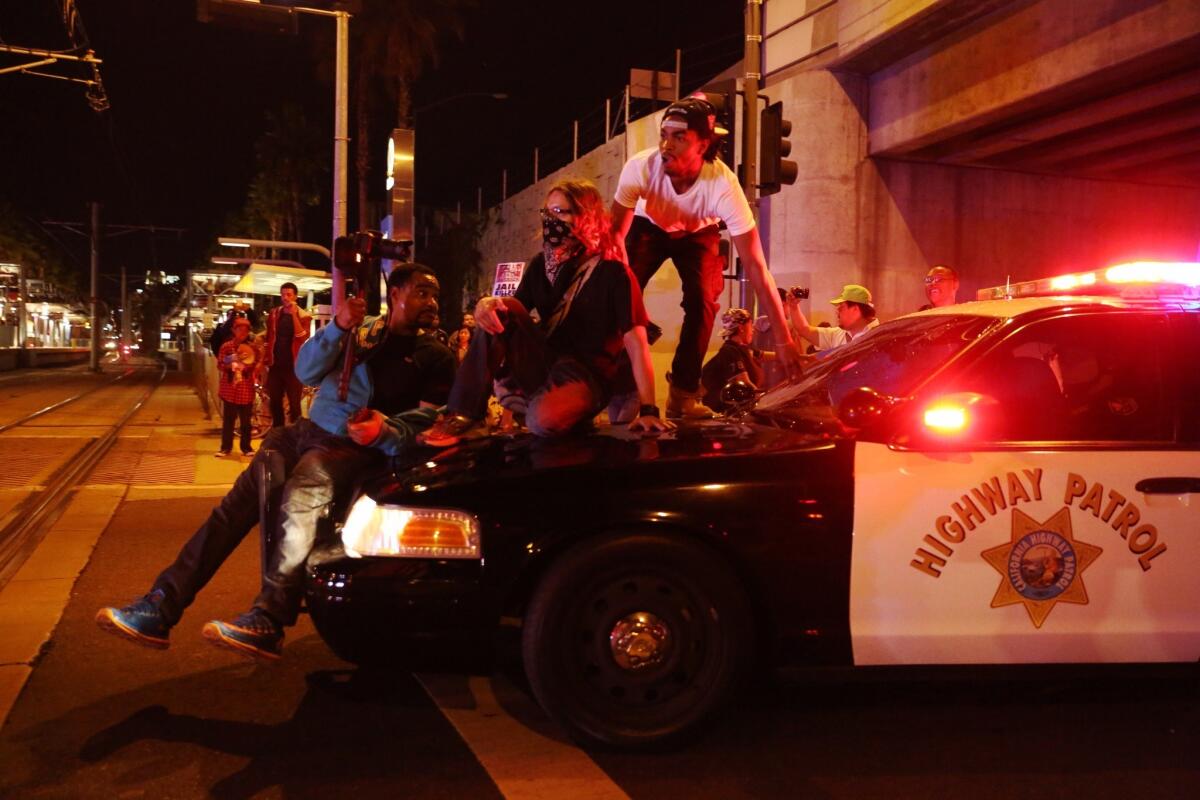
Marcus Yam / Los Angeles Times
Police declare crowds unlawful assembly in Ferguson
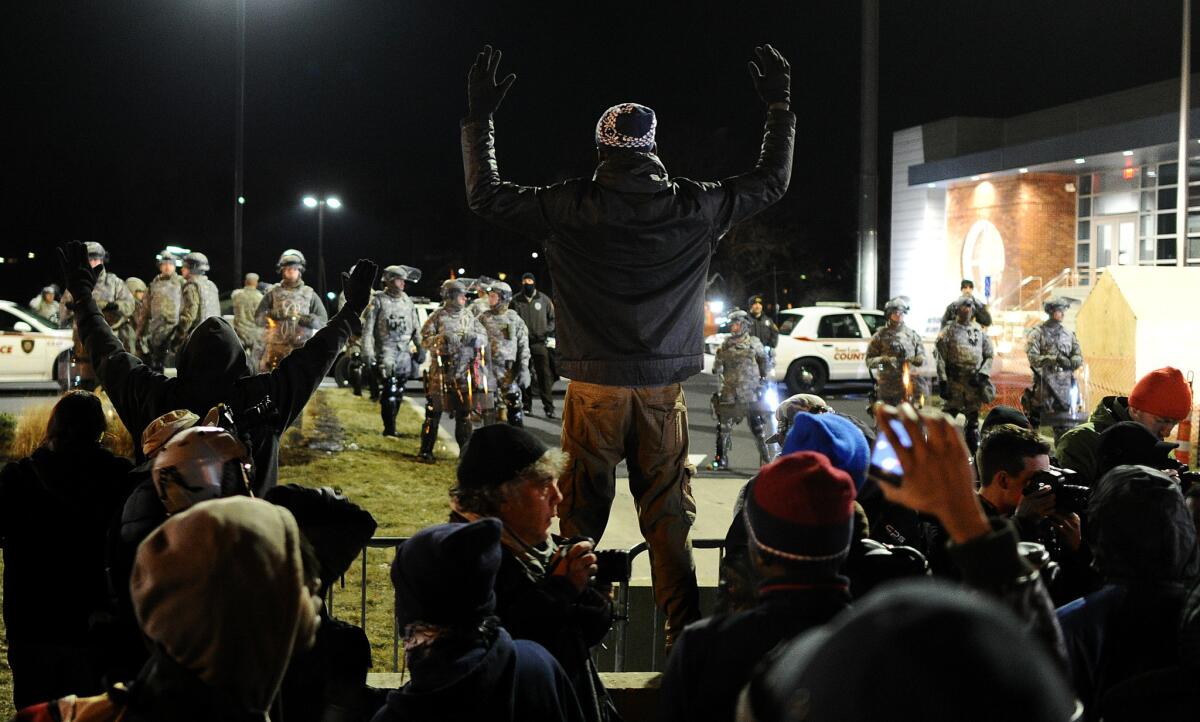
Wally Skalij / Los Angeles Times
Looting in Oakland
Looting has begun in Oakland. People could be seen breaking into a T-Mobile store and running out with objects in hand.
Another traffic jam in downtown L.A.
In downtown Los Angeles, drivers trying to escape the traffic jam on the 101 Freeway flooded onto side streets. As cars packed Cesar Chavez Boulevard, a small group of protesters lay down in an intersection and caused another traffic jam.
One man screamed at police, who were directing traffic and trying to control the flow of the protesters.
“Want to kill someone? Kill me, not some innocent bystander!” he said.
Protesters previously placed roadblocks and debris in the lane and stopped traffic in both directions. After a brief standoff, police allowed the demonstrators to disperse north along Grand Avenue.
After a night in jail, protester back on Ferguson streets
Trey Yingst was arrested for unlawful assembly outside Ferguson Police headquarters on Saturday. He spent the night in jail but on Monday and Tuesday nights he was back on the streets documenting the violence.
Clutching his camera as police and protestors continued to clash for position on the street, exchanging blasts of pepper spray with hurled objects, he said he won't let the police chase him.
"I won't be deterred by tear gas and I won't be deterred by arrest," said Yingst, a photographer with an organization called News2Share who drove here from Washington D.C.on Friday. "I think my first amendment rights are too important."
Police are now declaring the protest outside police headquarters an unlawful assembly and are threatening arrests again.
Police use pepper spray on Ferguson crowd
The police pepper sprayed the crowd, who were near a sidewalk. The crowd is once again throwing things.
Protesters block 101 Freeway in downtown L.A.
As the demonstration outside Los Angeles police headquarters began to ebb, protesters blocked the 101 Freeway nearby.
About 100 protesters are in both eastbound and westbound lanes of the 101 Freeway at Grand Avenue in downtown Los Angeles, a California Highway Patrol spokeswoman said. The protesters placed roadblocks and large pieces of metal debris into the lanes and stopped traffic in both directions, she said.
As of 9:45 p.m., the obstruction was mostly clear.
Meanwhile, some protesters remained near police headquarters. Most continued to yell at police. Objects were thrown at police multiple times, but as of 9:25 p.m., no arrests had been been made.
Shoving between cops, protesters in Ferguson
Police and protesters started shoving again outside police headquarters and two men were tackled to the ground and arrested.
The police rushed the crowd on the sidewalk with tear gas and grabbed one man who was standing with his hands up.
Demonstrations in Boston, Portland, Denver and Dallas
In Boston, about 1,500 protesters marched through the streets. Some of them tried to get onto Interstate 93 but were stopped by a line of police guarding the onramp, a police spokesman said. There were several arrests late Tuesday for disorderly conduct, he said.
In downtown Portland, Ore., a group of 200 protesters broke off from a peaceful march, briefly blocked traffic on Interstate 5 and began throwing rocks and bottles at police officers, according to police. One driver stuck in traffic near downtown Portland was punched in the face when he honked at a protester, police said. There have been about 10 arrests.
In Denver, police said they used pepper spray “on a small group” of protesters and arrested three people when a crowd refused to disperse near Colfax Avenue and Interstate 25.
And in Dallas, Interstate 35 was briefly closed by protesters and reopened shortly before 10 p.m., according to a police spokesman.
Arrests in the St. Louis area
This list of people arrested Monday and Tuesday, provided by the St. Louis County Police Department, includes hometowns, ages and the charges they might face.
'That’s what they want, to instill fear'
Two young women who drove to Ferguson from St. Louis on Tuesday for their first night of protests since the Michael Brown shooting left after dark amid tear gas.
Courtney, who said she was afraid to give her last name with so many police nearby, was forced back from City Hall by officers as tear gas filled the air and left her coughing and choking.
The petite blond said she had been worried about venturing out late, but felt the protest was too important to miss: “Something inside me just said, ‘Let’s go.’”
Her friend Michele planned to return, possibly late Tuesday, unwilling to give in to what she saw as police scare tactics.
“That’s what they want, to instill fear. And it’s not what they’re going to get,” she said, “It’s important to show them that people won’t stand down.”
L.A. protest impassioned and peaceful
'This is now considered an unlawful assembly'
Shortly before before 10 p.m. in Ferguson, a large crowd outside police headquarters marched to nearby City Hall, where two men banged on the front door, screaming, “We want answers!”
Soon after, people in the crowd started throwing bricks through the windows.
They surrounded an empty police car parked in front, rocked it back and forth, smashed all the windows and set it on fire. Gunfire sounded, and several Red Cross officials nearby said there was ammunition in the car that had been set off.
Police showed up and forced people to the sidewalk as tear gas spread around City Hall. People in the crowd started choking, screaming and crying.
St. Louis County police arrived in armored vehicles and ordered people to the sidewalk, threatening to arrest those in street who did not comply and snatching up a woman who knelt in the street, hands up.
Tear gas in Ferguson
People in the crowd near Ferguson City Hall are screaming and trying to find their friends.
Tone in Ferguson fluctuates quickly
Something went off in the center of the crowd outside Ferguson police headquarters, leading police to move forward.
Dan Goodson, a St. Louis-area pastor, said that it was a small smoke bomb and that it hit him in the back.
Protesters seemed to believe it was thrown by one or their own. Police advanced and pushed the crowd back near the sidewalk adjacent to the building.
Live ammunition in the police car began to explode, and a neighbor came outside and screamed, "There are kids here!"
March reaches L.A. police headquarters
In Los Angeles, some protesters have allowed their frustration to bubble to the surface, becoming confrontational. But for the most part, the crowd has remained peaceful while marching from Freedom Square in the Crenshaw area toward downtown.
And in other cities ...
In Washington, about 400 protesters marched through the city for hours, a police spokesman said. Protesters briefly entered a Wal-Mart store but left peacefully. They made their way to the White House, where they stood outside the fence chanting, "Whose house? Our house."
In Boston, about 1,500 protesters marched through the streets. Some tried to get onto Interstate 93 but were stopped by a line of police guarding the on-ramp, a police spokesman said.
In Detroit, protesters briefly shut down northbound Interstate 75 until police escorted them off. No arrests were made, the Detroit Free Press reported.
And in Oakland, protesters blocked a freeway for the second day in a row. Demonstrators stopped traffic in both directions on Interstate 980, chanting, “Shut it down for Michael Brown."
Protests across the nation
Outside Ferguson police headquarters
In downtown L.A., one man confronts protesters
Tensions rise and fall in L.A.
But soon, things became tense again.
Crowds grow near downtown L.A.
Crowds double in front of Ferguson Police Department
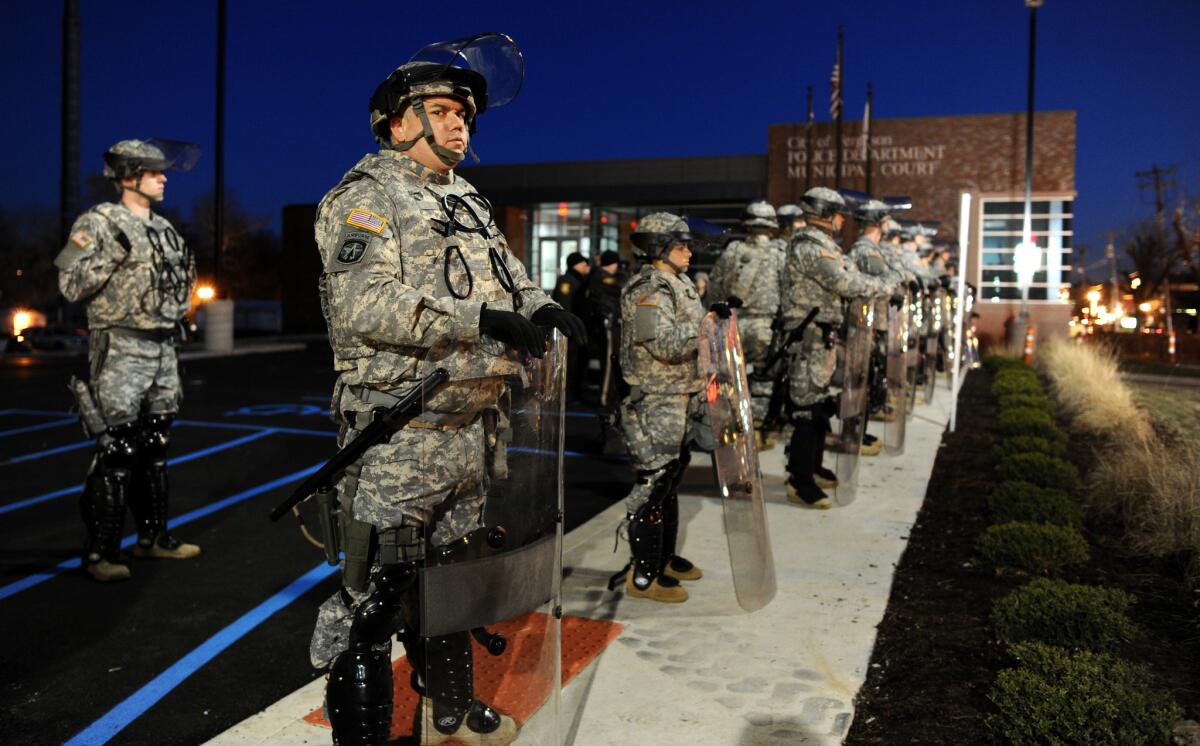
Wally Skalij / Los Angeles Times
The crowd outside the Ferguson Police Department headquarters has easily doubled in size over the last hour and retaken the street. Some protesters have begun to put hands in the faces of cameramen, pushing them back the same way police were pushing back the crowd earlier in the evening.
New York protesters try to disrupt commutes
In New York, the goal was to shut down traffic between Manhattan and New Jersey. Instead of heading directly north from Union Square to Times Square, the crowd pushed west toward the Lincoln Tunnel.
It succeeded for awhile. Police who had allowed them to march in the streets closed the tunnel to traffic as rush-hour drivers tried to creep home. But officers also prevented protesters from swarming into the tunnel, and within an hour, some traffic was again moving through it.
Later, marchers began taking over FDR Drive, which runs along the eastern edge of Manhattan. Traffic ground to a halt as police stood by, watching and waiting for the trouble that they hoped would not come.
Cops holding the line in Ferguson
Another attempt to shut down the 110
Timing of grand jury announcement is criticized
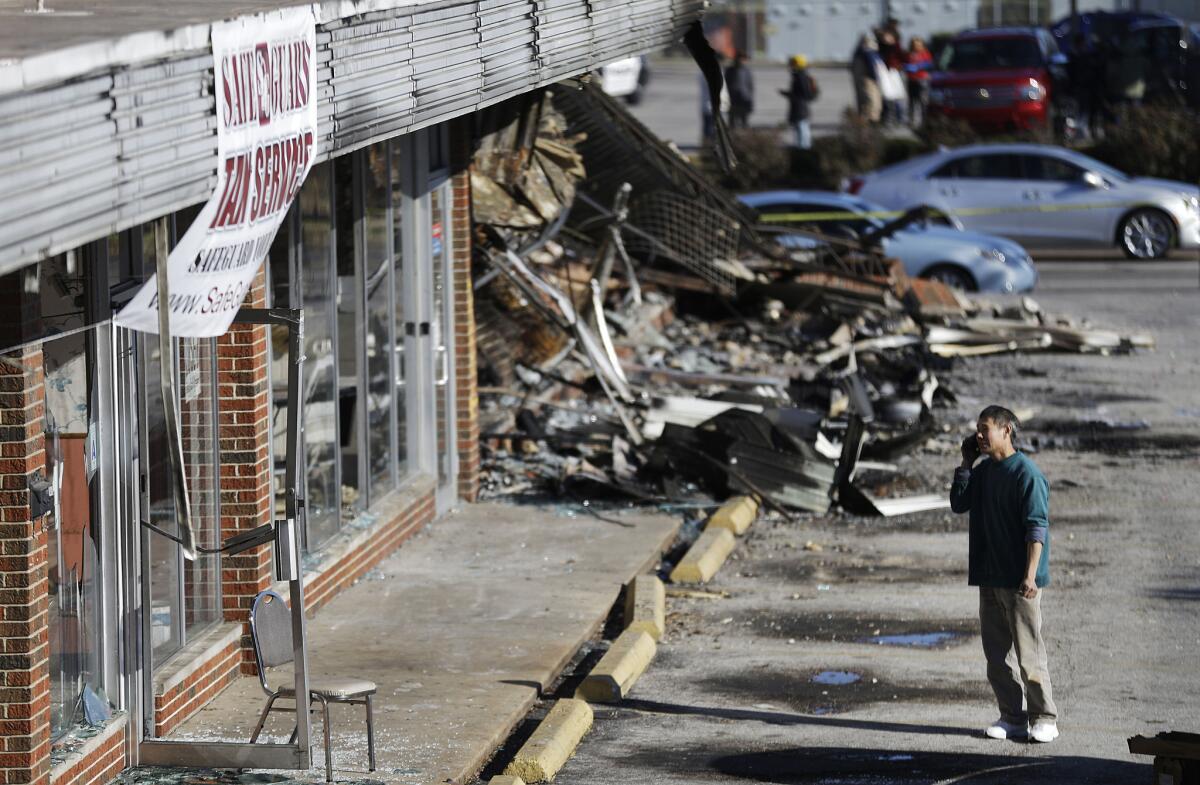
David Goldman / Associated Press
The St. Louis County prosecutor's choice to wait until nightfall Monday to announce the results of a grand jury investigation into Michael Brown's death put police at a disadvantage and offered agitators the cover of darkness, law enforcement experts and activists said.
“Of all the events and all that happened, the single event I am most hard-pressed to explain is why in the world it was announced at the time it was," said Wayne Fisher, a professor with the Police Institute at Rutgers University in Newark, N.J., and a former New Jersey assistant state attorney general.
"Announcing it in daylight would have given a tactical advantage to law enforcement officers when it came to dealing with whatever took place. Unless there was some reason I’m not aware of, I can’t think of any valid reason why the announcement was made at 8 p.m."
County prosecutor Robert McCulloch has not explained the timing.
In L.A., protesters come out for another night
Noisy protesters gather in front of police headquarters
About 100 noisy protesters gathered outside the Ferguson Police Department headquarters Tuesday night to oppose a St. Louis county grand jury's refusal to indict white officer Darren Wilson in the killing of an unarmed black man.
About 7:45 p.m., demonstrators moved into the street and blocked traffic.
A Brown cousin screamed at them to clear the street. "My cousin is already dead," she shouted.
Organizers cleared a space for vehicles and called on protesters to keep things peaceful.
Police in riot gear tackled and cuffed at least one person, angering the crowd.
Kyee Young of Kentucky desperately tried to keep the peace, and to keep fellow protesters out of the street.
"We want to do this as peacefully as possible," the college student said after the melee had calmed. "Civil disobedience is key, but peaceful civil disobedience gets more respect."
Tensions had calmed as of 8:10 p.m. But the crowd continued to taunt police officers, screaming, "They all look like Darren Wilson."
'Your president will work with you'
President Obama ramped up his administration’s response to the violence in Ferguson, Mo., saying Tuesday he had instructed top officials to hold regional meetings aimed at improving relations between police and distrustful communities.
Speaking at a rally in Chicago, Obama said Atty. Gen. Eric H. Holder Jr. would bring together state and local officials and religious and community leaders next week to talk about “specific steps” to improve race relations.
Obama said his administration would work on constructive solutions to what he described as frustrations “rooted in some hard truths.” But he condemned protesters who have reacted with violent outbursts to the police shooting of Michael Brown, an 18-year-old unarmed black man, and a grand jury's decision not to indict the white officer who killed him, Darren Wilson.
“Don’t take the short-term, easy route and just engage in destructive behavior. Take the long-term, hard, but lasting route of working with me and governors, state officials to bring about some real change,” Obama said. “And to those who think that what happened in Ferguson is an excuse for violence, I do not have any sympathy for that. I have no sympathy at all for destroying your own communities.
“Those who are prepared to work constructively, your president will work with you,” he said.
Darren Wilson's first public interview

In his first public interview since he shot and killed Michael Brown, Officer Darren Wilson told ABC's George Stephanopoulos that he is not haunted by his actions.
"The reason I have a clear conscience is that I know I did my job right."
When asked by Stephanopoulos if the tragic outcome would have been the same had Brown been white, Wilson said, "Yes...No question."
Wilson's final shot at Brown was to the man's head, a fact that concerned many critics of the deadly altercation.
"I fired, and what I saw was his head, and that's where it went."
In the excerpted interview - a longer version will air tonight on "Nightline" - Wilson repeated what he had told the grand jury: that Brown had leaned into his police car and punched him and that he felt overpowered by the heavier man. And he disputed earlier witness statements that he tried to pull Brown into his car. "That would be against every training ever taught."
The incident started, Wilson said, when he spotted Brown and his friend walking in the middle of the street and asked them to walk on the sidewalk. According to Wilson, Brown refused and asked him, "What the f- are you going to do about it?"
On trying to find a way forward
Protests begin anew in L.A.
Earlier in the day, it was quieter.
Darren Wilson speaks
ABC released a portion of George Stephanopoulos' interview with Officer Darren Wilson Tuesday afternoon. Among other things, Wilson said Michael Brown did not have his hands up.
More protests planned as night falls on Ferguson
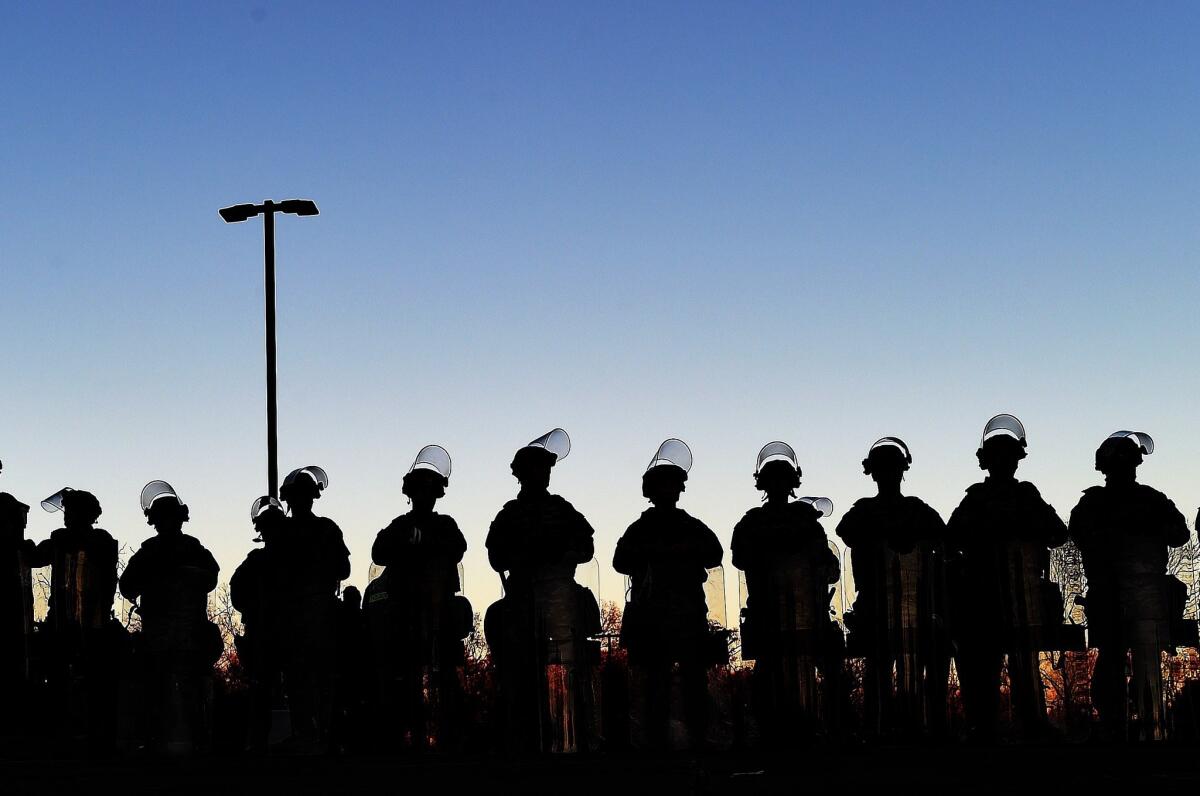
JEWEL SAMAD/AFP/Getty Images
The street that was the scene of fires, looting and gunshots early this morning is completely closed to vehicles and pedestrians.
West Florissant Avenue was completely empty as of 5:15 p.m. and police on the scene said the lockdown would not be lifted tonight.
Earlier in the day, police officials said they were treating the embattled street, which lines the block where Michael Brown was shot and killed by Officer Darren Wilson on Aug. 9, as a crime scene. Gov. Jay Nixon has also promised an increased presence from the National Guard.
Local activists said demonstrations were planned in Ferguson and the Shaw section of St. Louis on Tuesday night but it was unclear when or exactly where those would take place.
The largest protest of the day took place in downtown St. Louis, when hundreds marched through the streets and attempted to freeze traffic on the Martin Luther King Jr. Bridge, which connects Missouri and St. Louis.
Protesters said they were met with pepper spray and billy clubs though none were seriously injured. A St. Louis police spokesman said four people were arrested and charged with failure to disperse, and confirmed the use of pepper spray.
On what's to come
Michael Brown's stepfather: 'Burn this [place] down'
The stepfather of Michael Brown was the focus of some backlash Tuesday after a video showed him shouting at protesters, seemingly urging them to turn violent following a grand jury's decision not to indict the white police officer who killed his unarmed 18-year-old stepson.
"Burn this [expletive] down," Louis Head is heard shouting from atop a platform where he consoled Brown's mother, Lesley McSpadden. "Burn this [expletive] down."
The video was shot by a spectator in the crowd gathered outside the Ferguson police tation after the grand jury's decision. McSpadden briefly spoke out.
"I ain't never had to go through nothing like this," McSpadden said. Appearing angry and grief-stricken, she then covered her face with her hands and sobbed.
Head, wearing a T-shirt saying "I am Michael Brown," moved to embrace her. Then he faced the crowd and shouted.
Darren Wilson still on paid leave, Ferguson mayor says
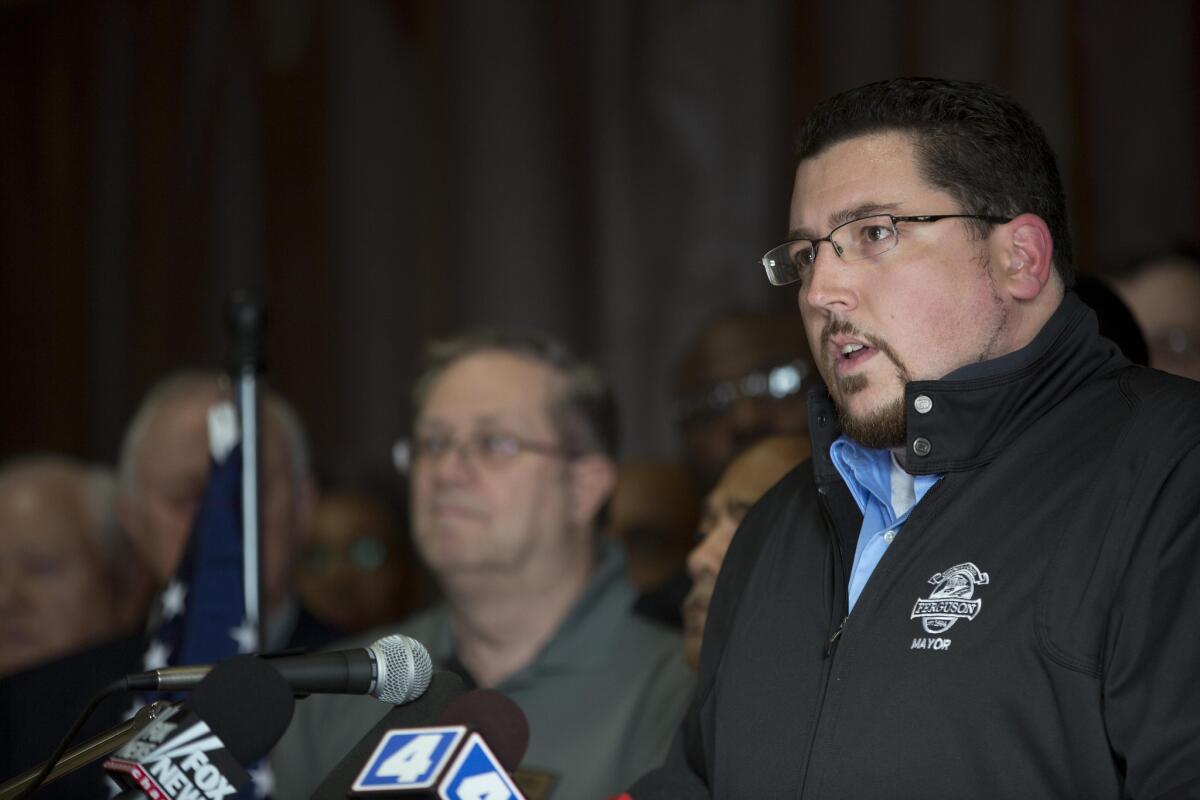
Aaron P. Bernstein / Getty Images
Ferguson Mayor James Knowles told attendees at a Tuesday press conference that "no decision has been made" regarding Darren Wilson's job with the Ferguson Police Department, and that his "current employment has not changed." Wilson has been on paid administrative leave since he fatally shot unarmed teen Michael Brown in August.
Knowles added that any decision on Wilson's employment is pending the results of an internal investigation from the Ferguson Police Department. The U.S. Department of Justice is also currently conducting an investigation into the incident.
A CNN report last week said Wilson was in "the final stages" of negotiations with city officials to resign, citing anonymous sources "close to the talks."
An investigator examines the body amid an agitated crowd
An investigator with the St. Louis County medical examiner's office first arrived on the scene about two hours after Brown died. By then, the investigator, and the first witness to testify, said the crowd on Canfield was agitated, demanding to know why Brown's body had been lying on the hot pavement for long. Below are excerpts from testimony given by the investigator.
How the L.A. freeway became a stage
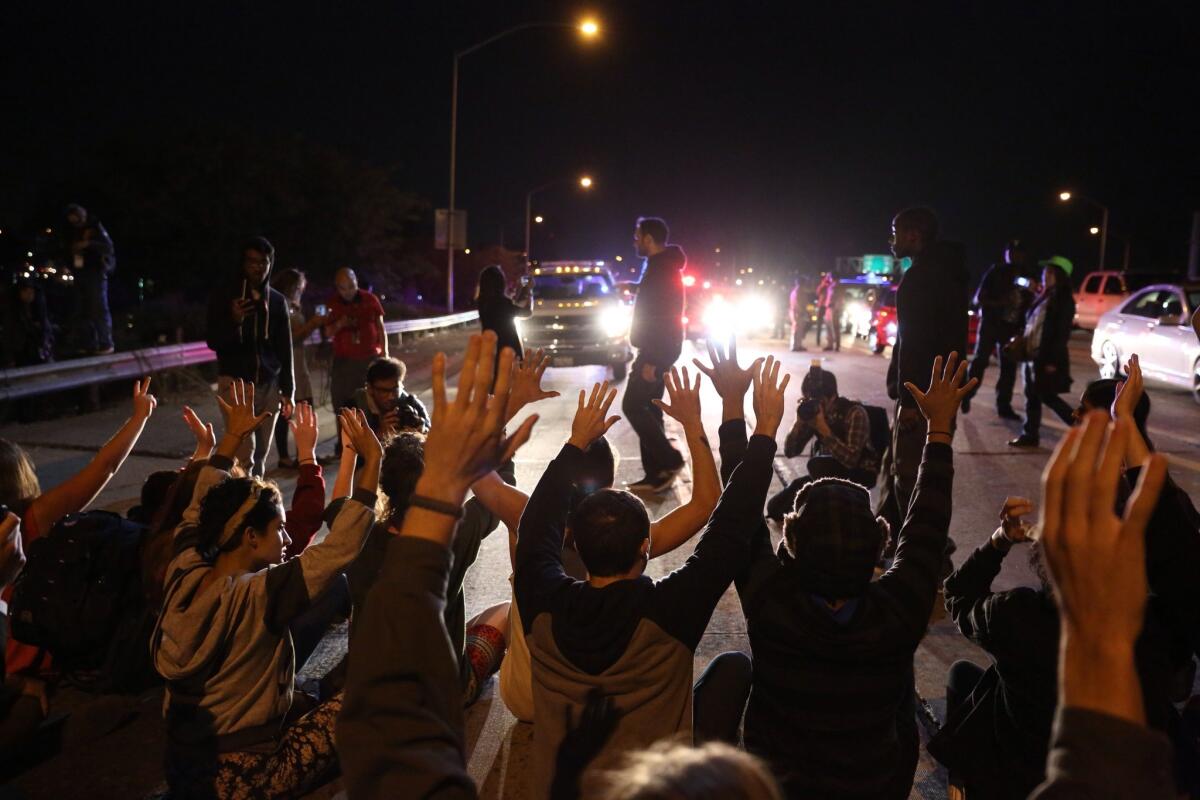
Marcus Yam / Los Angeles Times
About half an hour before midnight, protesters angry over the Ferguson grand jury decision pushed down a chain-link fence, climbed a dirt hill and walked onto one of the great symbols of Southern California: the freeway.
More than 100 men and women walked onto Interstate 110, where they unfurled a sign using an expletive to express their feelings about police.
With suddenly-blinkered red tail lights, traffic came to a stop -- not for the first time and certainly not for the last on a freeway during an L.A. protest.
This is how to bring a freeway to a stop.
Gov. Jay Nixon: 'No one should have to live like this'
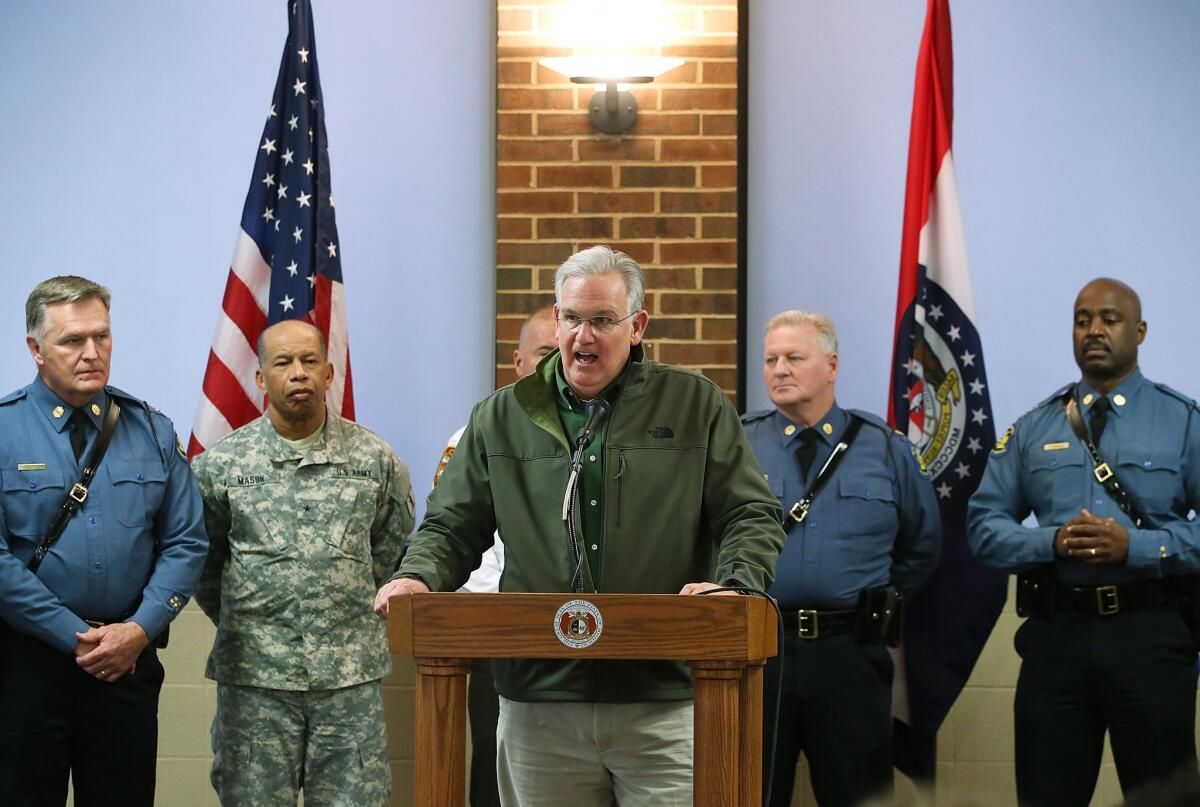
Justin Sullivan / Getty Images
In a press conference Tuesday, Gov. Jay Nixon condemned violent protesters who torched buildings, fired off guns, and vandalized and looted local businesses, calling them "criminals intent on lawlessness and destruction" who "terrorized" the community Monday night.
He described the current situation along Florissant Avenue, where much of the destruction occurred, saying senior citizens are afraid to leave their homes and children, home after schools were canceled, are too scared to play outside.
Col. Ronald Replogle with the Missouri State Highway Patrol called Monday’s unrest “a disaster" and Nixon said it was a “testament to the professionalism” of law enforcement officials that no one was killed or seriously injured in the protests.
The governor said lives and property must be protected, and promised a “ramped-up” National Guard presence Tuesday, ordering hundreds of additional troops to the area.
Asked whether his order for additional troops had anything to do with pressure from President Obama, Gov. Nixon responded forcefully: “Politics has not one bit to do with the task at hand … and the seriousness of this mission,” he said.
Marchers say they were met with pepper spray on bridge
A throng of at least 200 protesters upset over the decision not to indict Darren Wilson say they were met with pepper spray and billy clubs when they tried to march across a bridge at the Missouri-Illinois border on Tuesday.
The marchers were led by the activist group Hands Up, which formed after the shooting death of Michael Brown. They began their demonstrations in downtown St. Louis around noon, according to Darian Wigfall, a 33-year-old St. Louis native who described himself as a low-level organizer within the group.
When the marchers reached the ramp to the Martin Luther King Jr. Bridge, they were met by a swarm of St. Louis police officers. They were ordered to disperse, but refused, and we're hit with chemical sprays and billy clubs, according to Wigfall and Talal Ahmed, who still had white pepper spray residue on his face.
Wigfall said the protest was peaceful, especially when compared to the violence that erupted in Ferguson after prosecutors announced the grand jury's findings Monday night, and he said he couldn't understand the reaction of police officers.
"It feels like we're being targeted just like all of the young black men who have been killed by police," Wigfall said.
It was unclear if anyone was arrested. Wigfall said no one was seriously injured but several protesters needed help to wash pepper spray from their eyes.
Ahmed, also 33 and from St. Louis, said the movement has gone far beyond Brown's death now. We haven't been able to reach police for comment yet.
More National Guard on the way
More National Guard troops needed
Missouri Gov. Jay Nixon on Tuesday said he is sending more National Guard troops to the St. Louis region to bolster security after a night of rioting and looting in Ferguson.
“The violence we saw in areas of Ferguson last night is unacceptable,” Nixon said in an email sent to reporters. “That is why today I am meeting with leaders from the Guard and law enforcement to ensure the protection of lives and property.”
Nixon’s announcement comes amid criticism that the Guard was not available Monday night.
“The National Guard was not deployed in enough time to protect all of our citizens,” Ferguson mayor James Knowles told reporters at an afternoon news conference. “We are asking the governor to deploy the Guard to protect our people.”
Michael Brown's marijuana use that day
A toxicology expert testified that Michael Brown had 12 nanogram per milliliter of THC in his blood and at that level the drug was having an affect on him. But, the toxicologist said, not everyone will relaxed from marijuana.
Ferguson officials talk about aftermath
'Then you just heard the rest of the shots'
An unnamed witness describes the moments leading up to the fatal shooting. Prior to this exchange, the witness testified to hearing the sound of metal hitting concrete and thinking that Michael Brown might have had a gun.
The presentation of evidence to a St. Louis County grand jury was deeply flawed, leading to a wrong decision not to charge a white police officer who fatally shot Michael Brown, an unarmed black man, lawyers for the slain man’s family said on Tuesday.
“This process is broken,” said lawyer Benjamin Crump. “The process should be indicted.”
Flanked by Michael Brown’s parents, Lesley McSpadden and Michael Brown Sr., Crump, lawyer Anthony Gray and civil rights activist and television personality the Rev. Al Sharpton sharply condemned St.
Louis County Prosecuting Attorney Robert McCulloch for how he presented the case to the grand jury and how and when he announced the jury's findings Monday night.
All pledged more action in the courts and through protests around the country.
“We took a blow last night and some people think it was a fixed fight,” Crump said. “This process was supposed to create clarity, but didn’t it raise more questions?”
Brown and McSpadden had been expected to speak at the news conference, but did not address the media because they were overcome by emotion, Crump said.
George Stephanopoulos has interviewed Darren Wilson
Witness says tragedy didn't have to happen
This unnamed witness does not have positive feelings for the police. In testimony, the witness said Michael Brown put the officer in defensive situation.
Al Sharpton on violence in Ferguson
Here's what police say they saw last night
Watch live: Michael Brown's family, Al Sharpton speak
Update on the injured
The Associated Press is reporting least 14 people were injured during the overnight protests, including two people who were admitted to Barnes-Jewish Hospital for treatment of undisclosed injuries. That hospital treated and released five people. Six others were treated for minor injuries at Christian Hospital, near Ferguson. Saint Louis University Hospital treated and released another.
Christine Ewings, 46, left, and her son Daryus Watson, 16, right, talk in Ferguson, Mo., in August. (Molly Hennessy-Fiske/Los Angeles Times)
Christine Ewings, 46, awoke Tuesday still upset and frustrated. Ewings, a cousin of Michael Brown, had watched the grand jury's decision not to indict police officer Darren Wilson with Brown’s grandmother in Ferguson. Overnight, looting left her neighborhood a mess.
"The moral and spirits of the black race has been broken and what are they gonna do about it ? NOTHING!" she said.
"It is all an illusion that justice is for all. We get what crumbs they sweep from the table and that is all! I am really hurt! And I feel worst than a dog out on the street. They could have and should have brought it to trial. The prosecutor himself said that their were a lot of discrepancy. Didn't my little cousin's life deserve a chance to be examined? Evidently not!"
Broken windows, helping hands
Matt Pearce / Los Angeles Times
A volunteer cleans up Snappy's Bar and Grill on Florissant Avenue in Ferguson Tuesday morning. The area was hard-hit by looters in the protests that followed Monday night's grand jury decision.
Former Ferguson mayor says city should have been sealed off
Brian Fletcher, who is now chair of the I Love Ferguson committee and gave several interviews this morning, told KMOV "Anyone with any intelligence could understand the frustration and anger underlying here. The city should have been sealed off by the National Guard, and only those with a reason to be here should have been here during the announcement.”
He added that it “didn’t make sense” to make the announcement in the evening hours, after dark.
He was particularly critical of Missouri Gov. Jay Nixon.
“The governor did not prepare for the worst. He failed the city and the state miserably.”
A 'crime scene'
Search through the grand jury documents
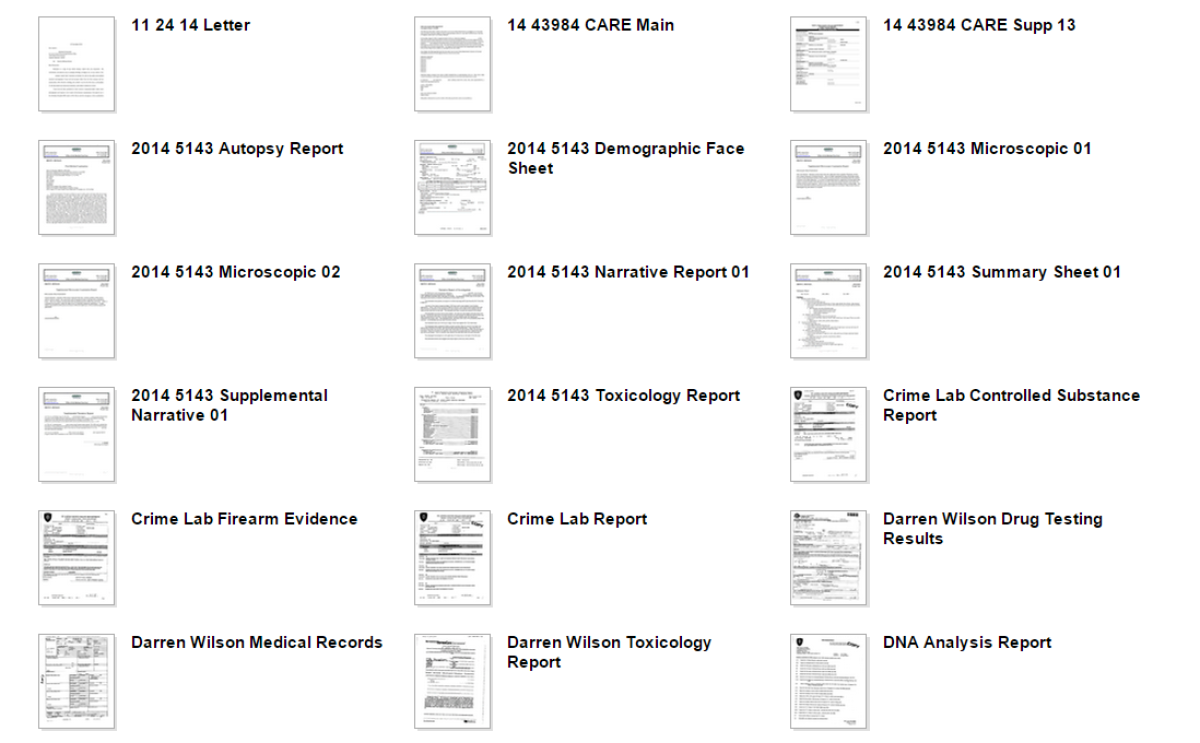
St. Louis County prosecutor Robert McCulloch released thousands of pages of police interviews, autopsy reports and secret grand jury testimony.
L.A. Times reporters are poring over the documents now and you can also search the coroner reports, witness testimony and see the evidence the grand jury saw.
St. Louis residents woke up to this front page
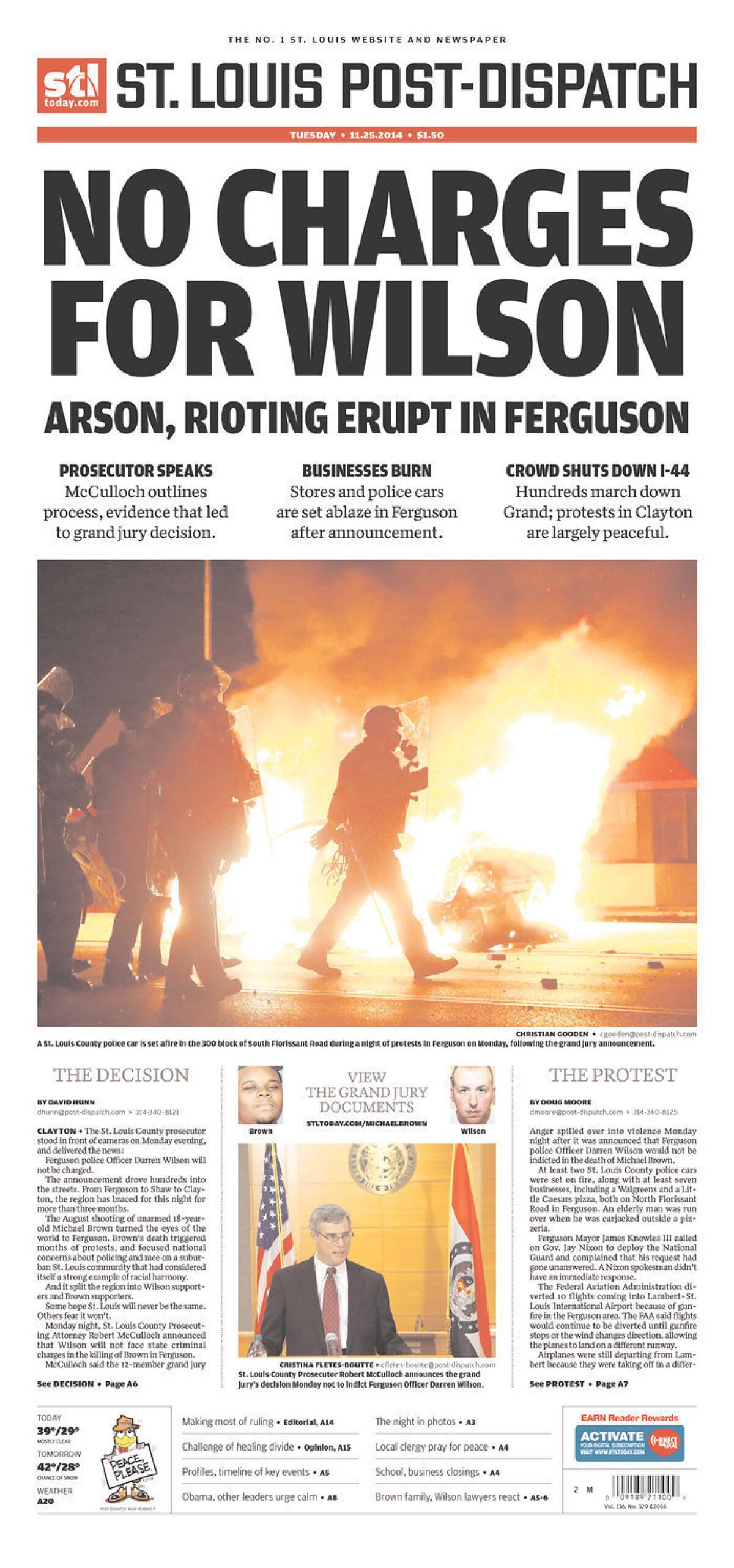
St. Louis Post Dispatch / Newseum
In St. Louis, the Post-Dispatch front page was all about the grand jury and the aftermath of the decision to file no charges.
News from Ferguson dominated the front pages of papers across the U.S. See how the story played out via the Newseum's front page archive.
Darren Wilson had never fired his weapon before
It started with a simple request — "will you just walk on the sidewalk?" Forty-five seconds later, Michael Brown lay sprawled on the street, shot dead by a police officer who had never before drawn his gun in the line of duty.
And as he drove away from the 18-year-old's body, heading to the Ferguson police station to wash Brown's blood from his hands and surrender his gun, all Officer Darren Wilson could think was, "I'm just kind of in shock of what just happened. I really didn't believe it."
Wilson's terror and panic were plain to see in 90 pages of his testimony before the grand jury on Sept. 16.
Brown, he said, looked like a "demon."
When Wilson drew his gun from inside his car and told Brown to get back or he would shoot, the officer said, "he immediately grabs my gun and says, 'You are too much of a [expletive] to shoot me.' "
Wilson ultimately got out of the car, and Brown began to run away. Then he stopped. And turned. And began to run back toward the officer. He made a fist with his left hand and reached under his shirt with his right. Wilson testified that he kept telling him to get on the ground. Brown didn't.
"I shoot a series of shots," Wilson said. "I don't know how many I shot, I just know I shot it."
Later in front of the grand jury, Wilson was asked whether he had ever had to use excessive force in the line of duty before Aug. 9.
"I've never used my weapon before," he replied.
In the morning light
Overnight toll: 61 arrests in Ferguson, dozen buildings burned
In an early morning conference held while flames still sprouted out of some cars and buildings in Ferguson, St. Louis County Police Chief Jon Belmar said Monday night's unrest exceeded what happened in August after Ferguson police Officer Darren Wilson killed Michael Brown on Aug. 9.
At least a dozen buildings were burned and 61 people arrested during the violence and chaos in Ferguson, Mo., that followed a St. Louis County grand jury's decision not to indict a white police officer in the killing of an unarmed black man, police said early Tuesday. At least 21 more people were arrested in St. Louis.
Suspected charges for the arrested included arson, burglary, possession of stolen property, unlawful possession of a firearm, and unlawful assembly, according to the St. Louis County Police Department. Only nine of the arrestees were from Ferguson.
Here's what happened Monday
A grand jury’s decision to not indict a Ferguson, Mo., police officer in the shooting death of a young black man touched off angry and sometimes volatile protests across the nation Monday night, and authorities prepared to prevent further unrest from spreading Tuesday.
Missouri Gov. Jay Nixon ordered more National Guardsmen to Ferguson, the St. Louis suburb where at least a dozen buildings were set on fire Monday. St. Louis County police Chief Jon Belmar said early Tuesday that two county police cars were set ablaze — “basically melted” — and that 29 arrests were made. He said he personally heard about 150 gunshots.
The grand jury found there was no cause to charge Officer Darren Wilson with a crime in the shooting death of 18-year-old Michael Brown on Aug. 9. Defenders see Brown as a victim of police abuse, but multiple people who testified before the grand jury portrayed him as the aggressor in the fatal encounter.
The U.S. Justice Department's civil rights division, meanwhile, is continuing with two investigations into Brown’s death.
Live coverage resumes in the morning
It has been an intense night of violent protests as people in Ferguson, Mo., reacted to a grand jury decision to not indict Officer Darren Wilson. We’re going to take a break from our live updates but will be back at 5:30 a.m. PT to continue covering reaction and developments out of Ferguson and elsewhere.
Bricks thrown at officers
'I didn't foresee an evening like this'
After several hours of unrest in Ferguson and the larger St. Louis area, St. Louis County police Chief Jon Belmar tallied the night’s damages.
At least a dozen buildings were set on fire, and most of them were total losses, he said. Two county police cars were “basically melted.” Twenty-nine arrests were made. And he personally heard about 150 shots fired.
On the bright side, no shots were fired by police, he said, and there was no loss of life.
“What I’ve seen tonight is probably much worse than the worst night we had in August,” he told reporters, later adding, “I didn’t foresee an evening like this.”
One reason the situation got out of hand was that police were so busy dealing with the fires, they couldn’t lock down access to Ferguson's West Florissant Avenue from all directions, Belmar told the Los Angeles Times.
--Lauren Raab and James Queally
Black community hardest hit
All of the fires and the looting in Ferguson Missouri this evening have taken place in the African-American community and nowhere else.
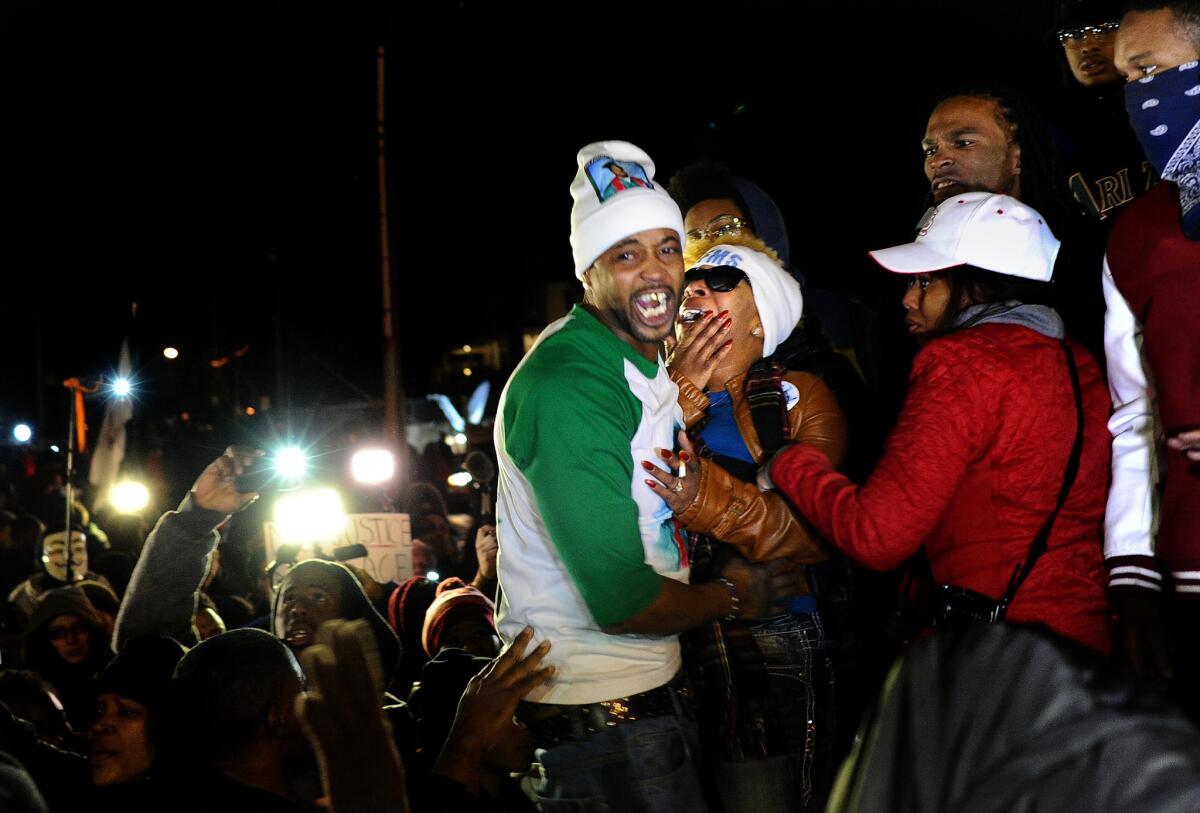
Wally Skalij / Los Angeles Times
More National Guard on the way
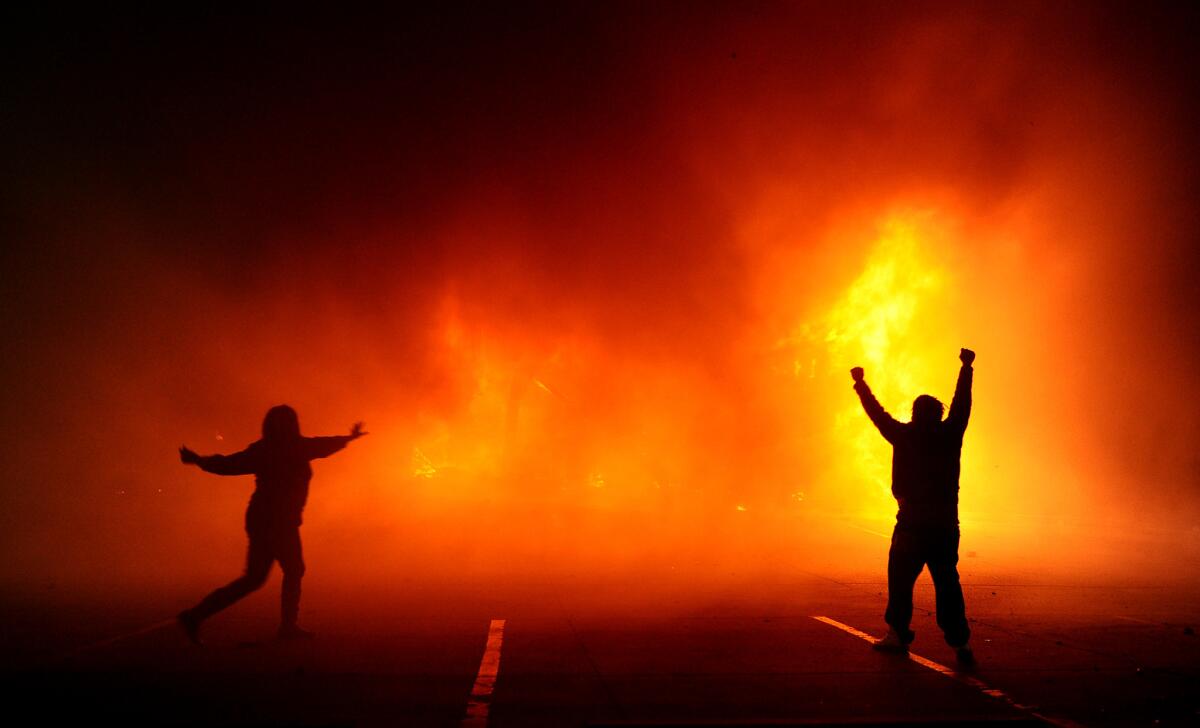
Wally Skalij / Los Angeles Times
Missouri Gov. Jay Nixon ordered more National Guardsmen to Ferguson in the wake of a grand jury’s refusal to indict white police officer Darren Wilson in the killing of Michael Brown, an unarmed black man.
“The Guard is providing security at the Ferguson Police Department, which will allow additional law enforcement officers to protect the public,” the governor’s office announced early Tuesday.
Violence broke out Monday night after the grand jury’s decision was announced, and it continued into the early morning hours.
At least a dozen buildings were set afire, officials said.
Jon Belmar, the St. Louis County police chief, told reporters that he heard at least 150 gunshots. “I didn’t see a lot of peaceful protests out here,” he said.
Read earlier updates
Continue reading updates from the first day of the grand jury decision.
Sign up for Essential California
The most important California stories and recommendations in your inbox every morning.
You may occasionally receive promotional content from the Los Angeles Times.
